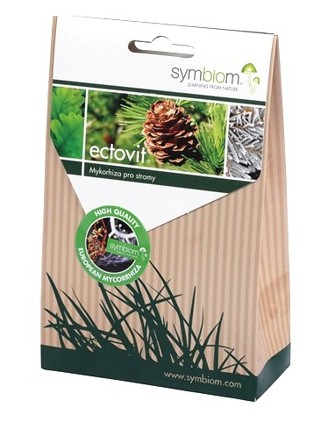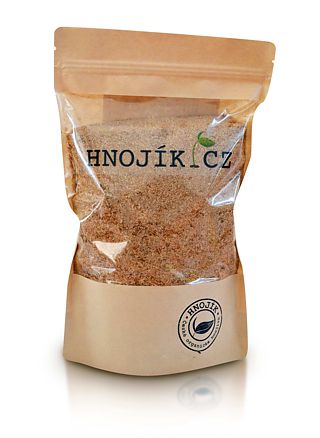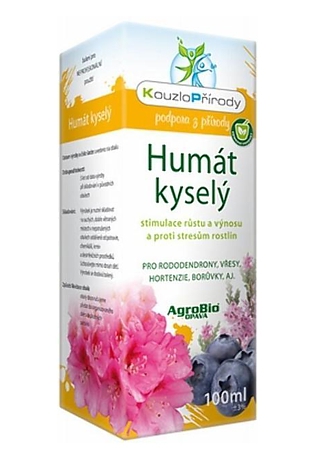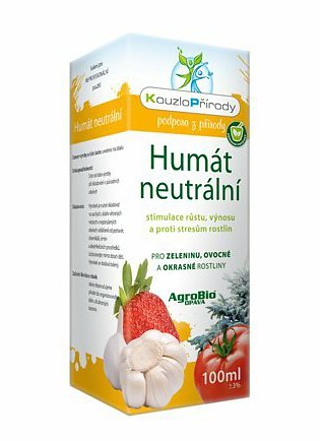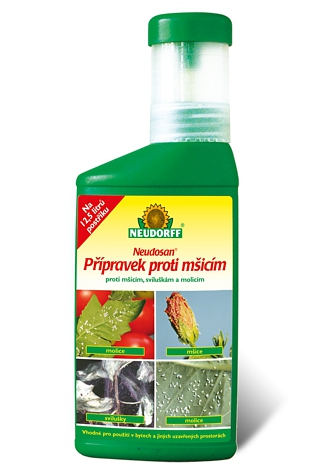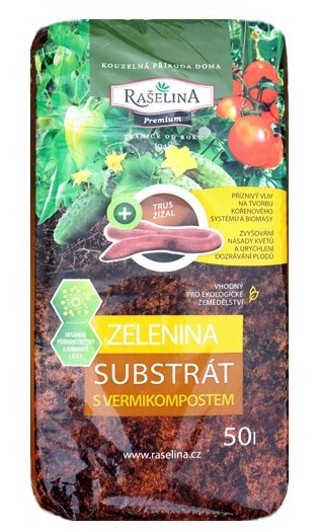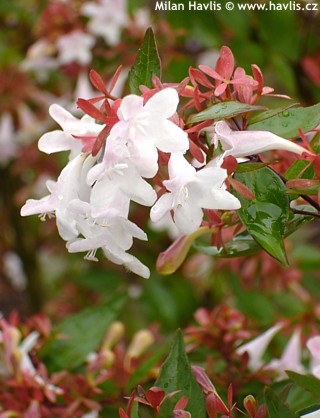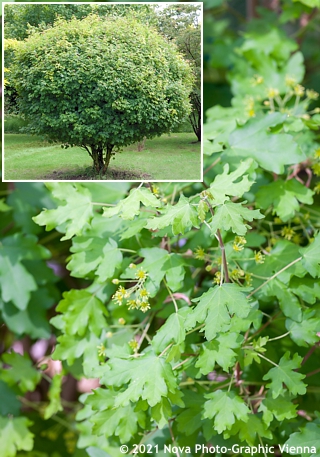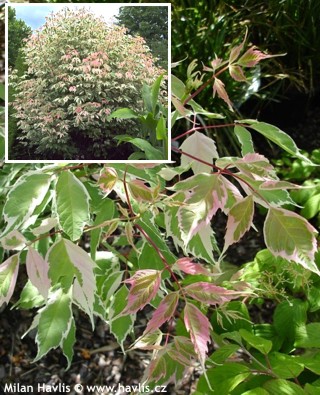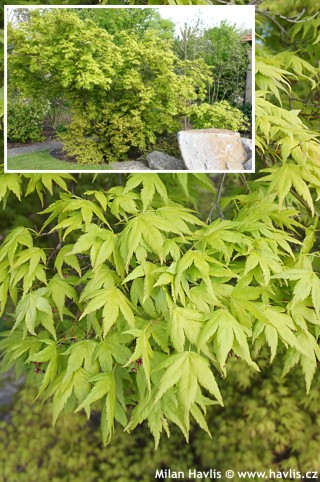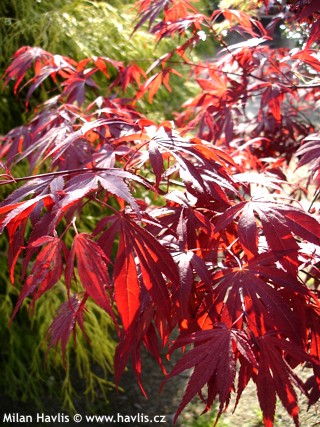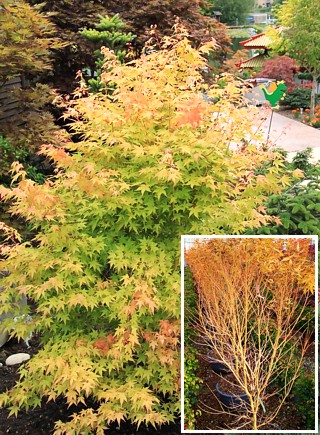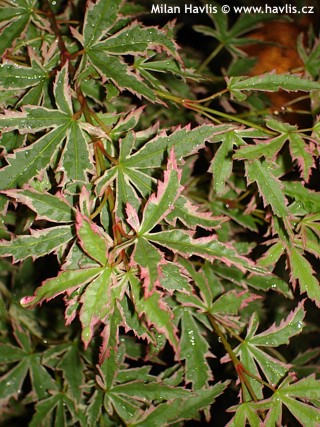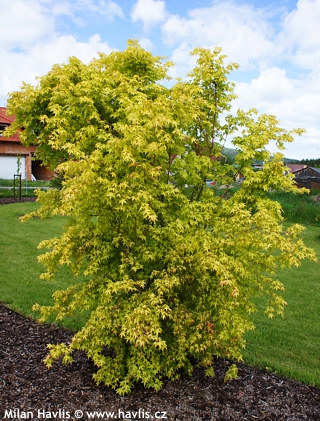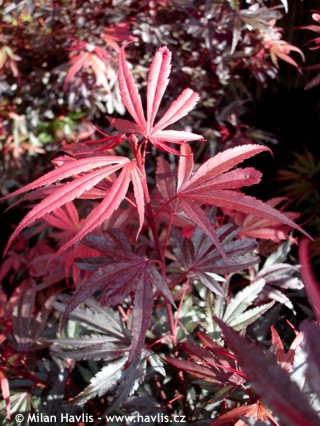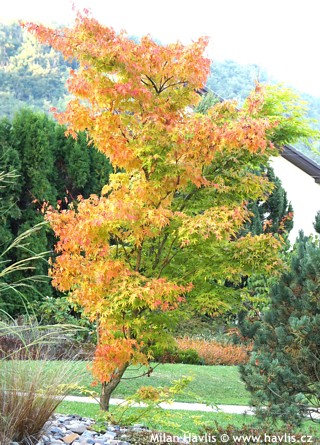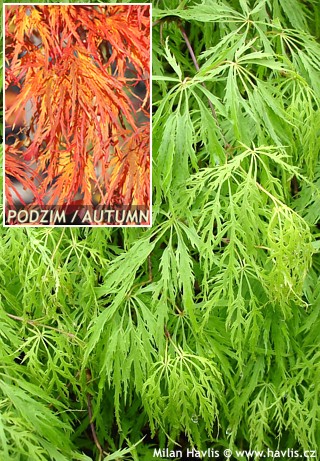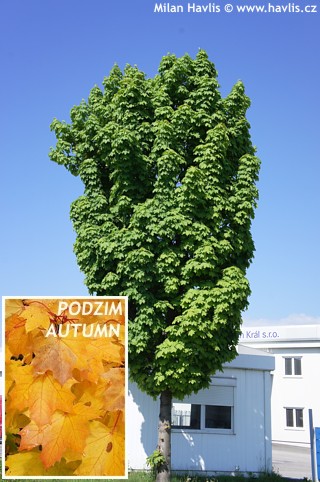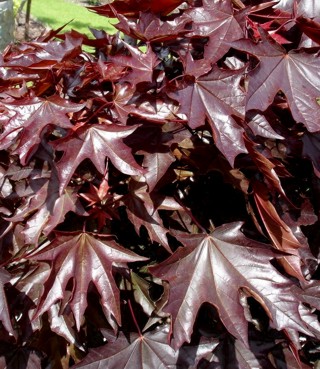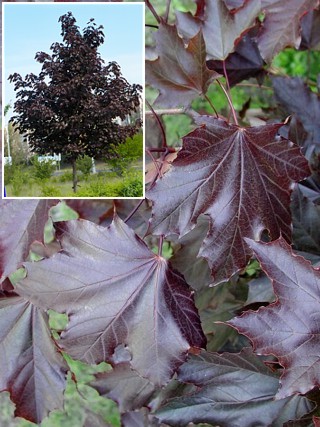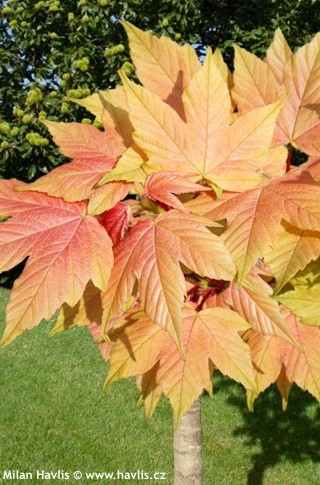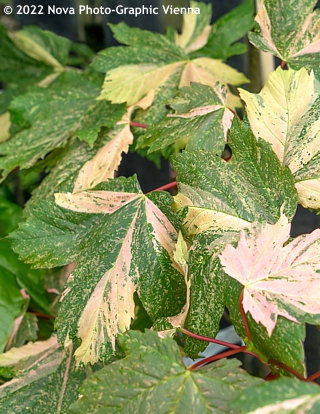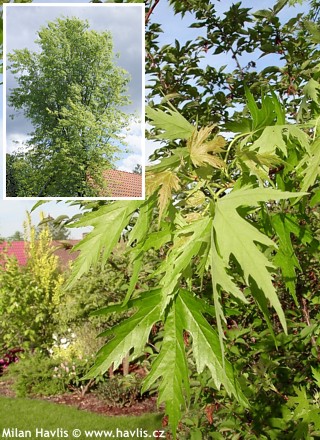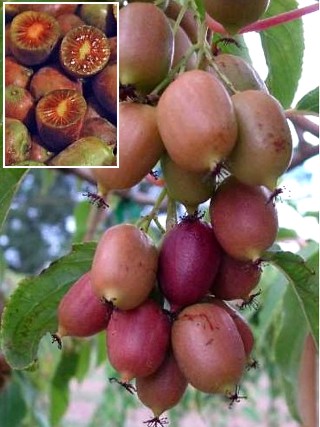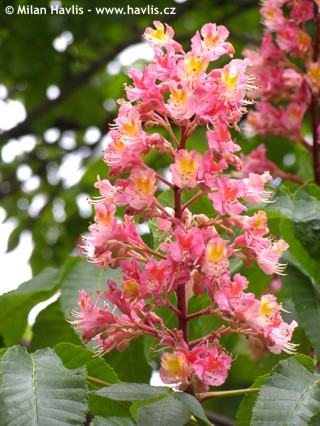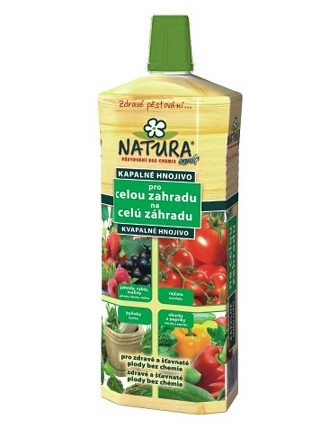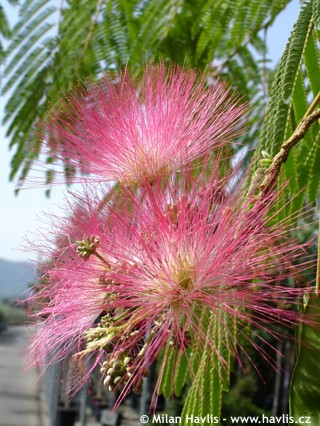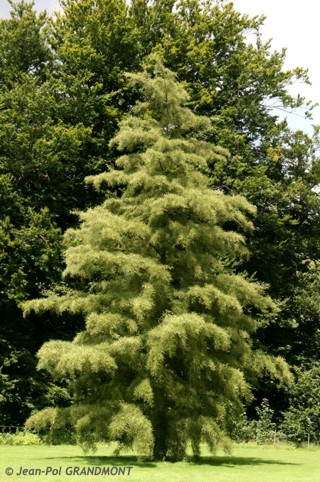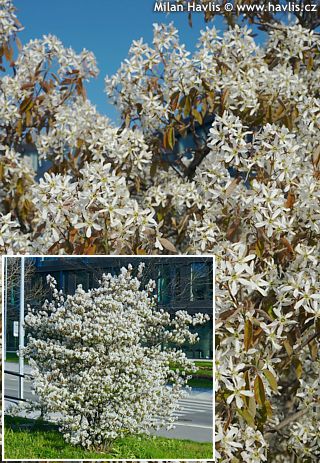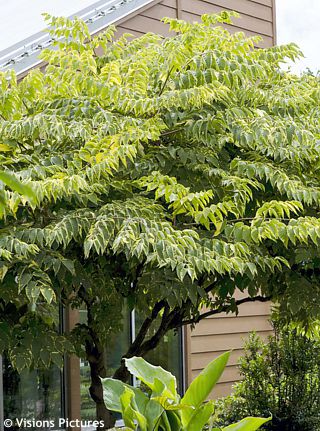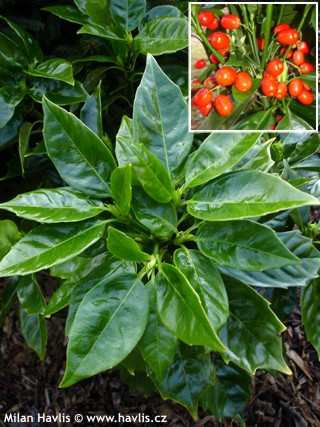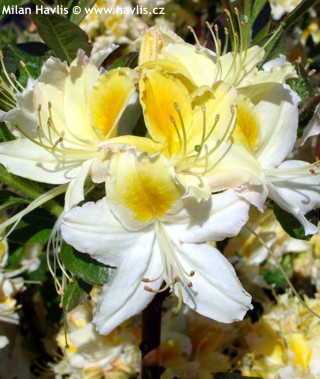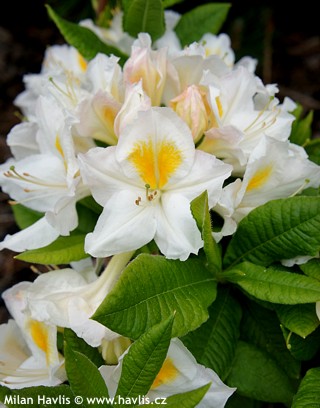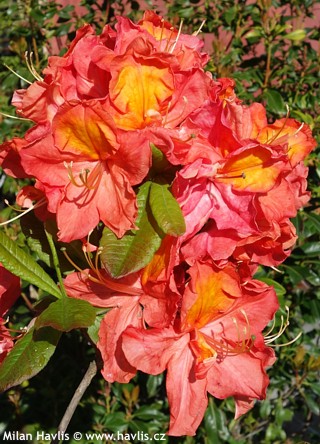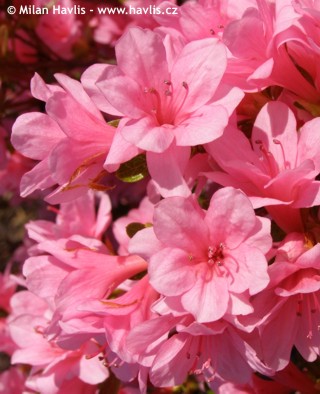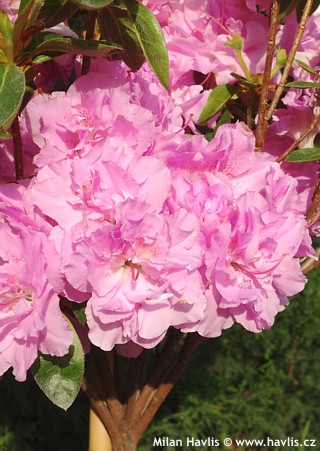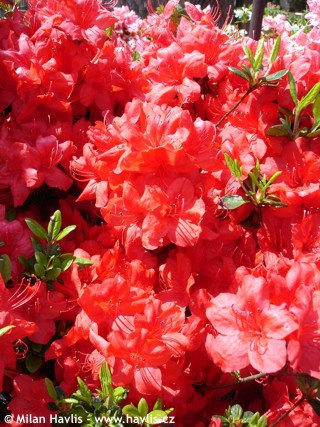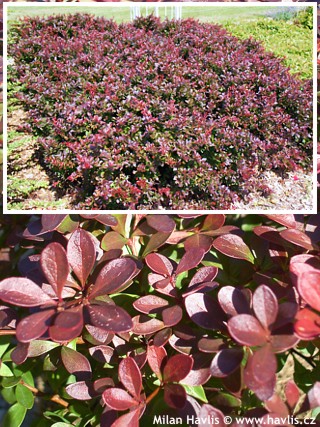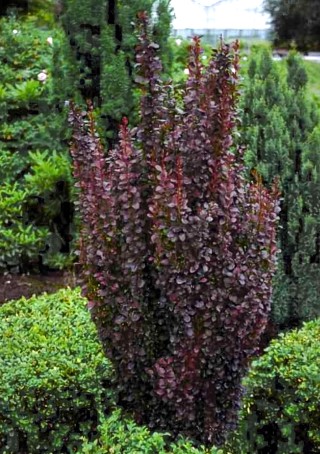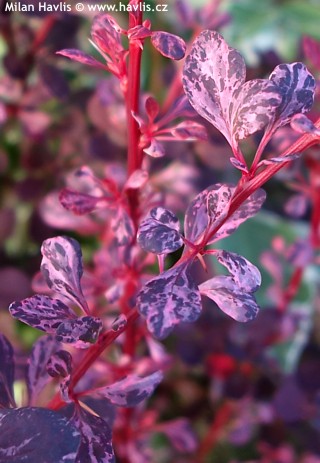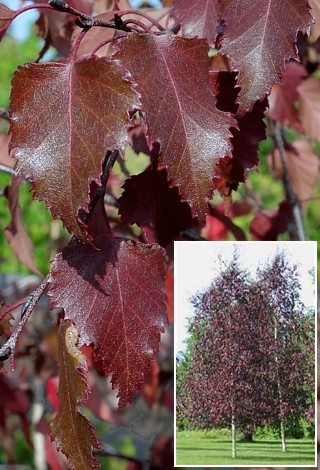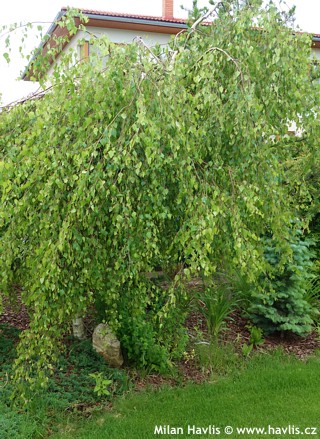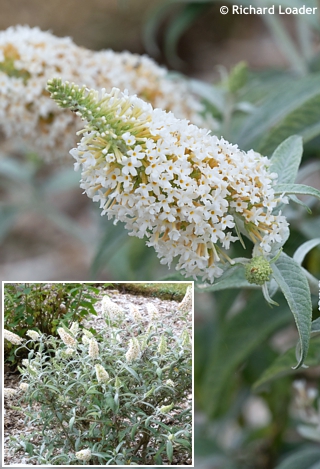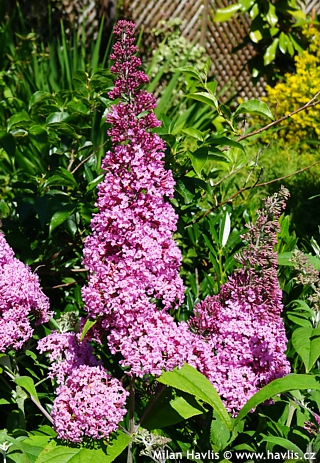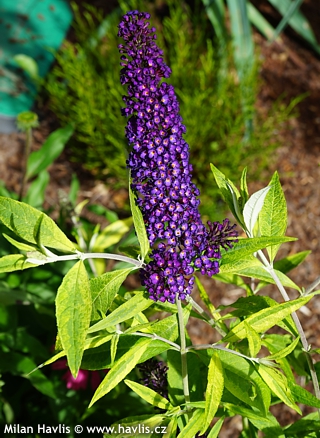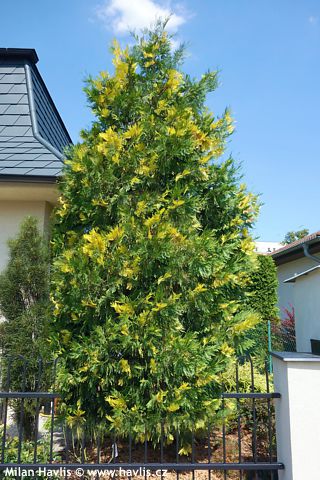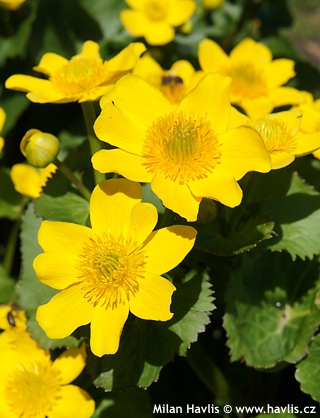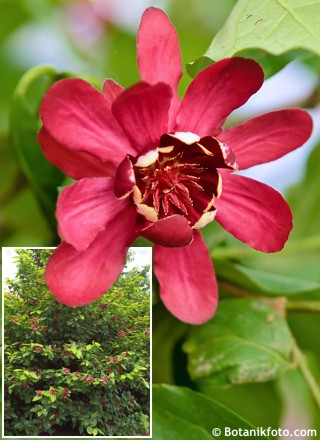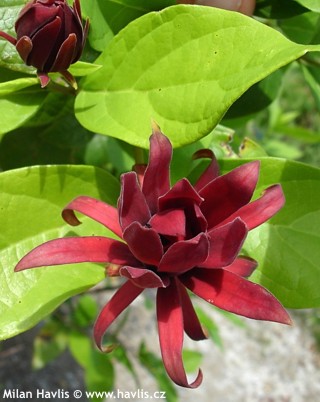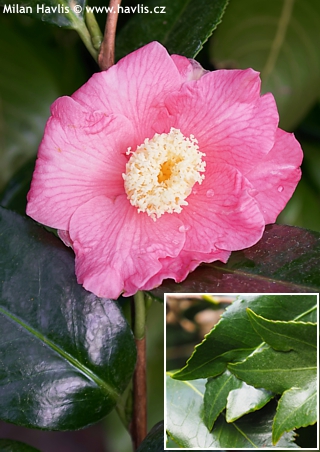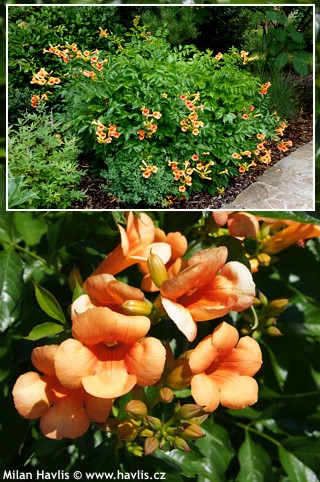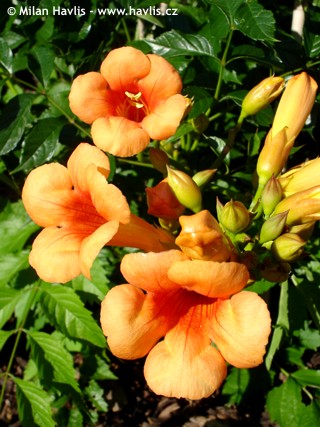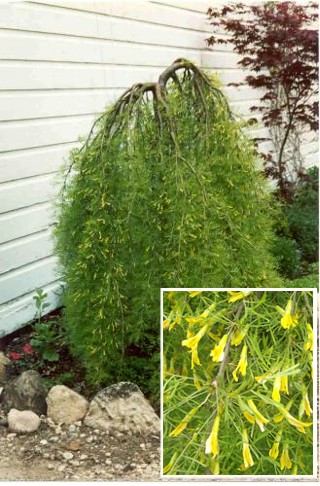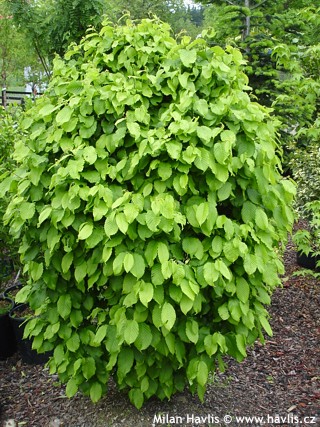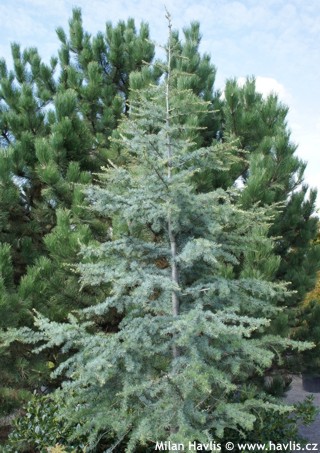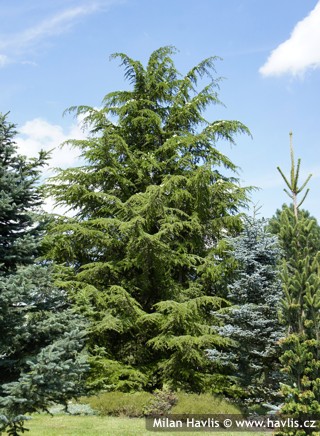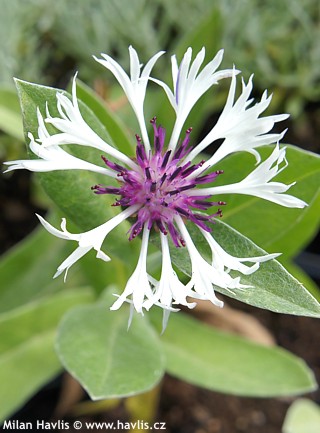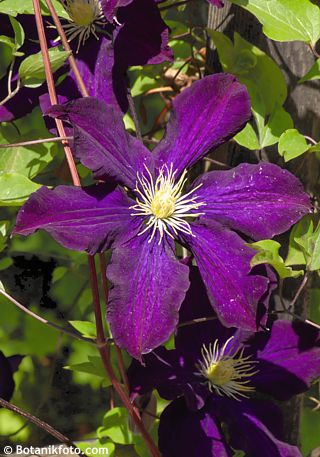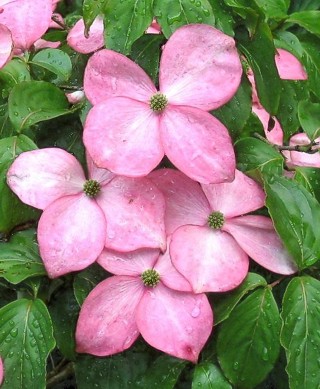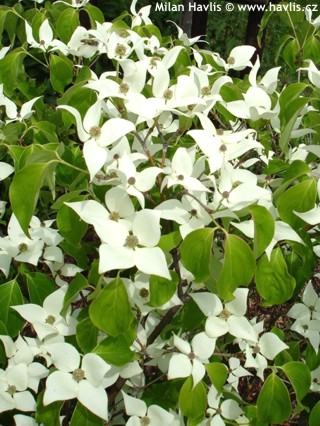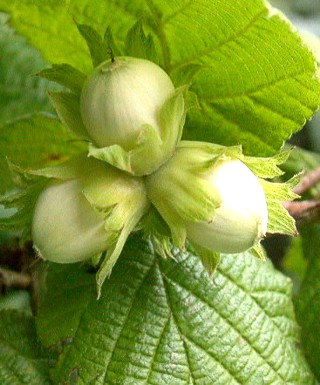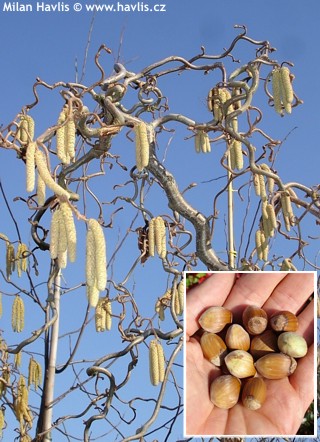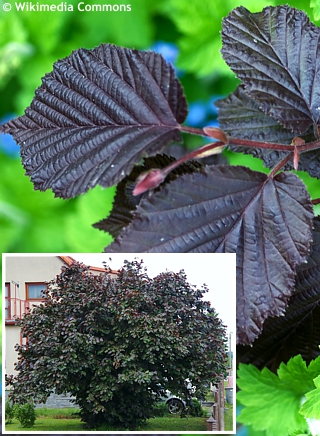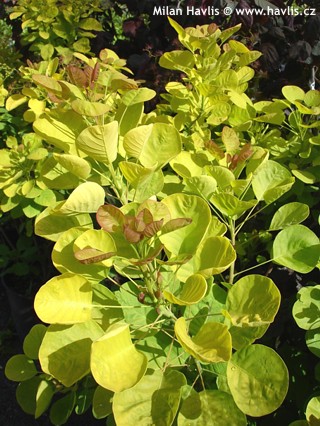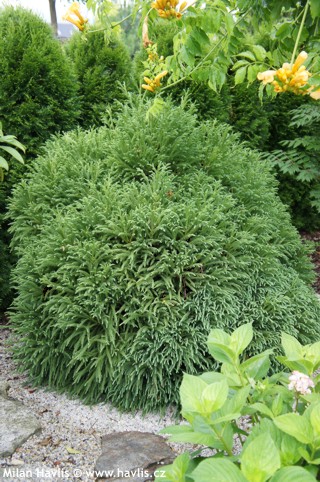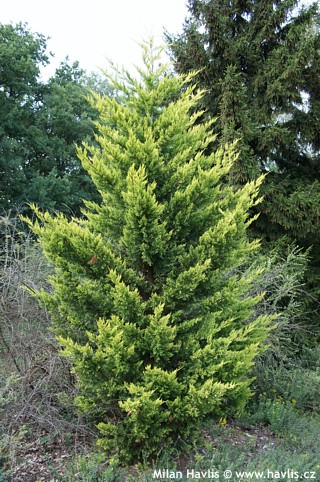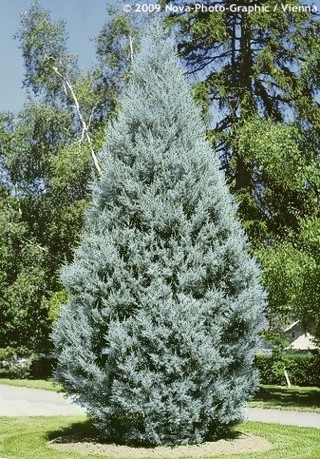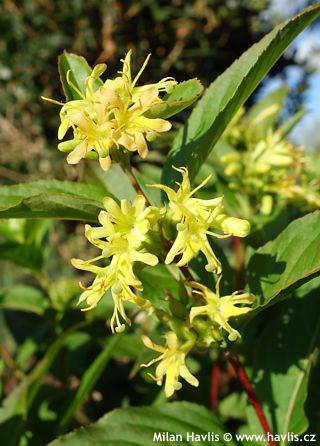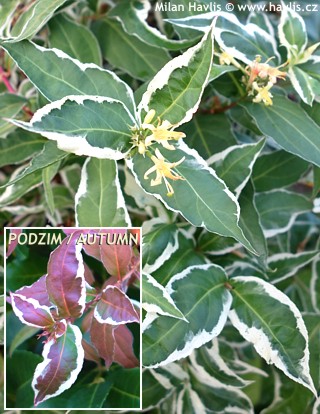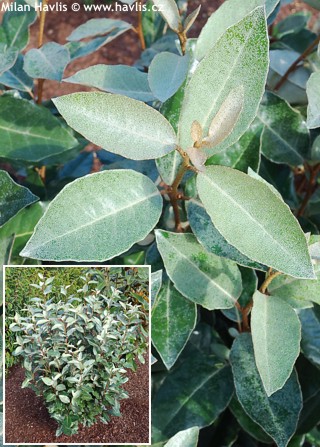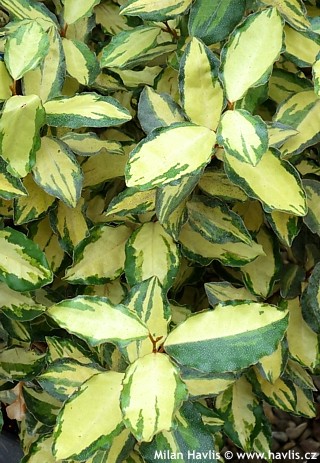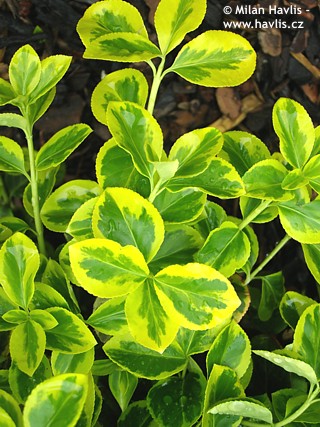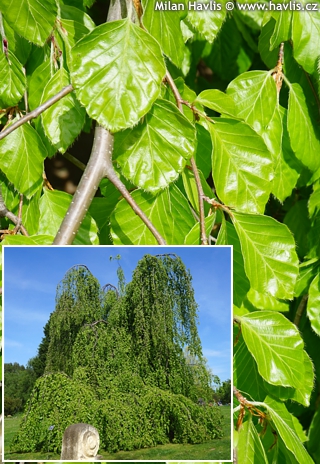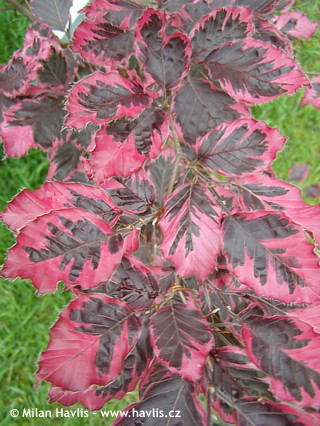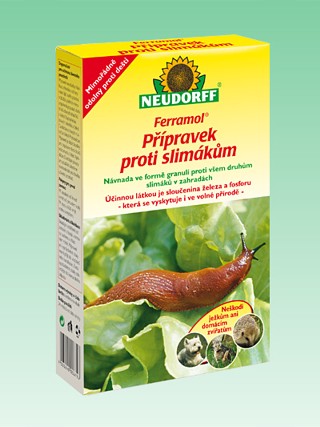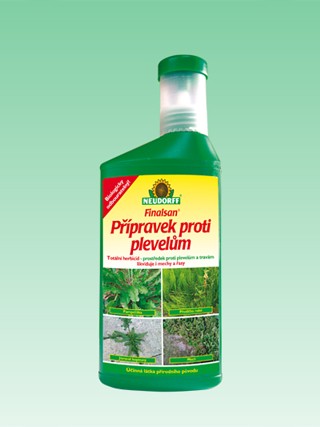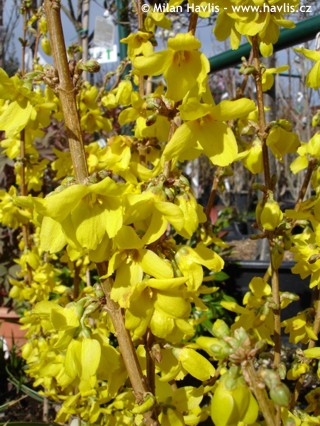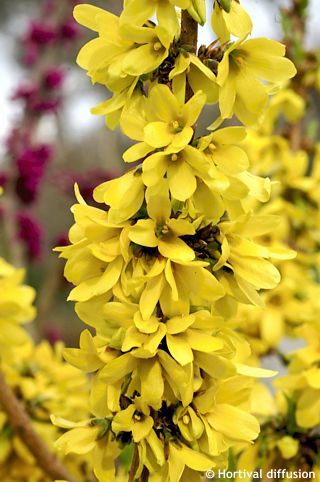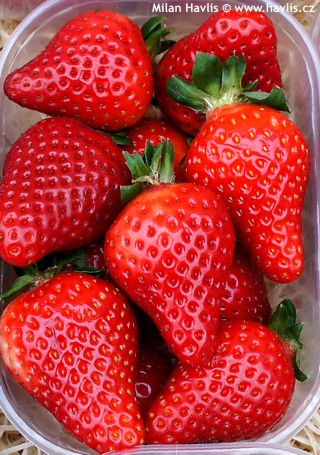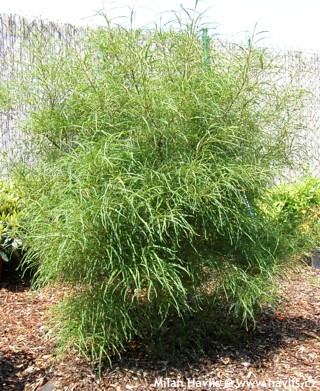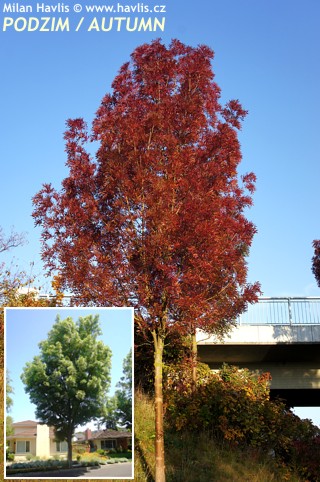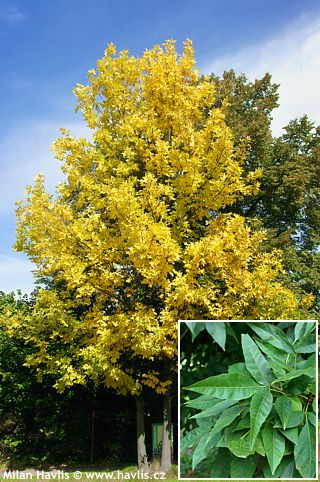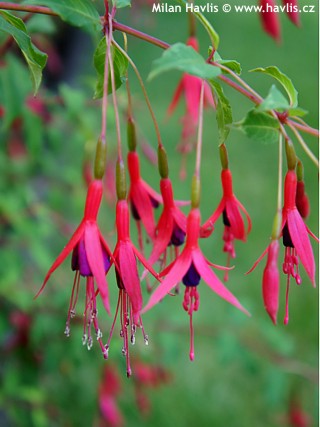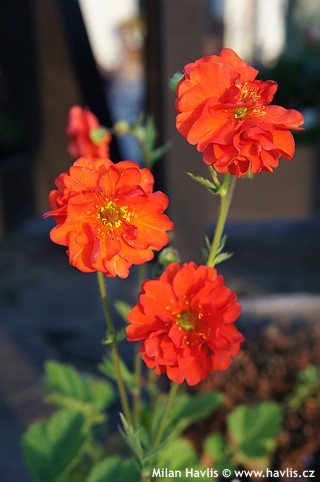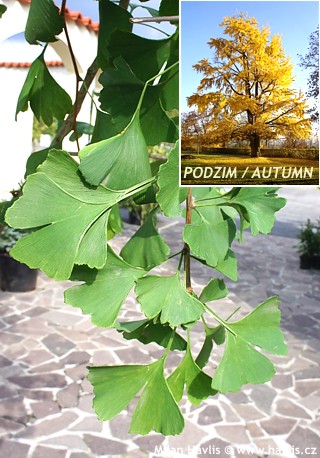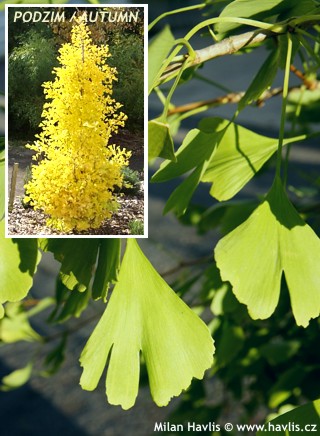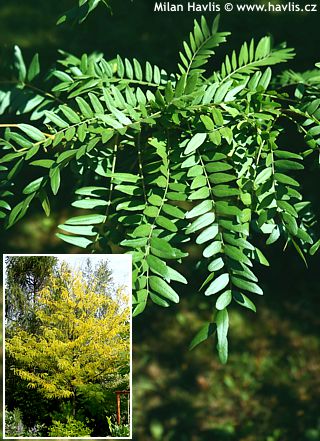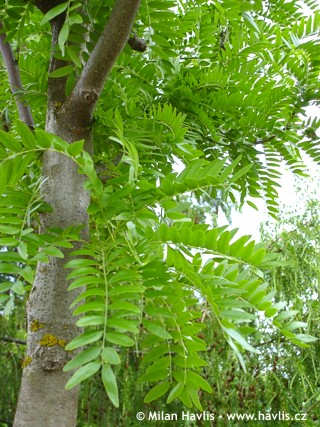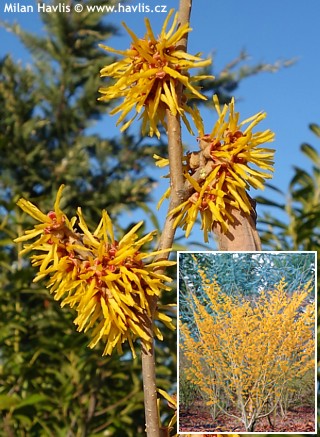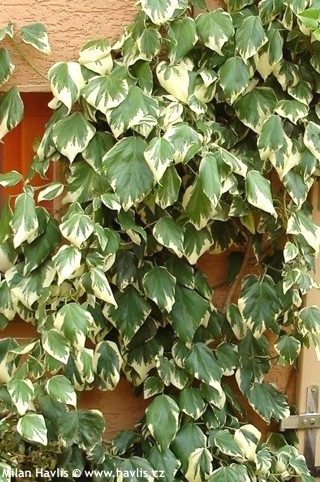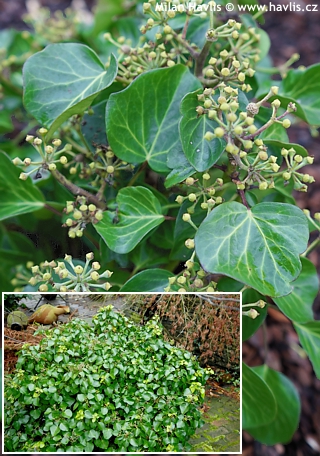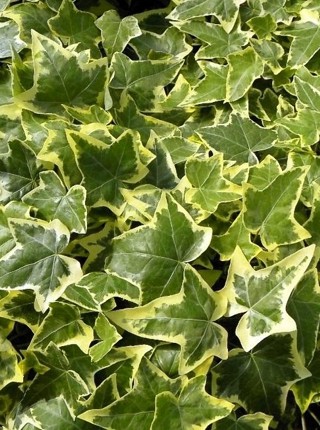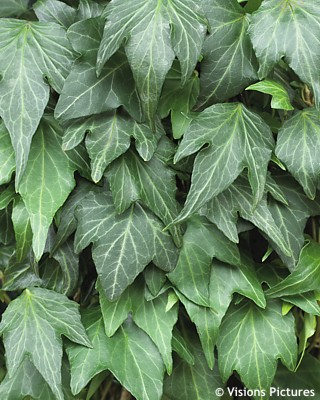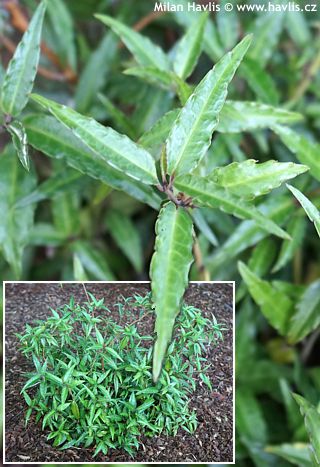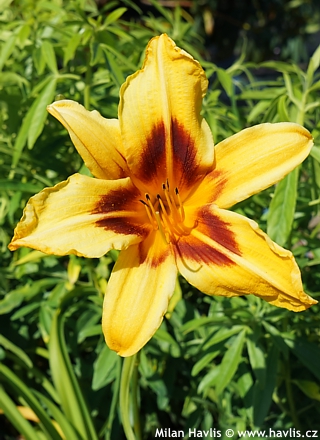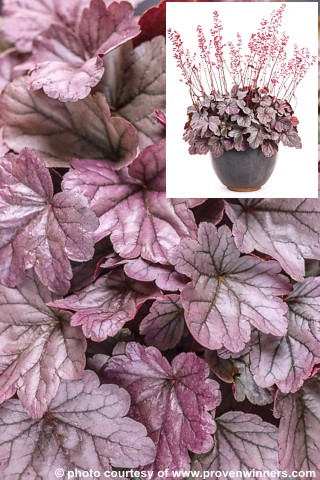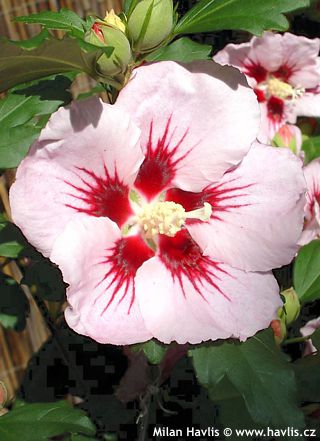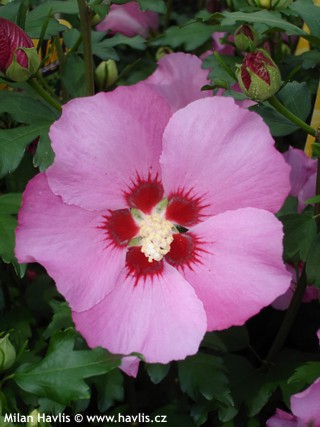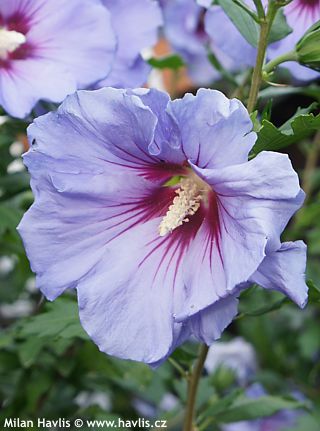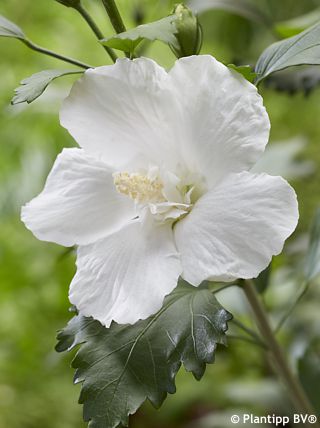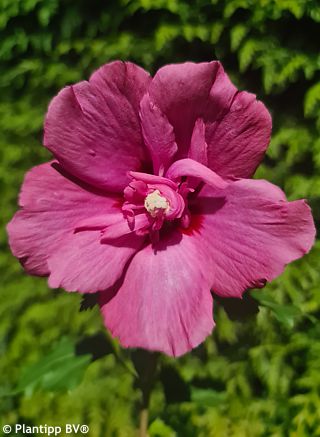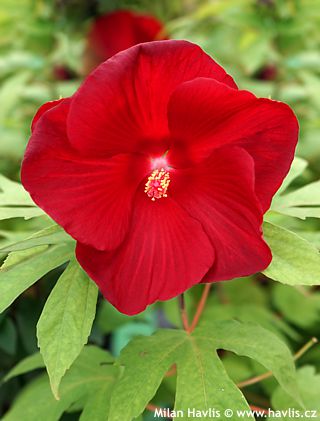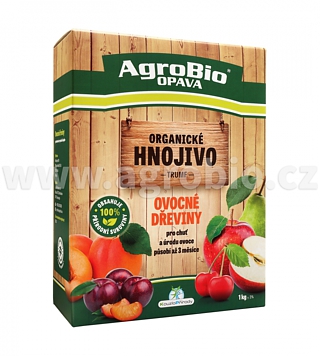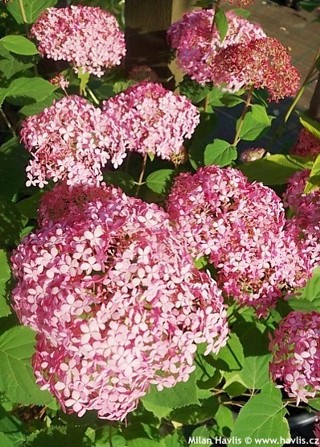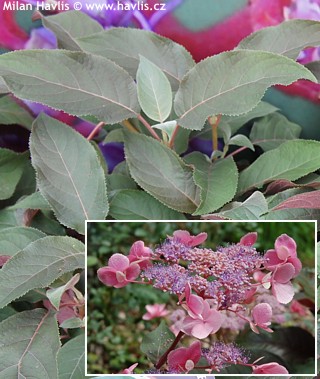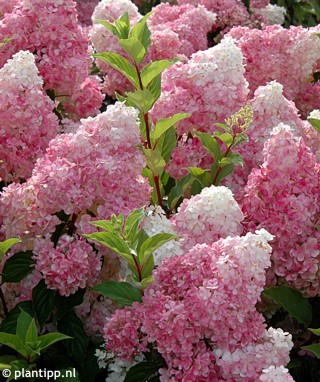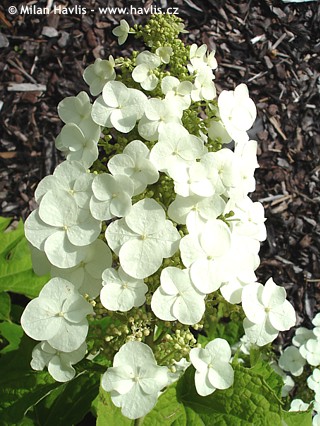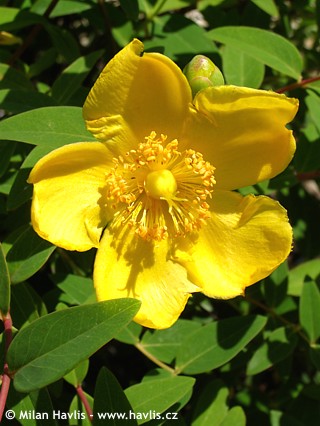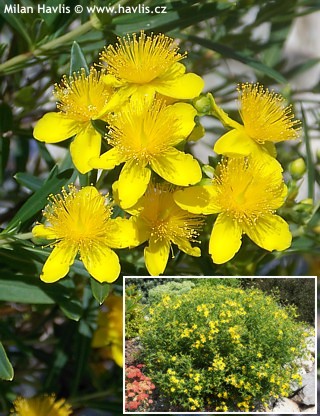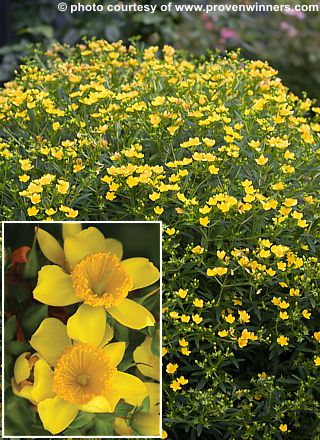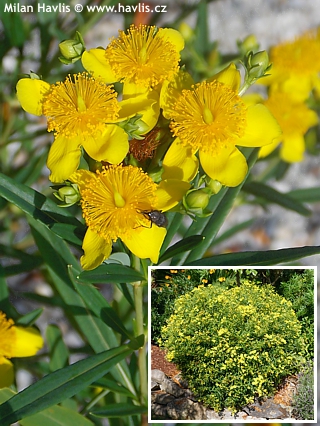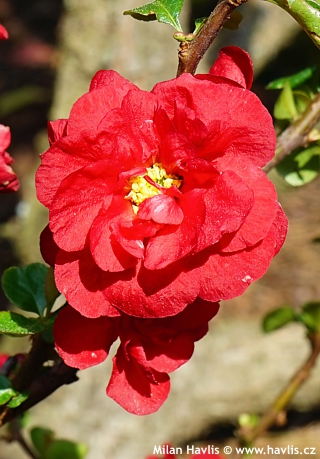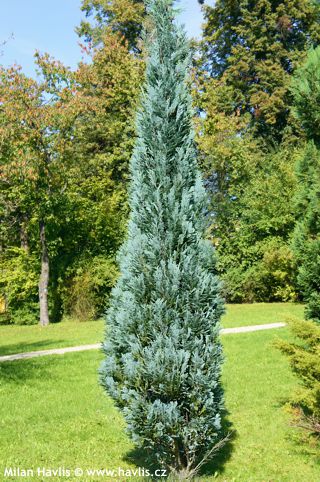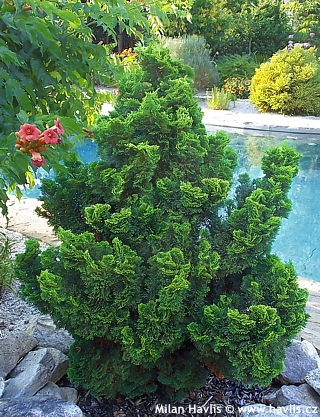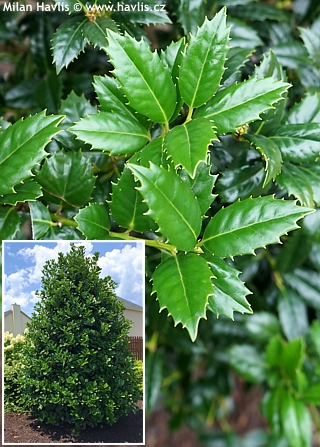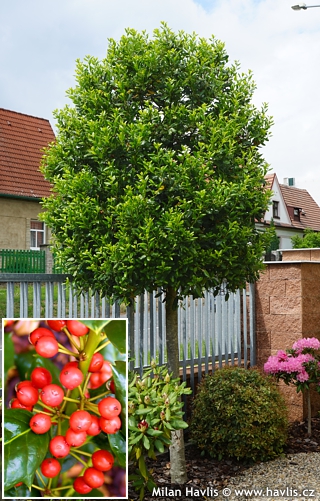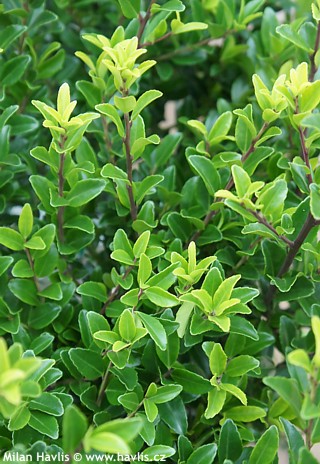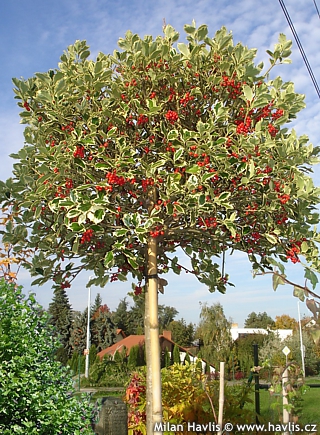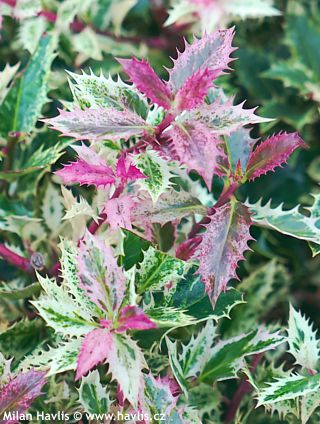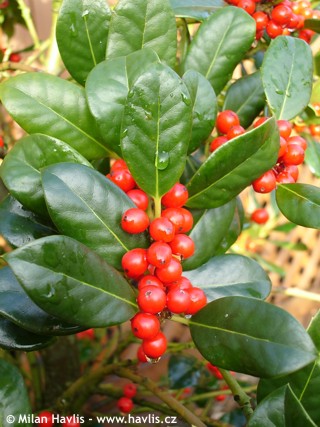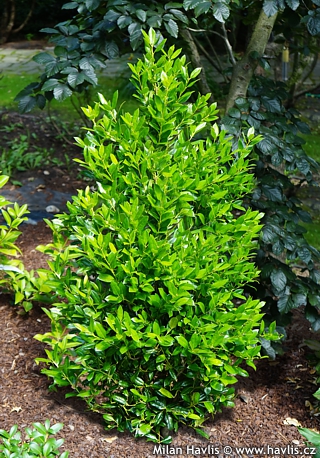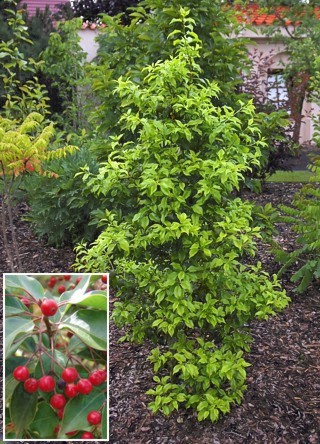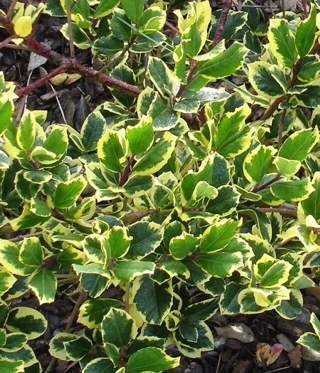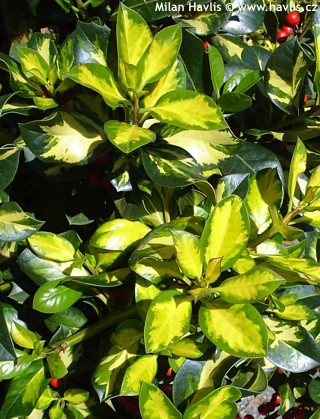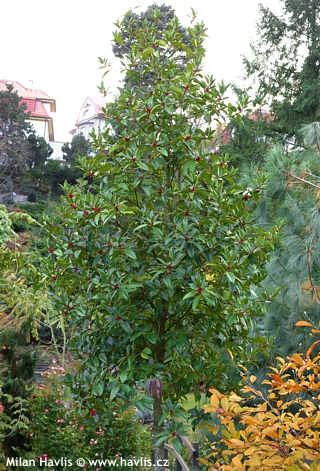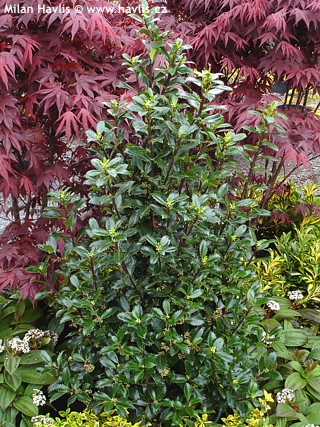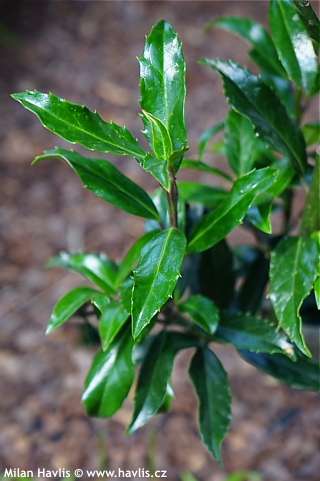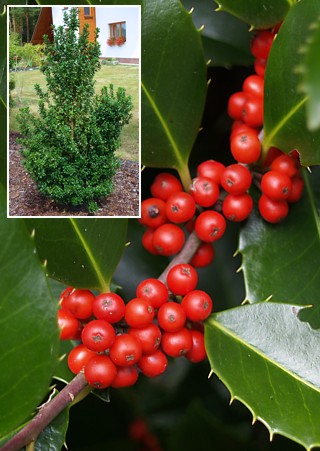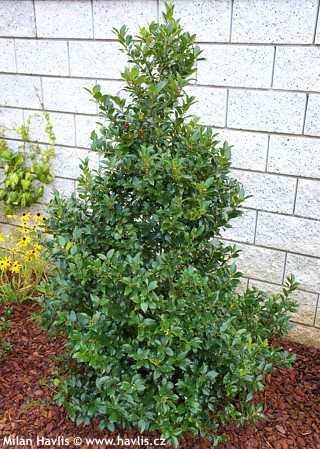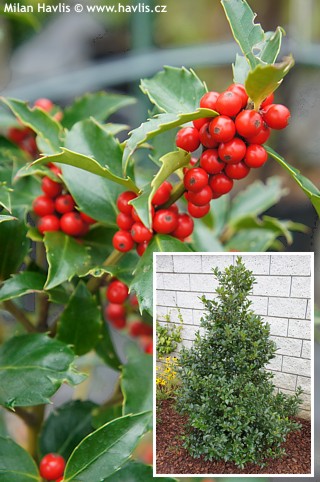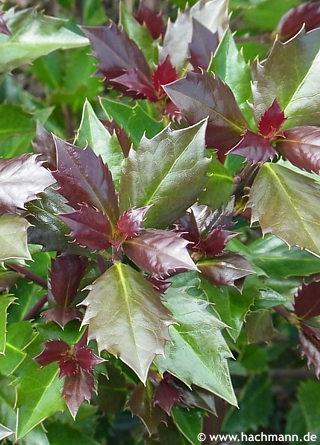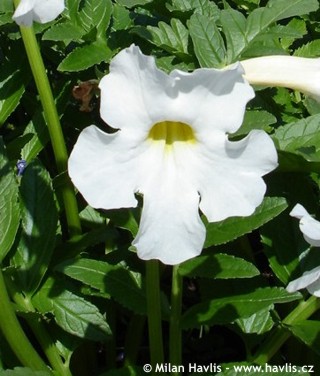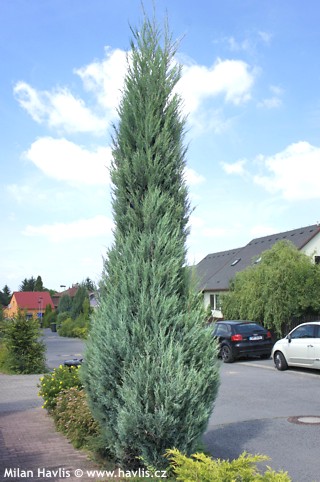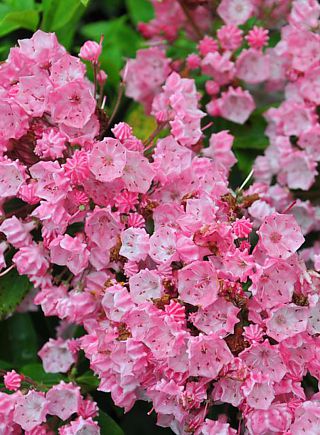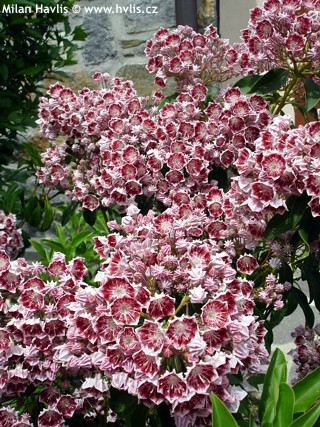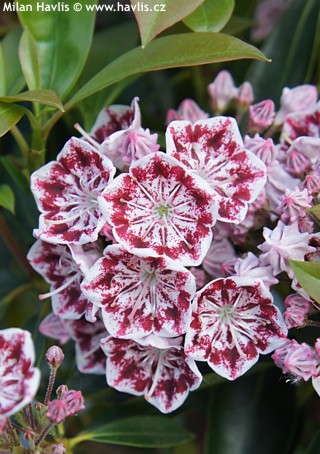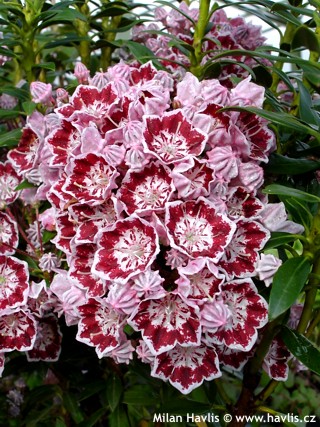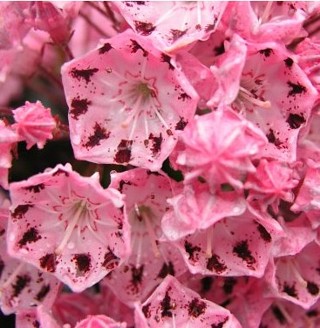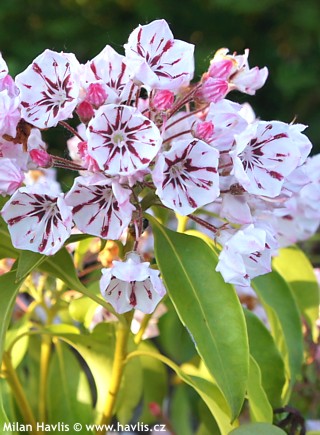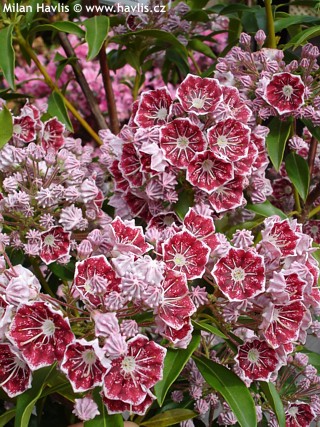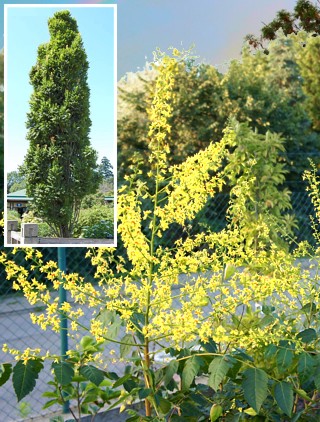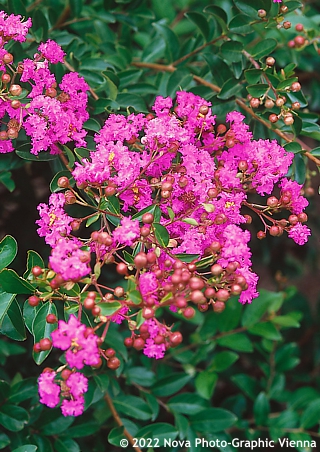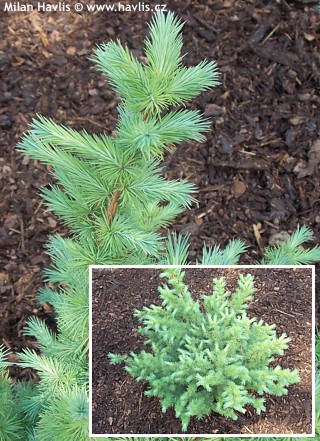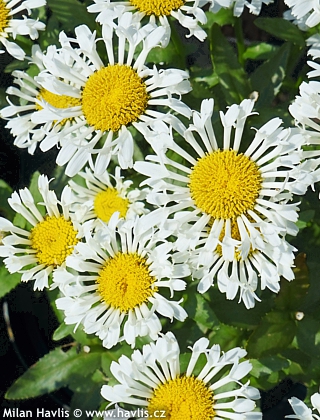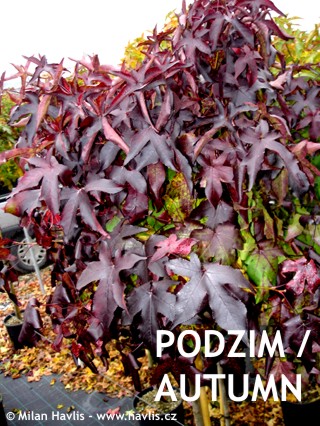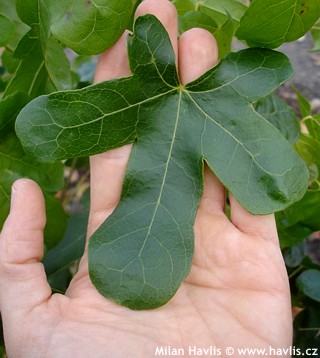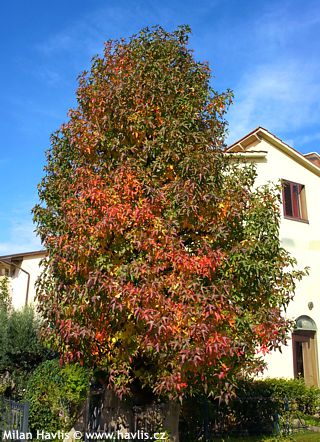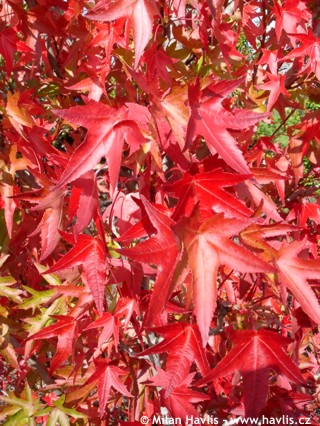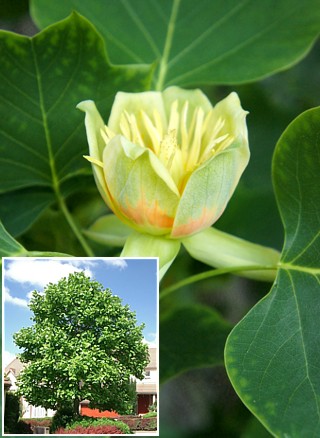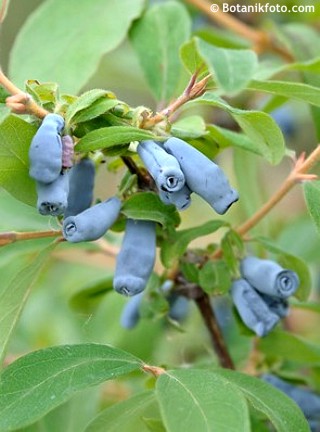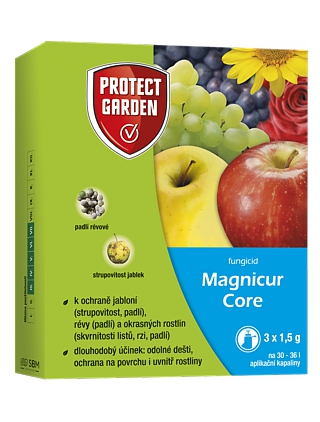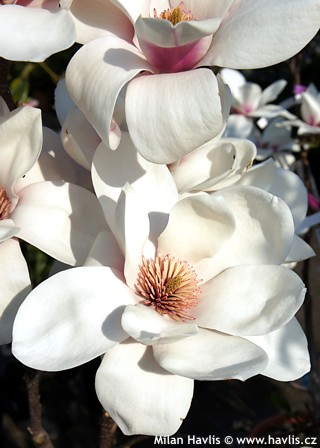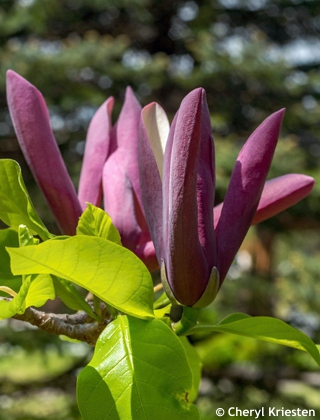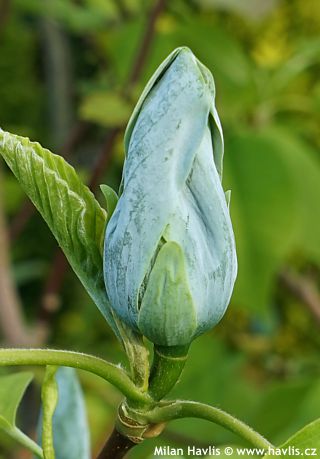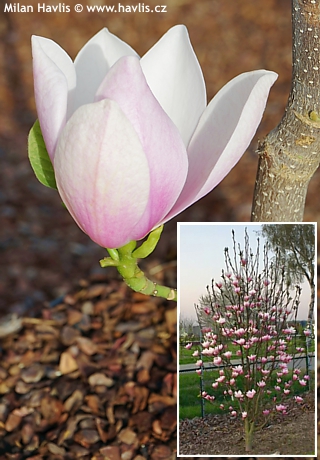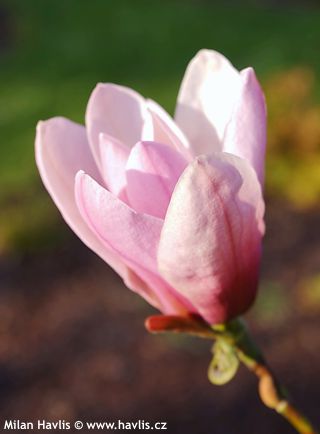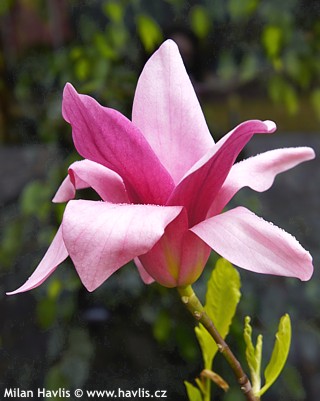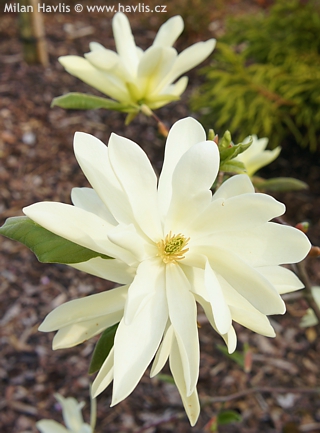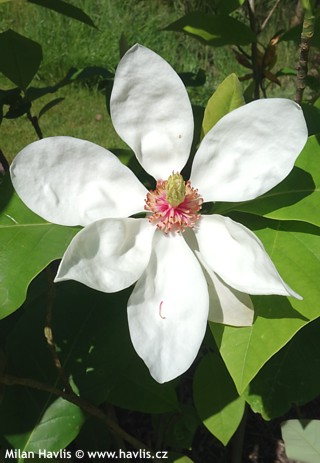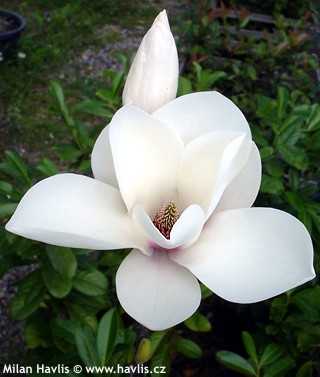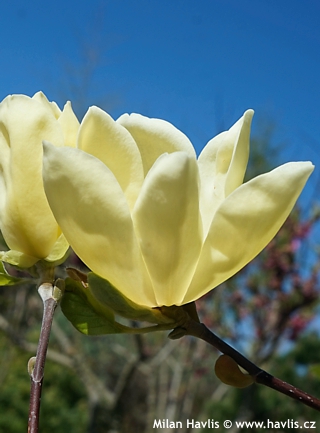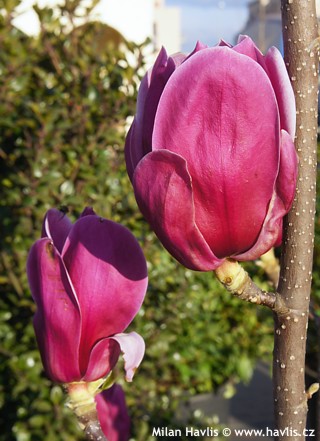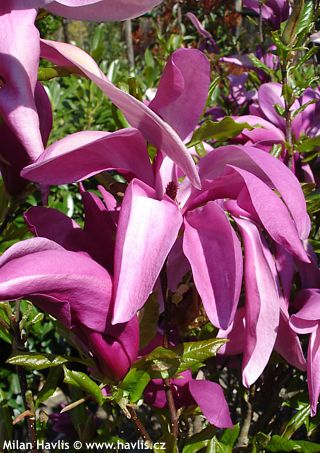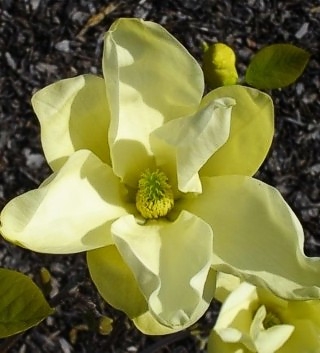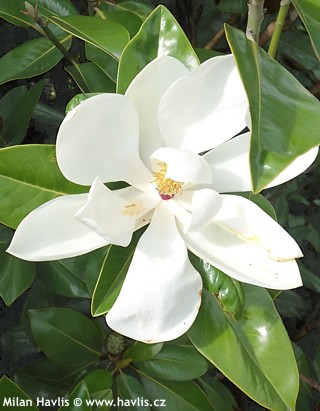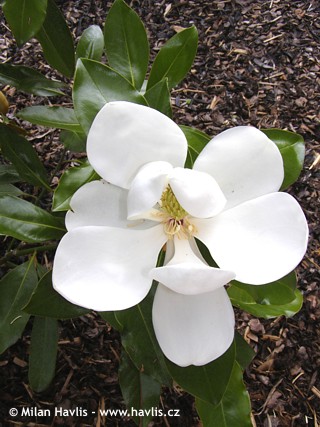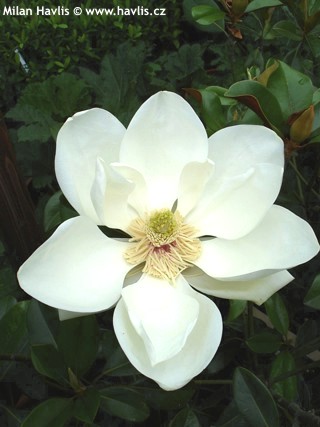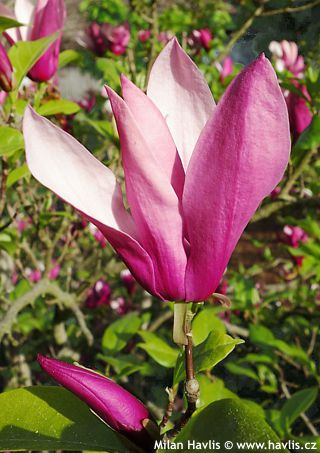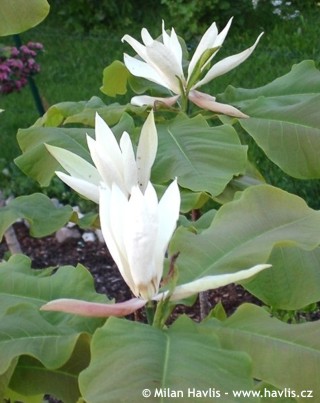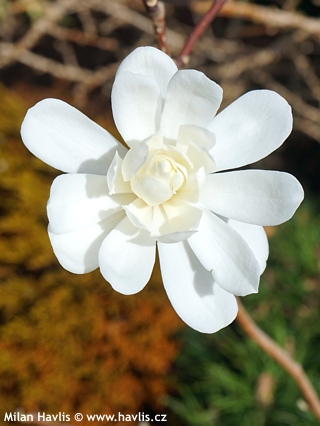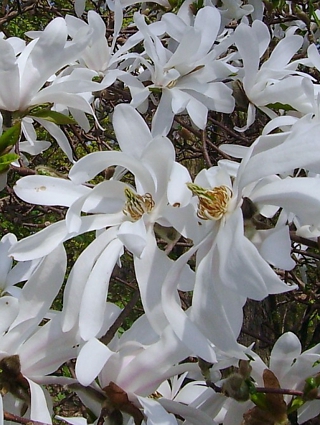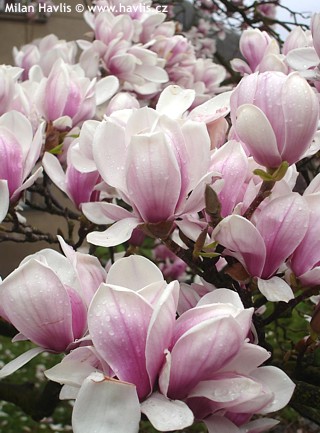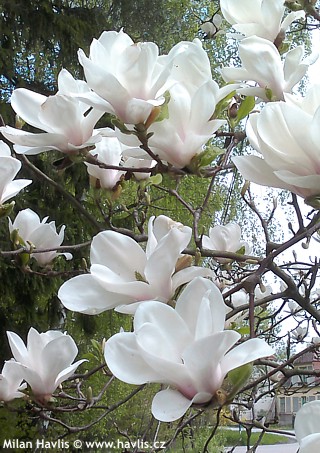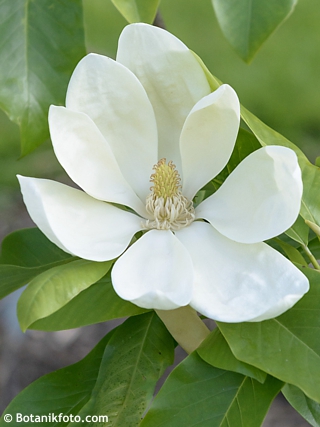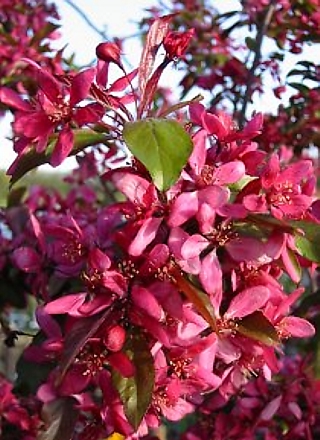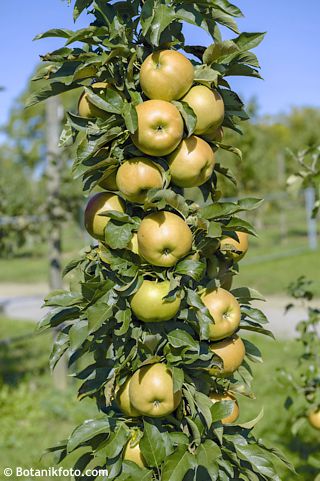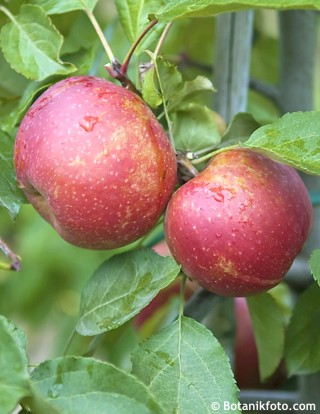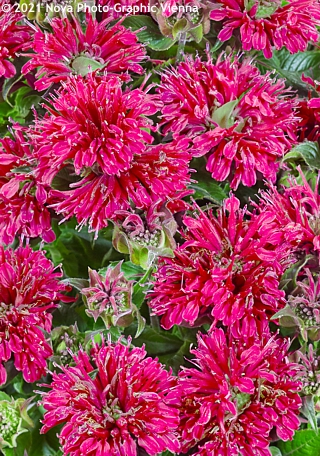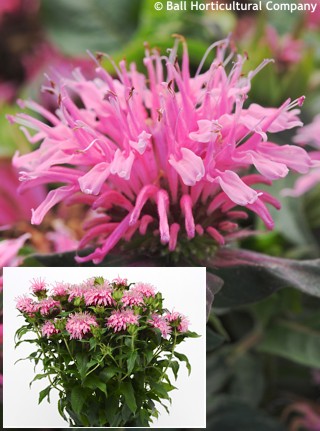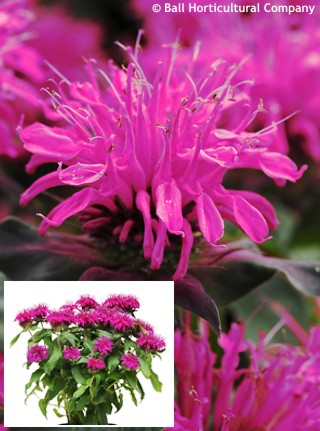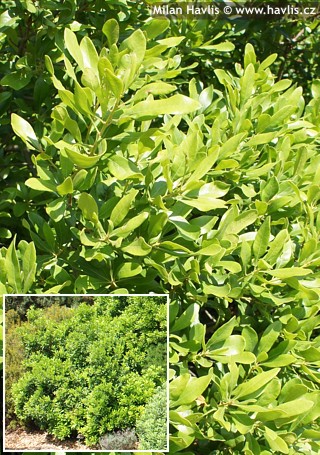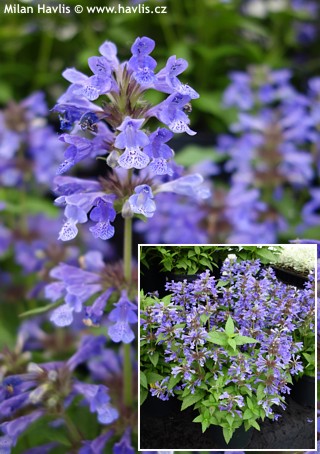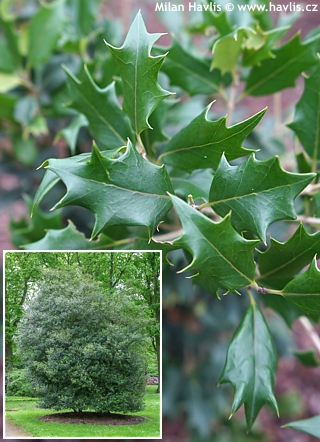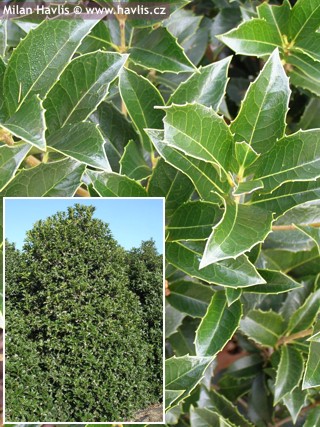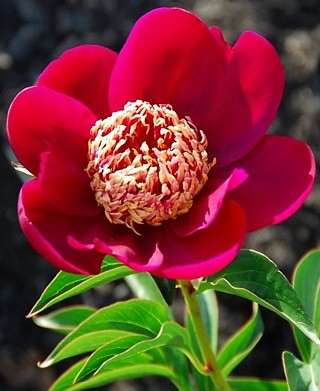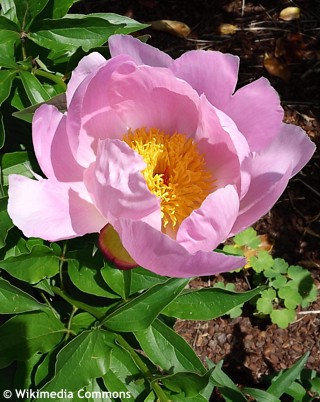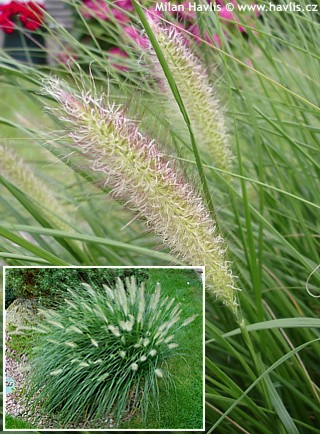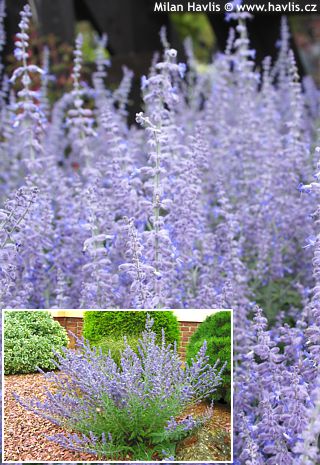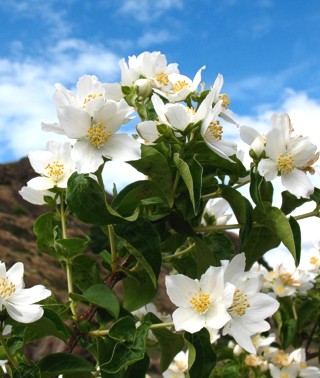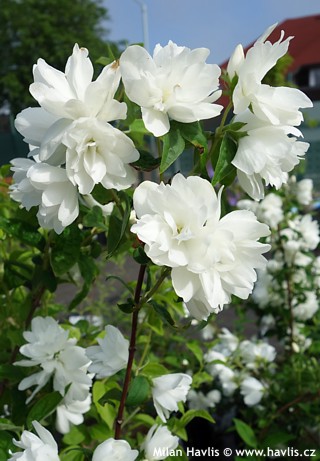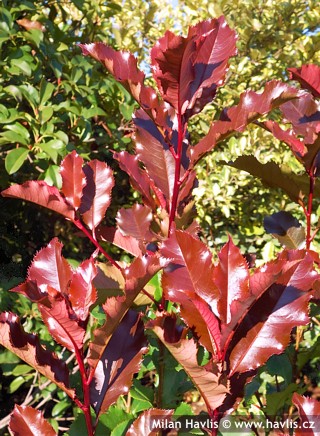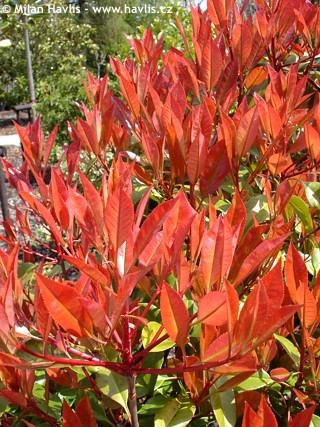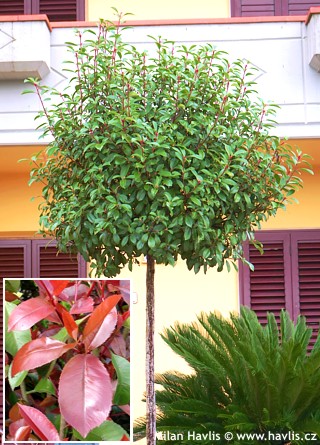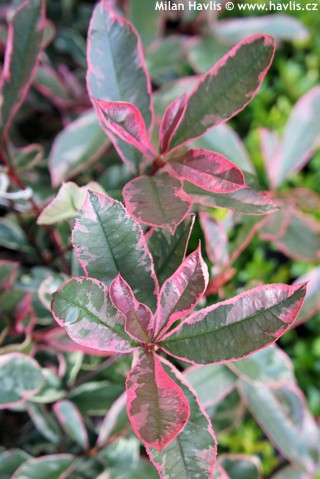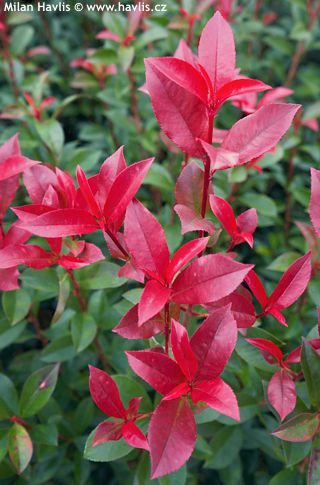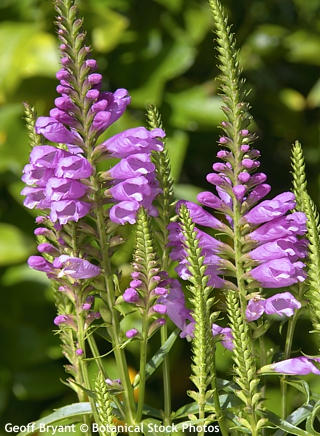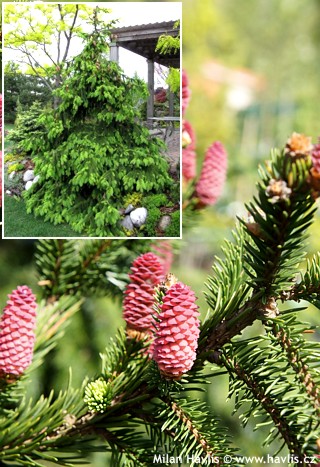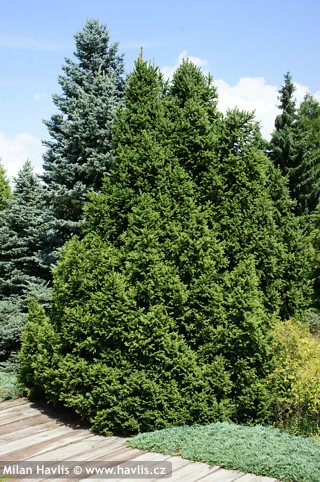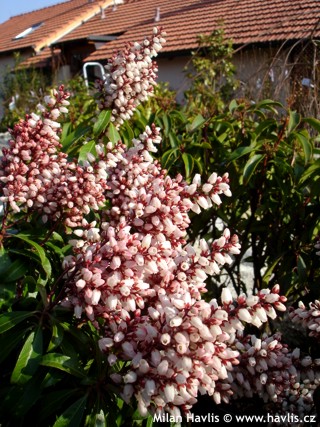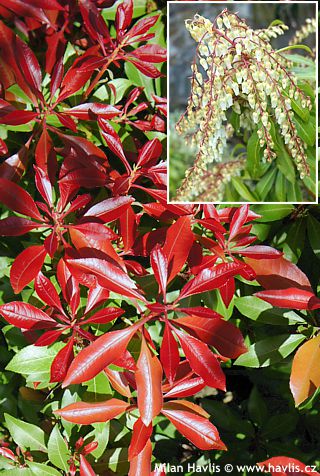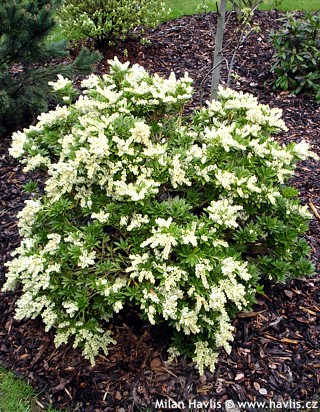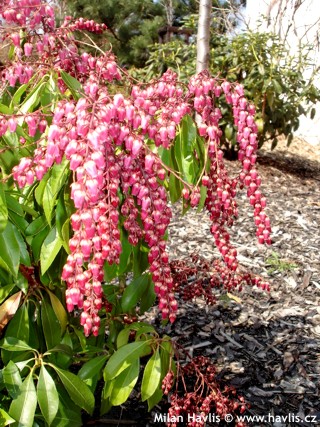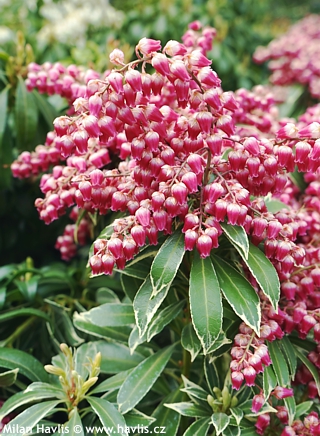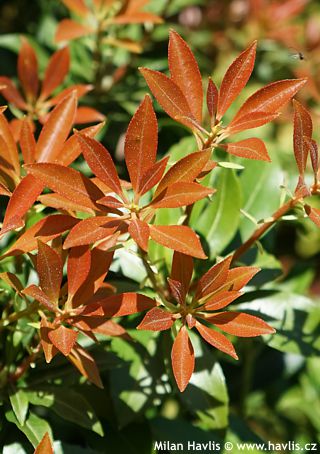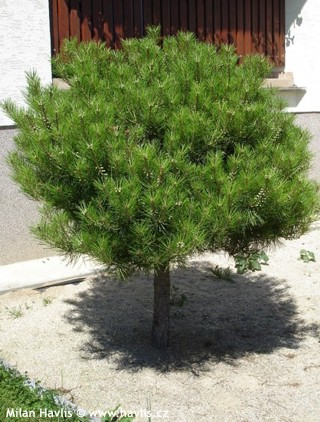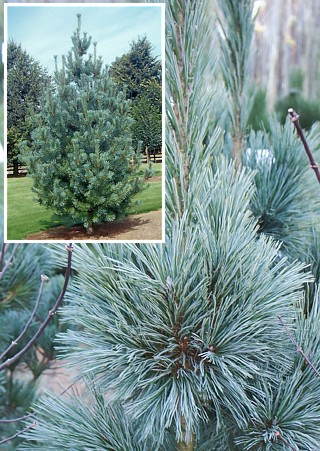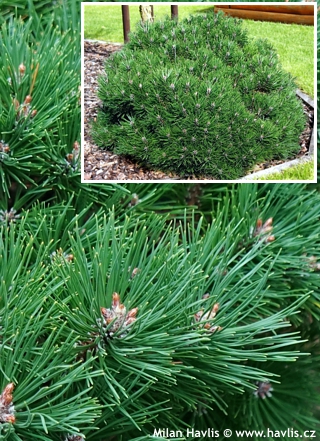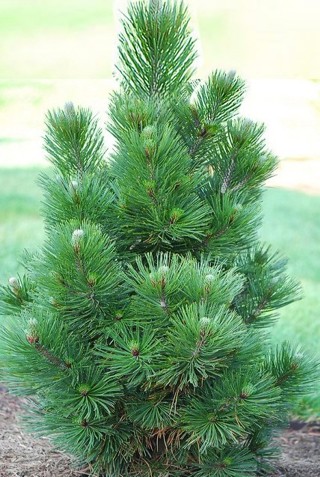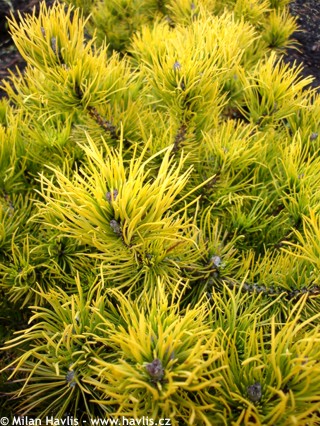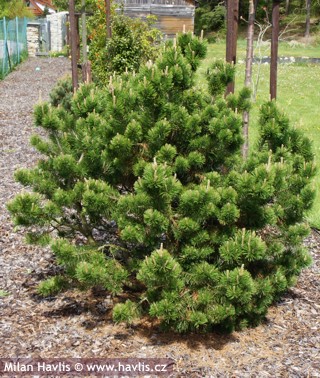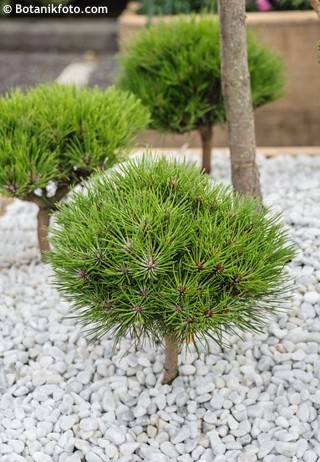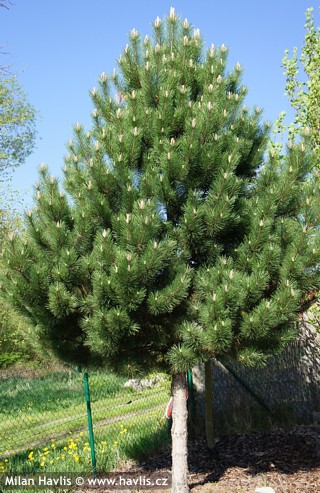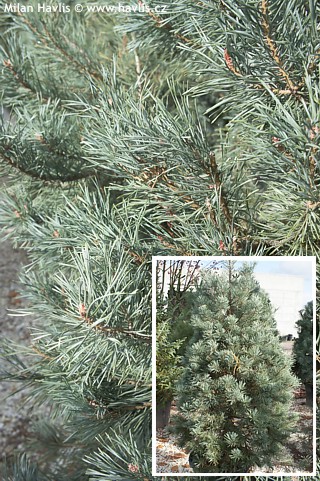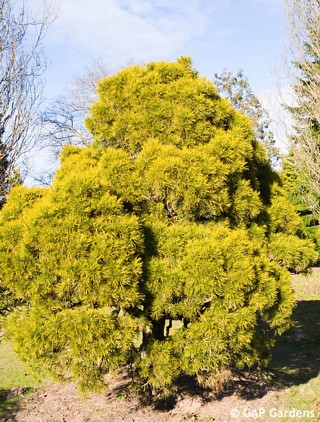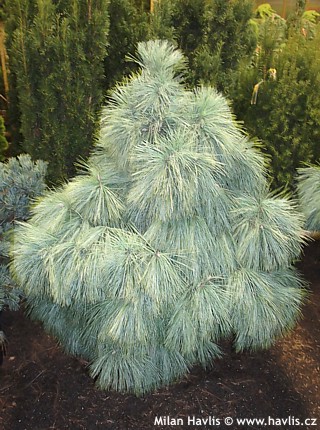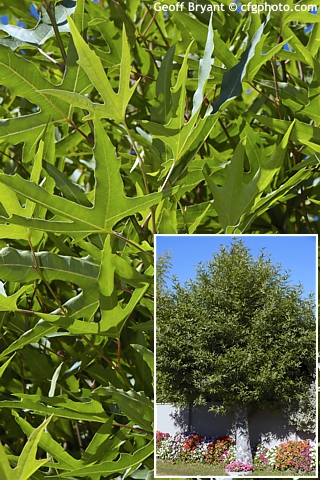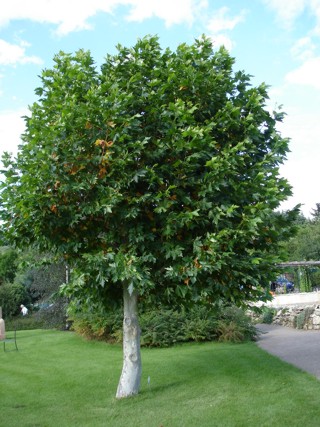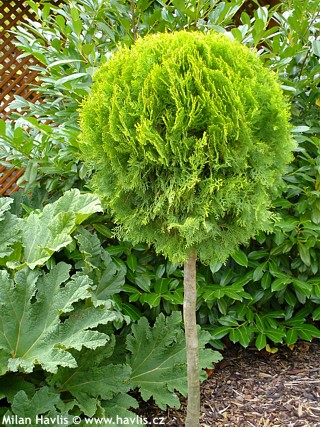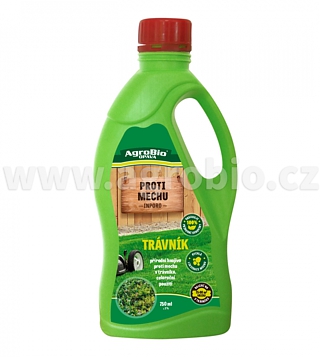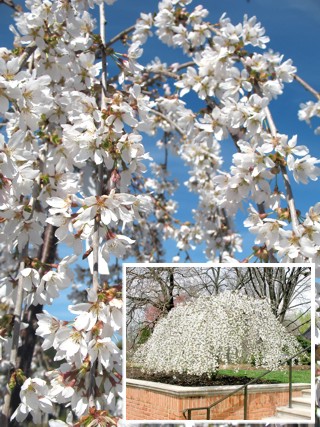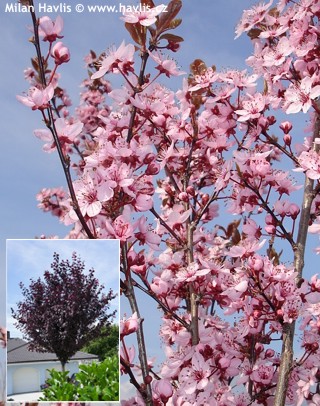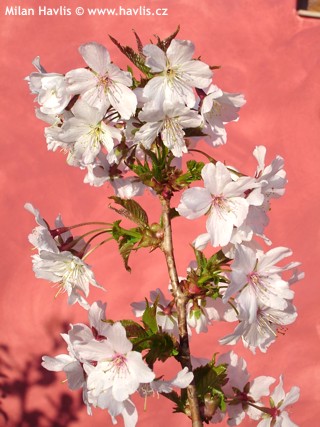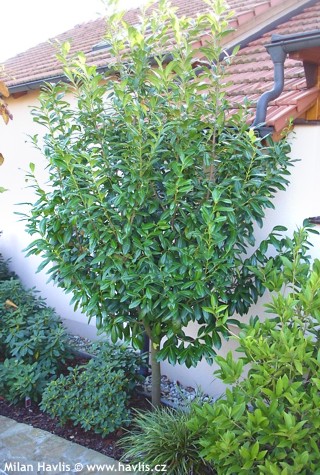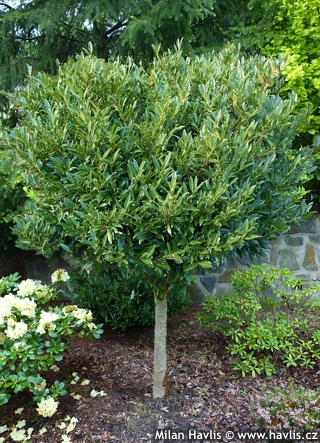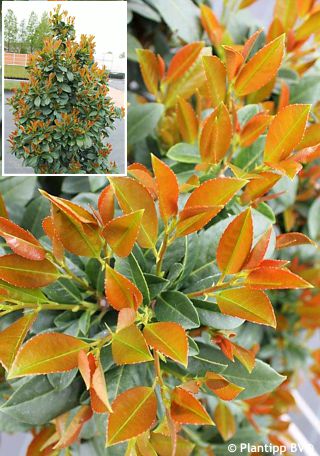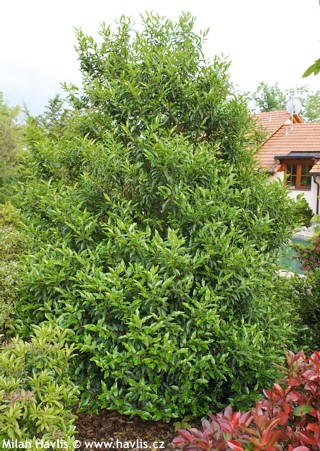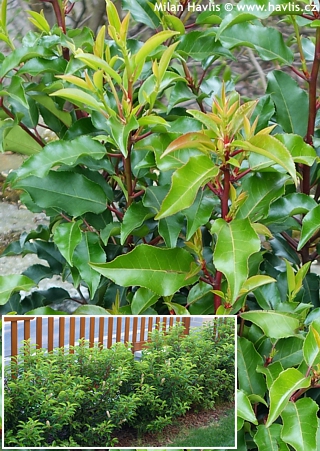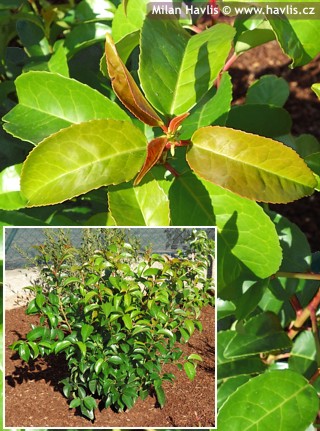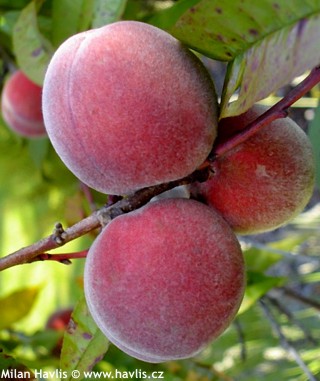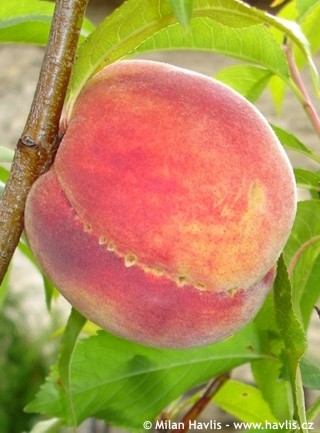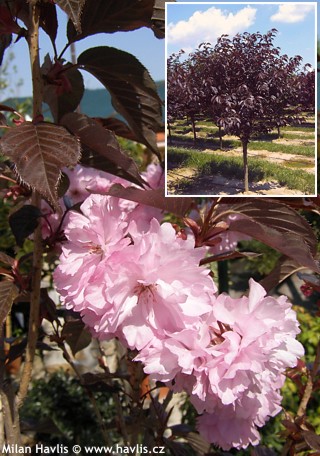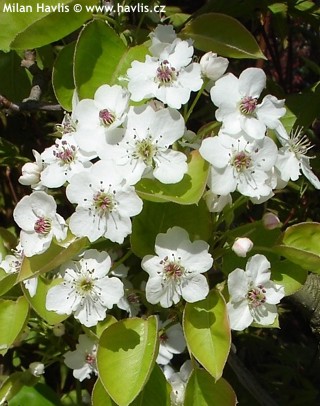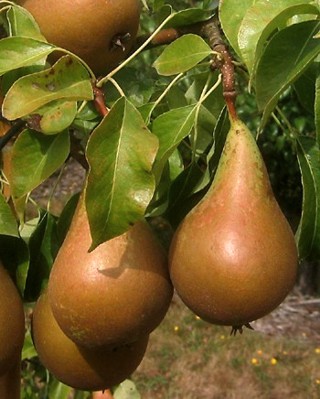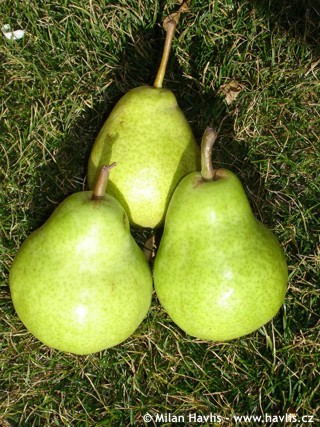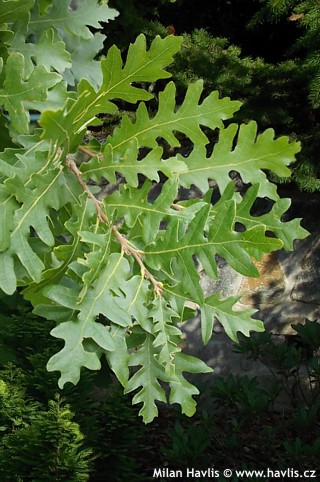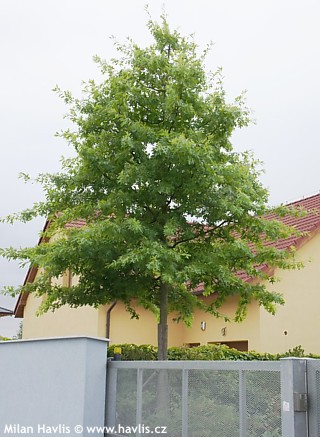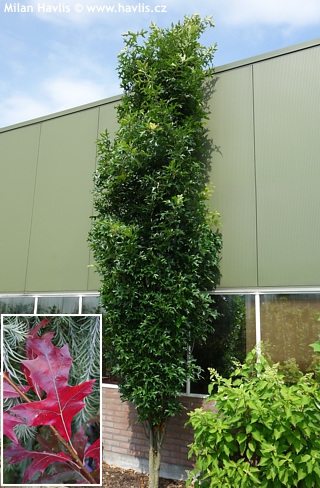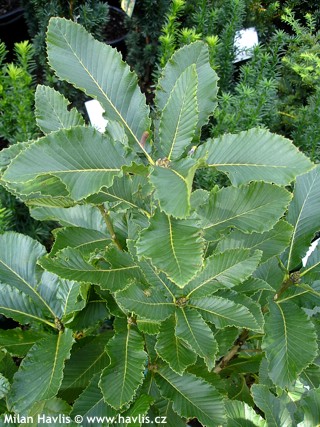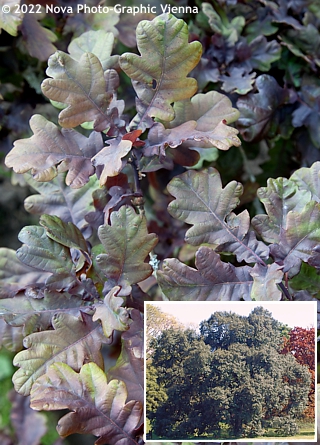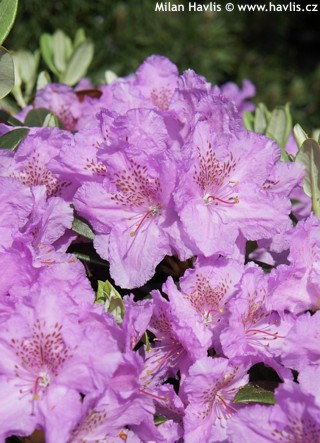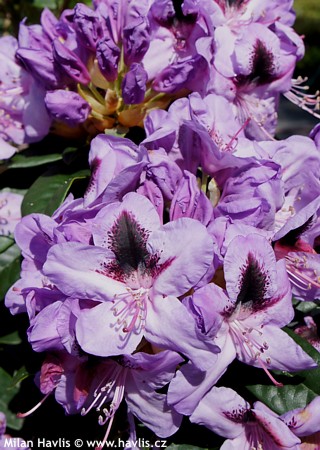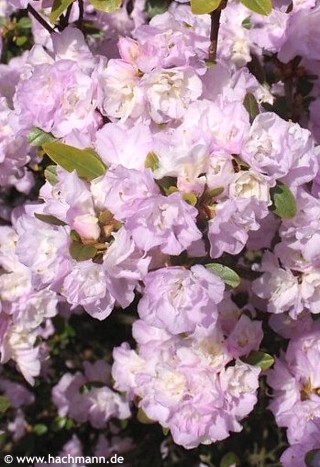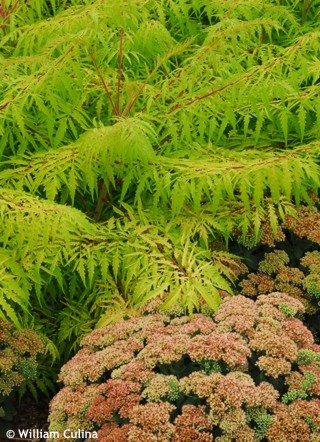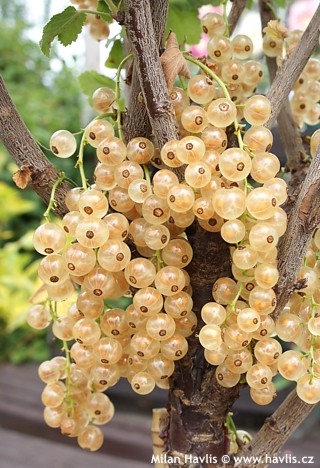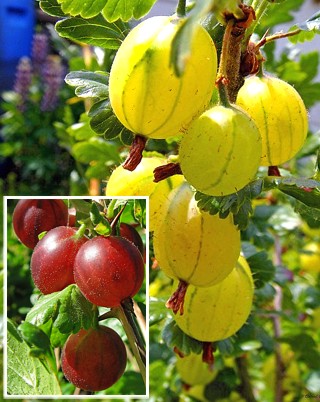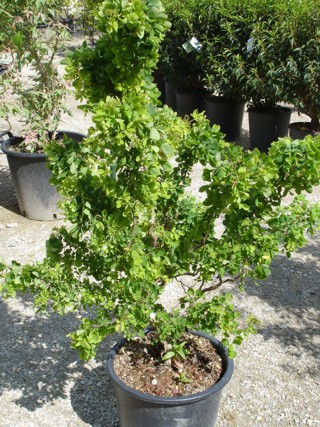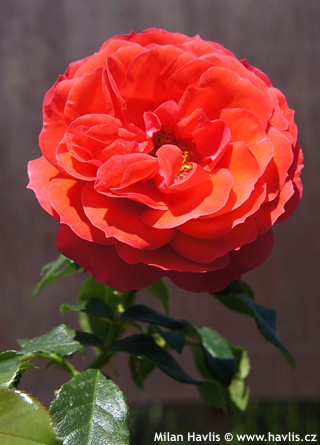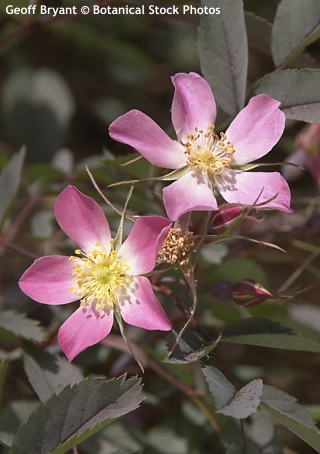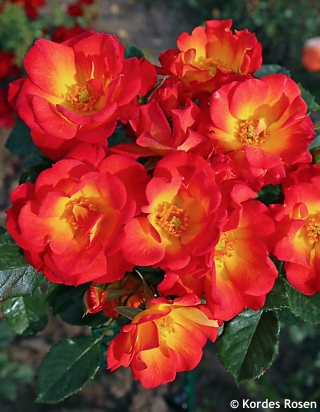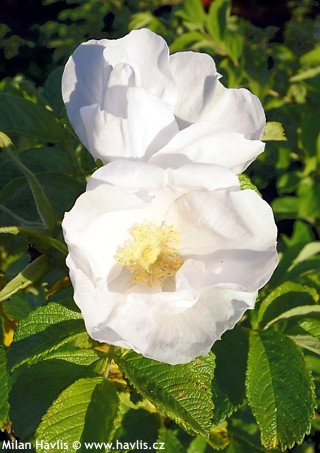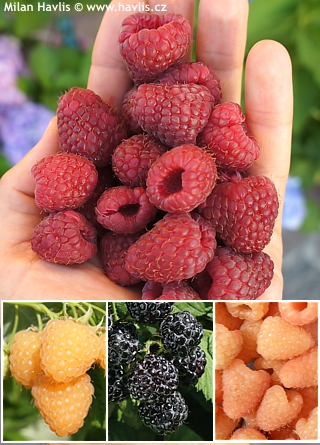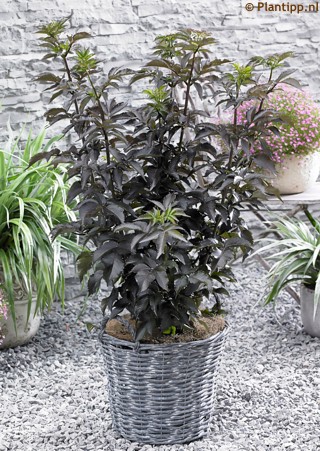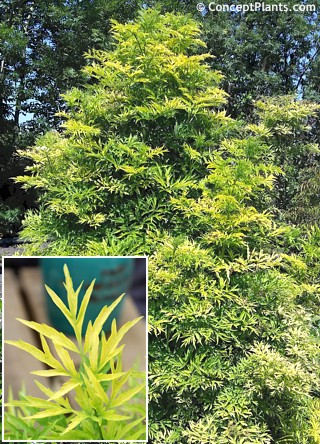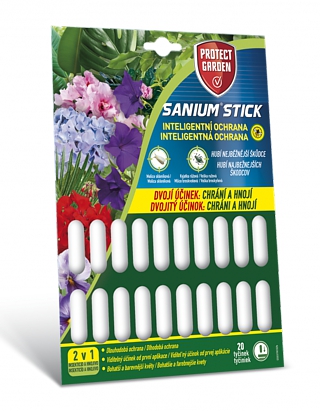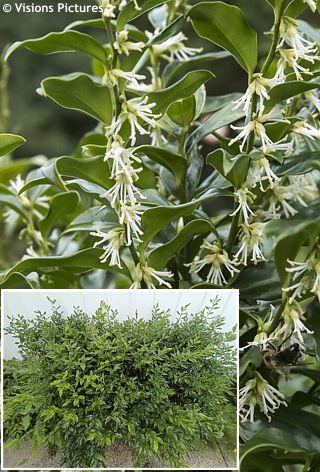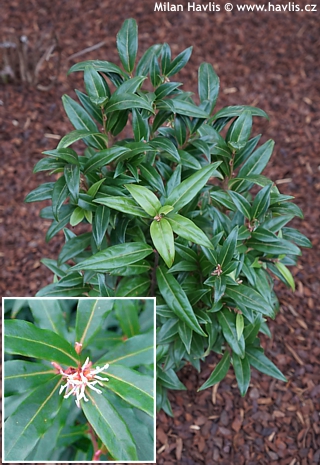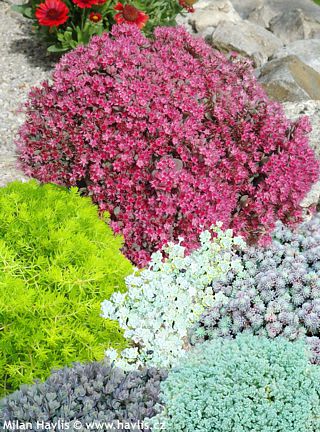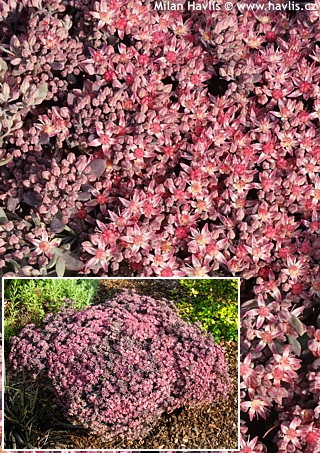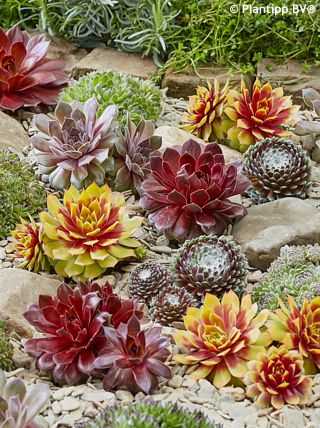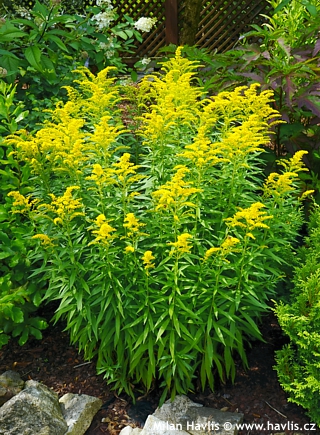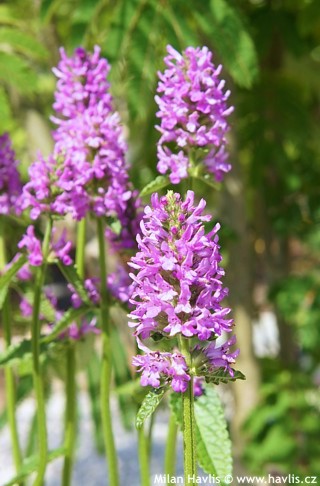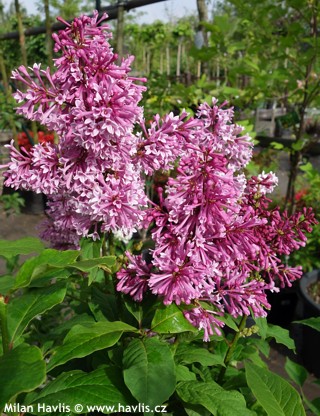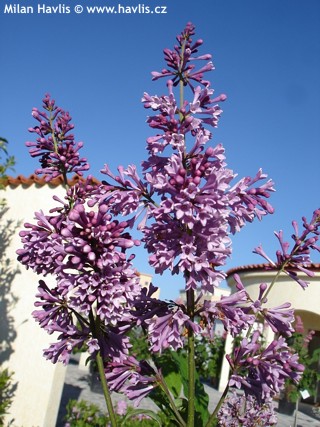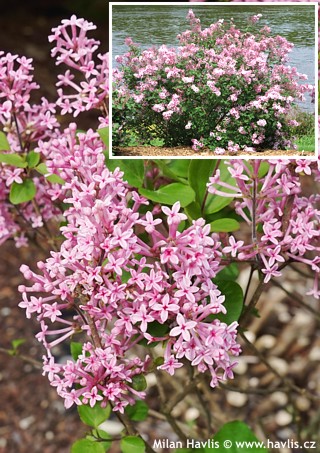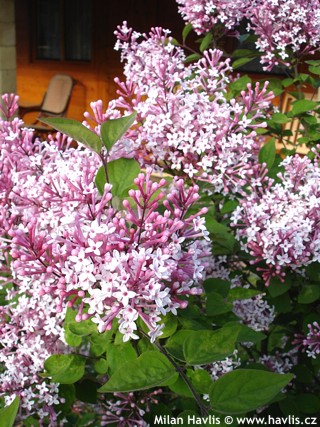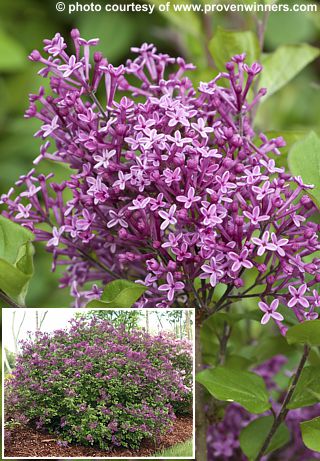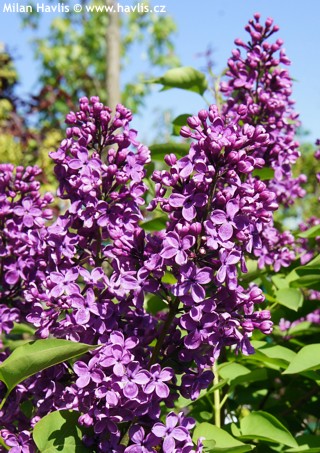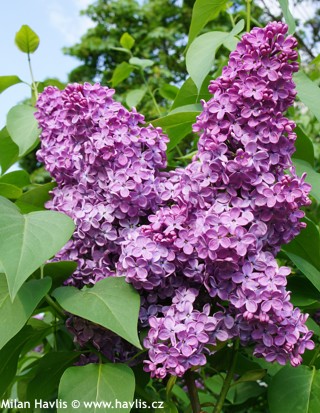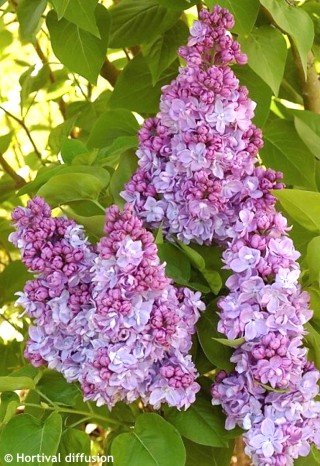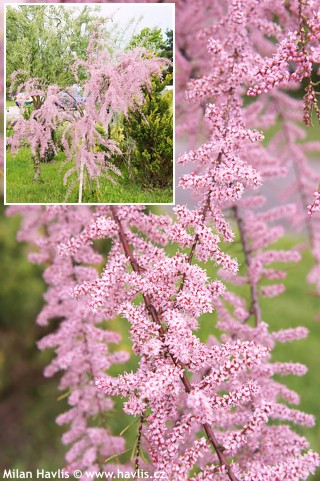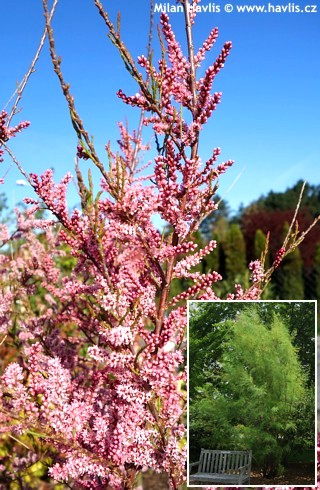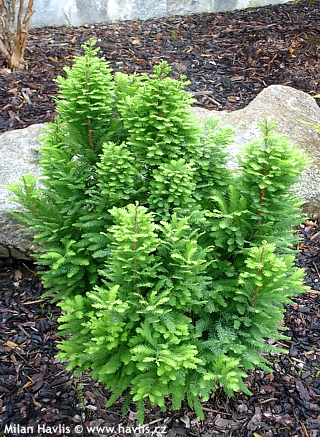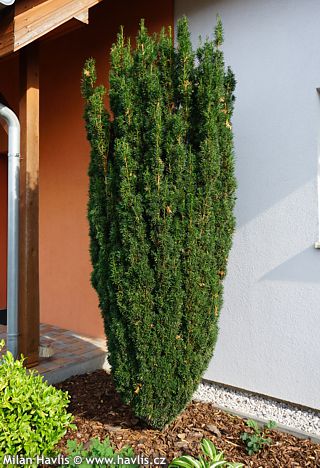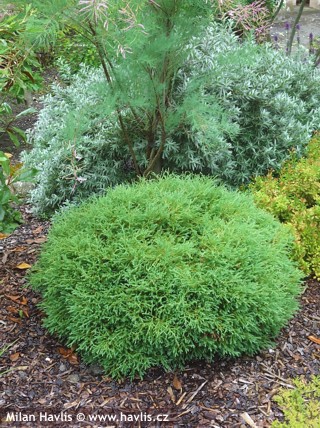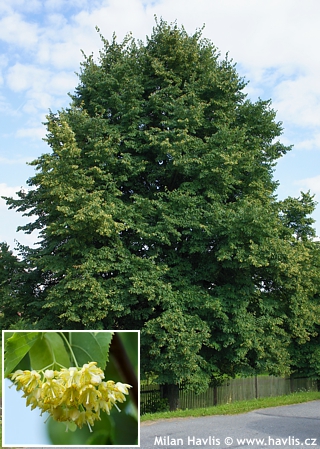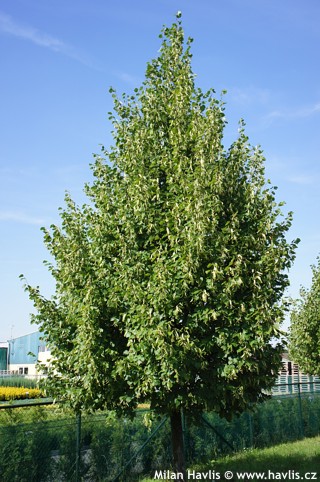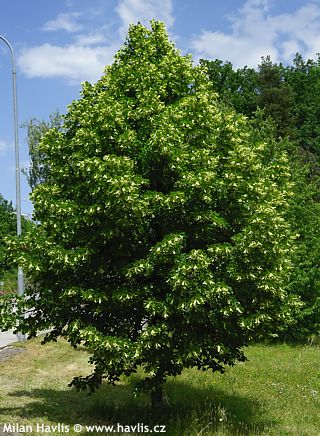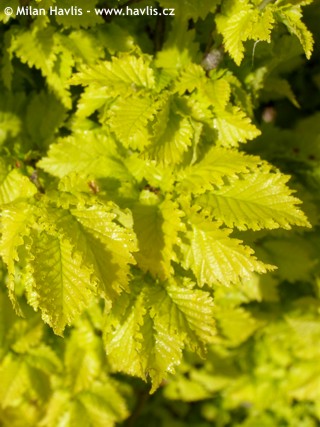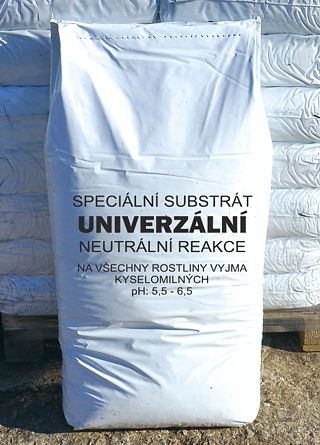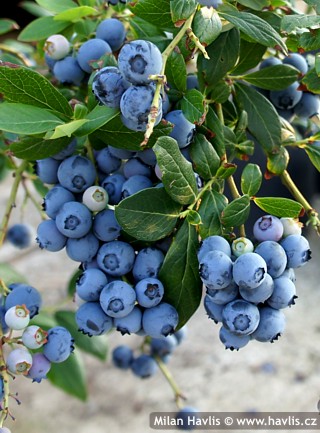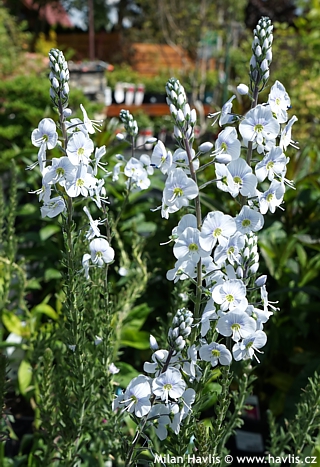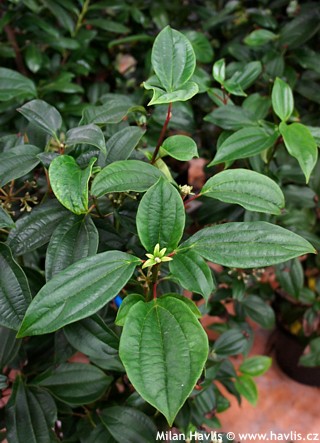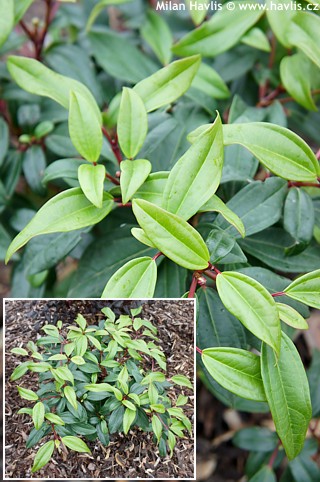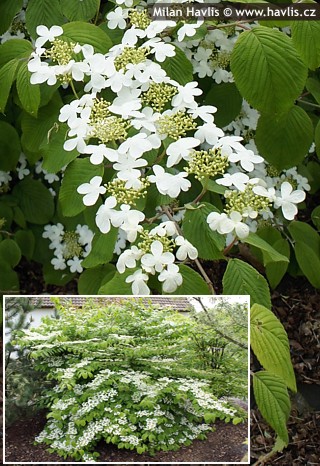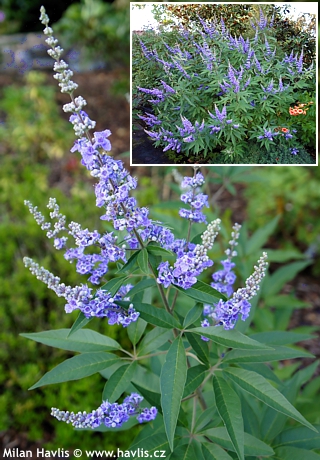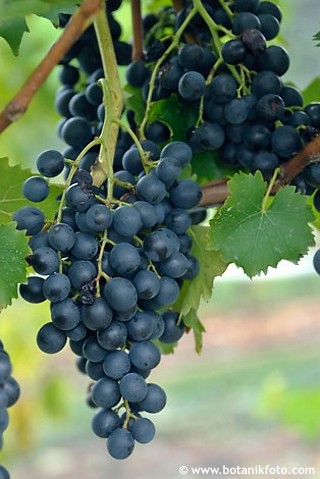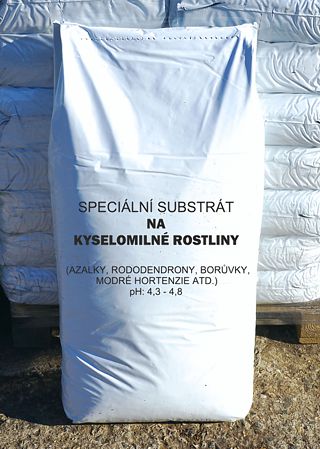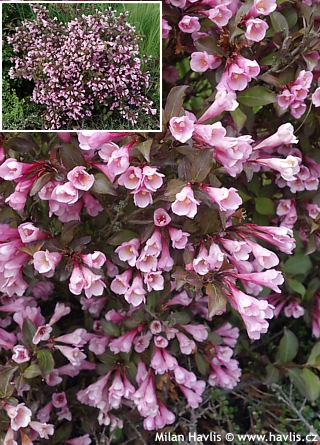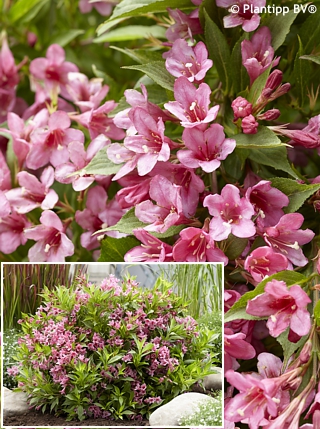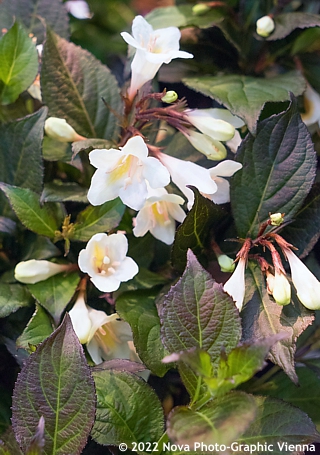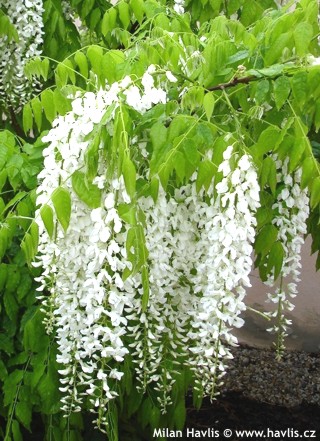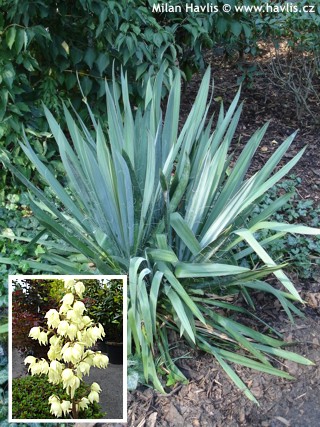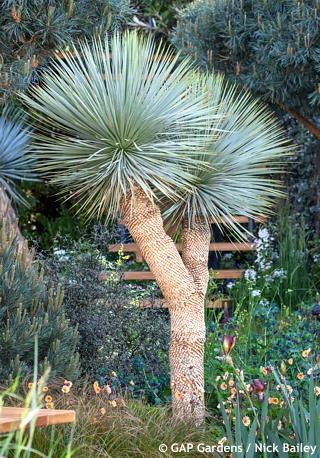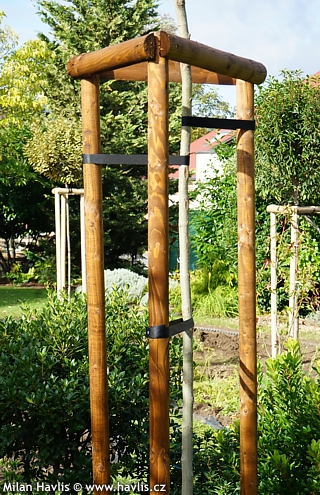CURRENTLY IN STOCK:
Kaleidoscope® is another novelty of the turn of the century. It drags attention thanks to its multicoloured foliage, but not only that. This abelia was found as a naturally occurring mutation of abelia x grandiflora “Little Richard” by nurseryman Randall Dale Lindsey in North Caroli ...

VII - IX

0,3 - 0,5m

0,3 - 0,8m

full to partial sun

7 (down to -23°C)

for zone 5+6

for zone 7
Glossy abelia is a garden hybrid between abelia chinensis and abelia uniflora, and is sometimes also called abelia rupestris. Its dominant feature is profuse flowering from late June until late autumn. Flowers are small, funnel-shaped, pure white, and decorated by pale red calyxes thanks to which th ...

VII - X

0,5 - 1,8m

0,5 - 1,5m

full sun

5b (down to -27°C)

for zone 5+6

for zone 7
Nanum is a dwarf variety of Field maple, suitable for small gardens and avenues with limited space. It grows slowly into a small tree some 2.5m tall and wide. The leaves are deciduous, deep green, with 3-5 rounded lobes, turning yellow in autumn. It naturally forms dense and many branched, rounded c ...

1,5 - 3m

1,5 - 3m

full to partial sun

4 (down to -34°C)

for zone 5+6

for zone 7
Vitifolium is a long-time favourite of a Japanese maple variety, proved to thrive in almost any garden, and characterized by large, 8-15 cm wide, palmately rounded leaves, which are divided into 9 to 12 pointed lobes with serrated margins. The number of lobes distinguishes this species from all othe ...

3 - 5m

2 - 4m

full sun

5 (down to -29°C)

for zone 5+6

for zone 7
Montpellier maple is a typical Mediterranean tree commonly found in dry, coastal or mountainous landscapes of Portugal, France, and Italy. It makes small, three-lobed, leathery but deciduous leaves, which are medium green in summer, and turn yellow, amber orange or scarlet red in autumn. Its flowers ...

4 - 6m

4 - 6m

full sun

5 (down to -29°C)

for zone 5+6

for zone 7
Shapes and colours are usually the key features of Japanese maples. But there are other maples, too, that can offer other than green colour plus various leaf shapes. And on top of that they grow much faster.
This is ash-leaved maple, also called box elder. Flamingo is so far the best-selling variet ...

3 - 7m

2 - 4m

full sun

2 (down to -45°C)

for zone 5+6

for zone 7
The species of Japanese maple is a green-leaved tree or rather a large shrub. End even though among landscapers and general green-finger-public the red-leaved versions tend to be more popular I suppose that this is the most beautiful and elegant tree of our climate. With its naturally green leaves i ...

3 - 8m

3 - 6m

full to partial sun

5 (down to -29°C)

for zone 5+6

for zone 7
Atropurpureum is a famous and commonly used variety with deeply lobed, red-purple leaves that turn bright red and orange in autumn. They have 5 tips. It forms a multi-stemmed shrub with widely spread branches. It grows slowly and is suitable as a specimen in any garden, not just a Japanese style gar ...

3 - 6m

3 - 4m

full to partial sun

5 (down to -29°C)

for zone 5+6

for zone 7
Bi-hoo is a new Japanese maple variety found by maple enthusiast, Mr.Masayoshi, in Japan in 1993. It was introduced and licensed in Europe by Maillot Nurseries in France in 2004. It is valued predominantly for its stunning colour in autumn and winter when the stronger branches and stems gain golden ...

2 - 3m

1,5 - 2m

full to partial sun

5b (down to -27°C)

for zone 5+6

for zone 7
Bloodgood is an extremely commercially successful variety with deep burgundy leaves. They have 7 lobes and hold the colour reliably. The leaves turn bright scarlet red in the autumn. The bark is blackish-red.
It forms a small tree or a large shrub with compact, rounded crown with predominantly upr ...

3 - 6m

2 - 3m

full to partial sun

5b (down to -27°C)

for zone 5+6

for zone 7
Butterfly is a variety with 3-coloured foliage. Its deeply cut, palmate leaves are pale green with creamy white margins that turn pink when they emerge and when the weather turns colder. It grows into a V-shaped shrub with dense foliage, especially at the tops of the branches.
It grows slowly abou ...

1 - 2,5m

1 - 2m

semi-shade / partial sun

5b (down to -27°C)

for zone 5+6

for zone 7
Katsura is a Japanese maple that is highly decorative especially in spring, when new leaves emerge, and in autumn, when they change again. They are typically palmate, rather small, 5-lobed, chartreuse yellow-green with coppery margins in early spring, rich green in summer, and glowing golden-yellow ...

1,5 - 3m

1,5 - 3m

full to partial sun

5 (down to -29°C)

for zone 5+6

for zone 7
If you google red-leaved Japanese maples I am sure that, amongst the oldest varieties such as Bloodgood and Atropurpureum, you will find this nice piece: Shaina. Unlike the previously mentioned cultivars Shaina is everyone’s love as it offers advantages that come in handy for gardeners-beginne ...

1 - 2m

1 - 1,5m

full to partial sun

5 (down to -29°C)

for zone 5+6

for zone 7
Sango-kaku is a Japanese maple that has so many colours that we are lost for words. Its main attraction is the colour of bark which is orangey-red in summer and bright coral red in winter. The palmate leaves have 5 lobes and emerge orangey-yellow with salmon pink shades, changing to light green or y ...

2 - 4m

1 - 2,5m

semi-shade / partial sun

5 (down to -29°C)

for zone 5+6

for zone 7
Dissectum Viridis has light green, very soft, deciduous, deeply cut leaves with 7 or 9 lobes. To maintain its colour we recommend growing it in location with filtered sunlight or semi-shade as the leaves may show signs of sunburn in hot sun, or even change its colour in full sun and dry soil.
The ...

1 - 2m

1 - 2,5m

semi-shade / partial sun

5 (down to -29°C)

for zone 5+6

for zone 7
Columnare is a slender form of Norway maple with deciduous, 10-15 cm across, broadly palmate leaves that are green in summer and turn golden orange and bright yellow in autumn. The crown is very narrow – only about 3m wide in 15-20 years, and rather dense. Pruning is usually not required but c ...

15 - 18m

3 - 5m

full to partial sun

for zone 5+6

for zone 7
Crimson Sentry is most certainly a key feature of many mid-sized and small gardens. Its yearly growths are short so it will easily fit even in a front yard.
It is an eye-catching variety of Norway maple owing to the foliage. The leaves are bright purple-burgundy when young, and deep crimson red th ...

3 - 6m

2 - 3m

full to partial sun

4 (down to -34°C)

for zone 5+6

for zone 7
Royal Red is a majestic looking Norway maple for large gardens, parks, and city avenues. Its palmate leaves are dark crimson red, almost black, and glossy, turning amber orange or orange-red in autumn. In spring, just as leaves emerge, it flowers profusely with many small yellow flowers, typical for ...

10 - 20m

5 - 10m

full sun

3 (down to -40°C)

for zone 5+6

for zone 7
Men usually get mad when women describe colours with expressions like salmon pink, peachy red etc. Well, men, get ready for another hit below the belt: we have a tree whose leaves are SHRIMP pink. Not familiar with that colour? Go to the nearest restaurant and have a prawn-cocktail to see what the f ...

IV - V

2 - 3m

full sun

4 (down to -34°C)

for zone 5+6

for zone 7
Simon-Louis Frères is a beautiful sycamore maple variety from France introduced in 1881. Its leaves emerge bright pink and as they unroll and mature, each leaf becomes uniquely marbled white and green in various portions. They are deciduous, coarsely-serrate, 5-lobed, and have red stalks. In au ...

3 - 6m

1,5 - 3m

full sun

4 (down to -34°C)

for zone 5+6

for zone 7
Red Sunset belongs to the top favourite scarlet maples. It makes eye-catching display of autumn colour. Its deciduous leaves are three-lobed, mid-sized, rich green in summer and bright scarlet red in autumn. It grows fast, forming a widely oval, upright canopy. The crown is dense and needs no traini ...

15 - 18m

9 - 12m

full to partial sun

3 (down to -40°C)

for zone 5+6

for zone 7
This silver maple will draw your attention to the deeply cut leaves which resemble Japanese dissectum maples. The name silver describes the underneath of the leaves which are silvery gray and glitter in the wind.
In too fertile soil the branches can grow as much as 1 meter within one year and can ...

15 - 20m

6 - 12m

full to partial sun

4 (down to -34°C)

for zone 5+6

for zone 7
Amur maple is a subspecies of a less cultivated species called Tatar maple. This one comes from NE Asia, precisely Mongolia, Korea, Japan, and mainly the Amur River valley between Russia and China. It can be variable in habit but usually forms a vase-shaped, multi-stemmed shrub or small tree with do ...

3 - 6m

3 - 6m

full sun

4 (down to -34°C)

for zone 5+6

for zone 7
Ken’s Red is a female variety of the so-called mini-kiwi (kiwiberry). It is a vine that is less vigorous that the species. Apart from tasty fruit it is a nice plant, too, with deep green leaves and scented flowers in June.
Its fruit has smooth skin, and both skin and flesh have various shades ...

VI - VI

2 - 6m

full sun

5 (down to -29°C)

for zone 5+6

for zone 7
Red horse chestnut is a fantastic tree which is usually planted in large gardens and parks, and as a street tree. Although, this hybrid grows a little slower (30 cm a year) making some 6x4m when 20 years old.
Briotti is a popular variety with big, upright panicles of deep pink flowers with a distin ...

V

6 - 15m

6 - 10m

full to partial sun

5 (down to -29°C)

for zone 5+6

for zone 7
Ombrella® belongs to the hardy group. It was a chance selection from France which was observed and cultivated, and later on patented under the name Boubri. It differs from the species by darker leaves and deeply coloured flowers.
Exotic looking flowers are pinky-red, hairy spheres with yellowi ...

VII - IX

2 - 6m

1 - 3m

full sun

7 (down to -23°C)

for zone 5+6

for zone 7
Common alder is a European native plant. There are varieties, however, that are very uncommon and I am not afraid to say exquisite. Such as this variety: Imperialis.
Imperialis alder bears mid-green, deciduous, very deeply cut, 4-8 cm long, narrow leaves that look like tiny witches’ brooms. B ...

5 - 8m

2 - 4m

full sun

3 (down to -40°C)

for zone 5+6

for zone 7
Juneberry is a large shrub cultivated mostly for its delicious and healthy fruit. It is a large deciduous shrub or a small tree.
Flowers are star-shaped, white and scented and appear in mid spring. Oval leaves are up to 8 cm long, emerge bronze and mature to green colour, turning scarlet red or dee ...

IV - V

2 - 6m

2 - 5m

full sun

4 (down to -34°C)

for zone 5+6

for zone 7
Aureovariegata Japanese angelica tree is another variegated form of this east Asian taxon. It boasts showy variegation of leaf margins that are rich yellow in spring and turn paler in summer to almost white when the flowers appear. Unlike a similar variety Golden Umbrella, Aureovariegata occupies sm ...

VIII - IX

2 - 4m

2 - 3m

full to partial sun

4 (down to -34°C)

for zone 5+6

for zone 7
Variegata
is one of the first (or possibly the very first) variegated mutation of Japanese angelica tree which probably explains it rather botanical, charmless name. Nonetheless the plant itself is charm impersonified! It produces giant frond-like foliage, compound of 5-6 cm long, broadly obovate ...

VIII - IX

2 - 4m

2 - 3m

full to partial sun

4 (down to -34°C)

for zone 5+6

for zone 7
Recently, less known fruit trees and shrubs are becoming more and more popular mainly thanks to their original taste as well as positive impact on our health. Chokeberry is one of them. It is in the same rosaceae family as the service tree and its fruit is similar, too. The lustrous fruits are black ...

V - V

1,5 - 2m

1 - 2m

full sun

3 (down to -40°C)

for zone 5+6

for zone 7
Rozannie is an elegant variety of Japanese aucuba. Some might think that it looks too ordinary compared to the other varieties with coloured leaves but the truth is that not every landscape needs a splash of variegated foliage. Rozannie is a compact aucuba shrub with deep green, evergreen leaves tha ...

IV - IV

0,5 - 1m

0,5 - 1m

semi-shade to shade

7 (down to -23°C)

for zone 5+6

for zone 7
In 1977 Hans Hachmann introduced a sensational deciduous azalea with the richest merge of red and orange colour. Its name is Feuerwerk (Fireworks) and it does look as if taken from the middle of a blazing fire. The individual flowers are large – 7-8 cm across, only lightly scented, and appear ...

V - VI

1 - 2m

1 - 2m

full sun

4 (down to -34°C)

for zone 5+6

for zone 7
Northern Hi-Lights is a slow-grower with creamy white flowers that grade to pale or bright yellow on top petals. Buds are light pink. Leaves are dark green and turn brilliant carmine and burgundy red in autumn.
Deciduous azaleas are ericaceous plants, loving insulate position with constantly moist ...

V - V

1 - 1,3m

0,8 - 1,3m

full sun

4 (down to -34°C)

for zone 5+6

for zone 7
Persil is a deciduous azalea with large, white flowers that have a light yellow blotch and nice fragrance. Deciduous leaves are mid green. It grows at medium speed, some 20-25 cm per year, forming an airy shrub with almost equal height and spread.
Deciduous azaleas are ericaceous plants, loving ins ...

V - VI

0,5 - 1,8m

0,5 - 1,5m

full sun

4 (down to -34°C)

for zone 5+6

for zone 7
Sarina is a large-flowered variety of this deciduous azalea, bred by Hans Hachmann already in 1963. Its flowers are rich scarlet red, slightly frilled at margins, and have a large, golden orange blotch on the upper lip. Fragrance is faint. Deciduous leaves are oval to elongated, mid green in summer ...

V - VI

1,5 - 2m

1 - 1,5m

full sun

4 (down to -34°C)

for zone 5+6

for zone 7
Amoena is a Japanese azalea with small to mid-sized, bright, deep fuchsia pink flowers, hose in hose, that totall cover the plant when in full bloom. They come out in mid May and continue until early June. Thanks to their bright colour it will light up the daker corners of your garden.
Leaves are ...

V - VI

0,4 - 0,8m

0,4 - 1m

semi-shade to shade

5 (down to -29°C)

for zone 5+6

for zone 7
Blaauw’s Pink has attractive, salmon pink small flowers with slightly darker throat. It has irregular growth and belongs to mid-sized azalea.
Leaves are mid to dark green, ovate, only about 2-3 cm long. In semi-shade and shade they remain on the shrub throughout winter, if placed in full sun ...

IV - V

0,3 - 1m

semi-shade / partial sun

5 (down to -29°C)

for zone 5+6

for zone 7
Elsie Lee is a fantastic Japanese azalea variety bred already in 1960. It produces large, 5-7 cm across, double flowers of pastel pink colour. They come out in profusion usually from mid May for 2-3 weeks. Evergreen leaves are small, elliptic, and glossy. It was bred by Anthony Sammarello in Ohio, U ...

V - VI

0,6 - 1m

0,6 - 1m

full to partial sun

5b (down to -27°C)

for zone 5+6

for zone 7
Pink Spider is a fabulous Japanese azalea for collectors who obviously do not suffer from arachnophobia. This exotic looking jewel produces semi-double flowers with narrow, acuminate flower petals. They are bright pink with purple pink dotting and white margins. They open in profusion from about mid ...

V

0,6 - 0,8m

0,6 - 1m

semi-shade / partial sun

7a (down to -18°C)

for zone 5+6

for zone 7
Stewartstonian is becoming the most sought-after evergreen azalea with red flowers. The red is soft, almost orangey red, as far as we can talk about orange in Japanese azaleas. It grows moderately and forms a fairly compact shrub that does not need to be pruned.
Slightly glossy leaves are ovate, s ...

V - VI

1 - 1,8m

1 - 1,5m

semi-shade to shade

5 (down to -29°C)

for zone 5+6

for zone 7
Aladdin Scout is a great Kurume azalea with profusion of soft red, large flowers. It blooms from end May until early June. Evergreen leaves are medium sized, deep green, and narrowly ovate. It grows medium fast in all direction forming a rounded bush.
Azaleas can be clipped to shapes immediately af ...

V - VI

0,6 - 1,3m

0,6 - 1,3m

full to partial sun

7 (down to -23°C)

for zone 5+6

for zone 7
Atropurpurea Nana is a red-leaved, dwarf variety of well-known barberry. Its deciduous leaves obovate to elliptic, emerge rich red, and if grown in full sun they turn deep burgundy red in summer and bright carmine red in autumn. New shoots are always red. Bottom leaves without much sunlight remain l ...

0,3 - 0,6m

0,4 - 0,8m

full to partial sun

4 (down to -34°C)

for zone 5+6

for zone 7
Red Rocket is a thorny barberry with very attractive deep red foliage that turns bright cerise / red in autumn (similarly as euonymus alatus). Flowers are pale yellow and appear in spring. They are followed by blood-red fruits, favourite food for birds.
This upright shrub will thrive in any locat ...

1 - 2m

0,5 - 1,5m

full to partial sun

4 (down to -34°C)

for zone 5+6

for zone 7
Rose Glow is an attractive barberry variety with deep purple red leaves marbled light pink. They are deciduous and remain coloured like that for most of the season at the top of the shrub. Foliage inside the shrub lacks variegation totally, and shows deep burgundy red colour which makes a lovely con ...

IV - V

1 - 1,8m

1 - 1,8m

full to partial sun

4 (down to -34°C)

for zone 5+6

for zone 7
ROYAL FROST is a trade name of a very attractive birch variety. It is a hybrid between betula populifolia „Whitespire“ and betula „Crimson Frost“. Deciduous leaves are diamond-shaped, serrated at margins, rich burgundy red in summer, and crimson red, purple, orange and yellow ...

8 - 12m

3 - 5m

full sun

3 (down to -40°C)

for zone 5+6

for zone 7
Purpurea is a red-leaved variety of European silver birch found in France in 1872. The species is named pendula which might make us believe it should be weeping but it is not. It refers to thin young branches which are so lightweight that they weep but only until the following year when they harden ...

4 - 5m

2 - 4m

full to partial sun

2 (down to -45°C)

for zone 5+6

for zone 7
European white birch is an attractive tree which, however, in its basic form is not suitable for small-sized gardens. However, this selection is excellent for every garden or even a tiny spot at your doorway. It is a weeping white birch, called Youngii.
It is commonly 2-3m tall, and in our climate ...

2 - 3m

1 - 3m

full to partial sun

2 (down to -45°C)

for zone 5+6

for zone 7
White Ball is a Dutch butterfly bush variety from the Dreaming series developed by the Horticultural Reseach International in Boskoop. It produces slender panicles composed of fragrant, tubular, white flowers with golden yellow throat. Deciduous leaves are lanceolate, light green with silver indumen ...

VII - X

0,8 - 1,5m

0,8 - 1,5m

full sun

5 (down to -29°C)

for zone 5+6

for zone 7
If you like pink and butterflies at the same time, Pink Delight is butterfly bush variety ideal for you. Individual flowers are small and tubular, formed in up to 40 cm long, dense panicles at the ends of the branches. The inflorescence may look like lilac hence its other name: summer lilac. However ...

VII - IX

2 - 3m

2 - 3m

full sun

5b (down to -27°C)

for zone 5+6

for zone 7
Royal Red is a butterfly bush with deep purple-red flowers that are fragrant and up to 50 cm long. Individual flowers are small and tubular, formed in up to 40 cm long, dense panicles at the ends of the branches. The inflorescence may look like lilac hence its other name: summer lilac. However, it c ...

VII - IX

2 - 3m

2 - 3m

full sun

5b (down to -27°C)

for zone 5+6

for zone 7
MAGDA’S GOLD KNIGHT is a natural mutation of Black Knight butterfly bush offering the same deep indigo violet blue flowers and yellow to chartreuse variegated foliage. The conical inflorescence is rather slim, 20-25 cm long, and composed of thin, funnel-shaped flowers with orange throat. They ...

VII - IX

1,5 - 2,5m

1,5 - 2,5m

full sun

5 (down to -29°C)

for zone 5+6

for zone 7
Culinary herbs have been an important item of almost every garden. Depending on who likes what you can find marjoram, rosemary, thyme or at least parsley in most European gardens. These plants usually come from warmer zones and therefore like plenty of sun and well-drained soil.
We offer individua ...

0,2 - 0,6m

0,2 - 0,6m

full sun

for zone 5+6

for zone 7
Although this incense cedar is one of the most sought after conifers of the south, it seems to perform much better in Czech climate thanks to cold and wet winters. It needs a lot of sun in summer though to keep its varigated leaves golden. Though, if the sun is not as hot as in the Mediterranean, fo ...

5 - 10m

full to partial sun

5 (down to -29°C)

for zone 5+6

for zone 7
Marsh marigold is our native perennial, naturally occurring from Central to North Europe as well as in North America and North Asia. It loves boggy and constantly moist locations in full sun. It is very variable and during a spring walk you can find several plants of slightly different appearance, y ...

III - V

0,2 - 0,4m

0,3 - 0,6m

full sun

5 (down to -29°C)

for zone 5+6

for zone 7
Aphrodite is a beautiful, large-flowered sweetshrub hybrid between c.chinensis and c.occidentalis. The flowers are often compared to magnolias - both in shape and size. They are 7-9 cm across, rich crimson to burgundy red, and appear with the first hot days of May, and continue blooming until late J ...

V - VIII

3 - 4m

2 - 3m

full to partial sun

7 (down to -23°C)

for zone 5+6

for zone 7
This easy to grow shrub has many names and all of them say something about the beautiful perfume of the flowers: sweetshrub, strawberry shrub, or even pineapple shrub. They really smell like a few types of fruit: strawberry, apple, and even melon. Sweetshrub is native to much of the eastern USA and ...

V - VI

1,5 - 2,5m

1 - 1,5m

full sun

5 (down to -29°C)

for zone 5+6

for zone 7
Kingyo-tsubaki is another collectible gem among Japanese camellias. It was first described in Shirai-Bunko from 1789 and has so far received many names. Translation of its accepted Japanese name means goldfish camellia because its leaves are conspicuously divided at the apex into 3 tips, just like a ...

I - IV

1,5 - 2,5m

1,5 - 2,5m

semi-shade to shade

8 (down to -18°C)

for zone 5+6

for zone 7
INDIAN SUMMER® is one of the latest varieties among trumpet creepers. It is a successful cross between c.tagliabuana and c.radicans that originated in the Netherlands and was patented in the USA under the name Kudian.
It blooms abundantly from early July until the first frosts if the plant ha ...

VII - IX

1 - 1,5m

1 - 1,5m

full sun

5 (down to -29°C)

for zone 5+6

for zone 7
INDIAN SUMMER® trumpet creeper has been winning all sorts of awards since 1998. It is a successful cross between c.tagliabuana and c.radicans bred by Hendricus Jacobus Maria Kuijf from the Netherlands. US plant patent PP13139 was granted in 2002.
It blooms abundantly from early July until the ...

VII - IX

2 - 4m

0,5 - 1m

full sun

5 (down to -29°C)

for zone 5+6

for zone 7
Pea tree is a low-maintenance plant which is also often grown in very inhospitable locations because it can take almost anything: hard frost, dry soil, full sun, wind and absolute neglect.
Walker is a variety commonly grafted on short or medium-sized stems with weeping branches. Its deciduous leav ...

V - VI

1 - 2,5m

0,5 - 1,3m

full sun

2 (down to -45°C)

for zone 5+6

for zone 7
Monumentalis is a unique version of hornbeam with strictly conical shape and very slow growth rate. Leaves are bright green and cover the whole of the plant. Even after they fall the tree remains very attractive with its regularly growing branches making a bonsai appearance. No pruning or trimming r ...

1 - 3m

1 - 1,5m

full to partial sun

4 (down to -34°C)

for zone 5+6

for zone 7
Pendula is a weeping form of hornbeam. Mature plants make gracious looking specimens with irregularly weeping or cascading branches. Their crowns are usually not too symmetrical providing a unique appearance for every plant. Naturally the crown grows slowly into a large, umbrella-shaped head with br ...

2 - 4m

2 - 6m

full sun

4 (down to -34°C)

for zone 5+6

for zone 7
One of the original trees found in natural woodlands of Europe is hornbeam. Varieties of this deciduous tree are becoming more and more popular in gardens, too.
Fastigiata, syn. “Pyramidalis” is an elegant, slow growing hornbeam with columnar habit and branches growing strictly upright ...

8 - 12m

2 - 4m

full to partial sun

4 (down to -34°C)

for zone 5+6

for zone 7
HINT OF GOLD bluebeard is a showstopper due to its vibrant golden chartreuse leaves. They are larger than on most other bluebeards – up to 5.5 cm long and 3 cm wide, deciduous, and bear interesting fragrance when crushed. They cover the plant completely and make it an attractive item long befo ...

VIII - X

0,6 - 1m

0,6 - 1m

full sun

5b (down to -27°C)

for zone 5+6

for zone 7
Do you like a tall tree but are afraid it would be too big for your small garden? Well, if you have enough will to prune it every one or two years you can always control its size provided it is not an ash type tree growing about 1 m every year. Thus you can enhance the look of your garden with somet ...

VI - VII

3 - 9m

3 - 6m

full sun

5 (down to -29°C)

for zone 5+6

for zone 7
Feelin‘ Blue is a striking Dutch introduction of Himalayan cedar, which in fact turned out to be one of the most reliable cedars we ever had. Formerly a ground-covering plant is often staked up to a bamboo stick in order to form an appearance of a classic but much smaller cedar tree with pictu ...

0,2 - 3m

0,5 - 3m

full sun

5b (down to -27°C)

for zone 5+6

for zone 7
Golden Horizon is an interesting variety of Himalayan cedar with weeping branches. The needles are evergreen, yellow-green when young and in summer, turning blue-green as they mature and in the shade. The shape of the shrub is irregular, making horizontal branches with weeping ends.
It grows slowl ...

1 - 1,5m

1 - 3m

full sun

6b (down to -21°C)

for zone 5+6

for zone 7
Himalájský cedr is the most graceful of all cedars. Robusta Glauca is an Italian selection with long, evergreen needles. Their colour is from blue-green to almost silvery blue while new shoots are soft green. Robusta Glauca cedar is unique for its robust structure with strong stem and habit which is ...

10 - 15m

5 - 7m

full sun

5b (down to -27°C)

for zone 5+6

for zone 7
Cedar of Lebanon is a majestic specimen tree with needle-like dark green to blue-green foliage that looks like larch but is evergreen. Young trees are densely branched from the ground but low branches can be removed in the autumn if planted close to houses to make more room beneath. The branches are ...

10 - 20m

10 - 15m

full sun

5b (down to -27°C)

for zone 5+6

for zone 7
Amethyst in Snow is a unique variety of mountain bluet where blue is truly out of the question. This perennial makes the most amazing flowers with amethyst purple centres and snow white or very pale pink ray florets on 30-40 cm tall stem that do not bend. Flowers are produced from early June, and co ...

VI - VII

0,3 - 0,4m

0,3 - 0,4m

full to partial sun

3 (down to -40°C)

for zone 5+6

for zone 7
Warszawska Nike is a beautiful clematis variety from Poland, bred by Stefan Franczak and introducd in 1982. It bears large, 12-14 cm across, single, deep purple violet, velvety flowers. Royal Horticultural Society (RHS) awarded it with AGM (Award of Garden Merit) and at the prestigious novelty fair ...

VI - IX

2 - 3m

full to partial sun

4 (down to -34°C)

for zone 5+6

for zone 7
This giant dogwood has another name which, in my opinion, characterizes the plant much better = wedding cake tree. Looking at the habit of the more commonly grown cultivar Variegata one knows exactly what it means. This beauty can easily become a show-stopping specimen in a garden of literally any s ...

IV - V

3 - 5m

2 - 3m

full sun

5 (down to -29°C)

for zone 5+6

for zone 7
Cherokee Daybreak® has 4 large, creamy white bracts around a tiny flower head. Leaves are mid green with yellowish-white varigation that turns pink towards the end of summer. Autumn leaves show multiple of colours with prevailing purple shades.
This shrub does not like stress of any kind. Find ...

IV - V

2 - 4m

full to partial sun

5 (down to -29°C)

for zone 5+6

for zone 7
“Satomi” is the most sought after variety among the Japanese ones. Its flowers are of light to deep pink colour that is unevenly spread throughout the flowers. Technically, they are not flowers but 4 flower bracts composed around small flower heads. They are up to 10 cm wide and conspicu ...

VI - VI

1,5 - 3m

full sun

5 (down to -29°C)

for zone 5+6

for zone 7
China Girl is a freely flowering Japanese dogwood with numerous creamy white flowers in June when the shrub is fully in leaf. Technically, they are not flowers but 4 flower bracts composed around small flower heads. They are followed by edible, bright pink fruit that looks like litchi.
Pointed lea ...

VI - VI

2 - 3m

2 - 4m

full sun

5 (down to -29°C)

for zone 5+6

for zone 7
Hazel is a well-known shrub of European woodlands which is popular mainly for its nuts.
It is a suckering, thicket-forming shrub with numerous upright stems. As it is a dense and large shrub it is used as a screening plant. It will also make a wild hedge which should be controlled if required compa ...

II - III

2 - 4m

full to partial sun

4 (down to -34°C)

for zone 5+6

for zone 7
Contorta is a contorted version of our European hazelnut. It was found as a spontaneous mutation of a branch in a hedge in Tortworth, England, in the middle of 1800’s by a Victorian gardener Canon Henry Nicholson Ellacombe. Enthusiastically and willingly he cut off a twig brought it to his fri ...

II - III

2 - 3m

2 - 3m

full to partial sun

4 (down to -34°C)

for zone 5+6

for zone 7
Filbert is a hazelnut species from S.E. Europe and S.W. Asia and exhibits a vigorously growing many-stemmed shrub with deciduous leaves. Purpurea is an old variety with deep maroon to near black leaves. They are 5-12 cm long, 4-10 cm wide, and during summer the colour of maturing leaves changes to d ...

II - III

3 - 6m

3 - 6m

full sun

4 (down to -34°C)

for zone 5+6

for zone 7
DUSKY MAIDEN is a new smoke bush introduction from England by Peter Moore. It was invented in 1998 as an interspecific cross between Cotinus szechuanensis (male parent) and Cotinus coggygria ‘Velvet Cloak’ (female parent). After almost a decade of testing it was applied for a patent that ...

VI - VII

1,5 - 2,5m

1,5 - 2,5m

full sun

7 (down to -23°C)

for zone 5+6

for zone 7
Smoke tree might have a slight problem these days when smoking outside becomes prohibited ... just joking, the alleged smoke is what flowering of this shrub looks like. It blooms from
June to July and from a distance the clusters do look like purple smoke. The leaves of Royal Purple are deep burgund ...

VI - VII

2 - 5m

full to partial sun

5 (down to -29°C)

for zone 5+6

for zone 7
GOLDEN SPIRIT® is a new variety of smoke tree from Boskoop, Netherlands, patented in 2000 by Sanders-van Harn a Adriana Christina Bastiona under the name „Ancot“.
It is unique for its bright lime-yellow foliage on relatively long stalks compared to the leaf size. Leaves are oval t ...

VI - VII

2 - 3m

2 - 3m

full to partial sun

5 (down to -29°C)

for zone 5+6

for zone 7
One of the most beautiful conifers of our climate is Japanese cedar. There are many species and varieties. Globosa Nana was first discovered in 1923 in Japan, where it is called Mitama-sugi.
It is a dense, compact conifer with rounded branches. The needles are curved, inward-pointing, bright green ...

1 - 1,8m

1 - 1,3m

full to partial sun

7 (down to -23°C)

for zone 5+6

for zone 7
Gold Rider is still quite new in the Leyland cypress family. It produces flattened sprays of bright yellow-green, scale-like leaves. The branches are not pendent, not erect. Something in between and that makes it stand apart from chamaecyparis. The big advantage of Leyland cypress is the fact that i ...

2 - 10m

2 - 4m

full to partial sun

5b (down to -27°C)

for zone 5+6

for zone 7
Smooth cypress is an extraordinary conifer whose steel-blue needles will leave no doubt that this one is really something.
The species of this cypress comes from SW of the USA, while Fastigiata variety was selected in Italy. It has distinctly silvery-blue to glaucous colour of thread-like needles a ...

5 - 11m

1 - 3m

full sun

7 (down to -23°C)

for zone 5+6

for zone 7
Decaisnea is a very attractive and rare small tree from China. It is cultivated for its beautiful, exotic looking foliage, and coloured seed pods. It produces multiple of thin, upright trunks which bear leaves usually at the tops, just like aralias.
The deciduous leaves are elegant, light to mid gr ...

VI - VI

2 - 5m

1 - 3m

full to partial sun

7 (down to -23°C)

for zone 5+6

for zone 7
Strawberry Fields is a hybrid variety of deutzia with deep rose-pink, star-shaped, fragrant flowers. Bearing the same name as one of the old song by the Beatles it really looks like green fields with strawberries as it grows as a compact, low shrub with dense foliage and profusion of almost strawber ...

VI - VI

0,8 - 1,5m

0,8 - 1,5m

full to partial sun

5 (down to -29°C)

for zone 5+6

for zone 7
Butterfly is a yellow flowering variety of bush honeysuckle with rich green leaves. They are stalk-less, lance-shaped, acuminate, and deciduous. 2-lipped, honeysuckle-like, sulphur yellow flowers come out from June for about 6 to 8 weeks. The plant is sometimes called American weigela because of its ...

VI - VII

0,6 - 1,3m

0,6 - 1,3m

full to partial sun

4 (down to -34°C)

for zone 5+6

for zone 7
COOL SPLASH is a variegated cultivar of southern bush honeysuckle forming small, deciduous shrubs with attractive variegated foliage and small honeysuckle-like golden yellow flowers. Leaves are stalk-less, lance-shaped, acuminate, mid green in the centre, and cream white variegated at margins. In au ...

VI - VII

0,5 - 1m

0,5 - 1m

full to partial sun

4 (down to -34°C)

for zone 5+6

for zone 7
DIVA is a German variety of bush honeysuckle bred by Spilkers Jungpflanzen from Barmstedt, home town of a famous rhododendron breeder Hachmann Baumschule. The plant received a Gold Medal at prestigious fair of novelties Plantarium in Dutch Boskoop in 2017.
The dominant feature is its dark burgundy ...

VI - VII

0,6 - 1,3m

0,6 - 1,3m

full to partial sun

3 (down to -40°C)

for zone 5+6

for zone 7
Compacta is a recent selection of Evergreen (Ebbing's) silverthorn, very probably of Italian origin (not confirmed). Unlike its mother plant - the species of Ebbing's silverthorn - it makes a compact and well-behaved shrub without overgrown twigs in one season. In fact, this sport makes quite a hand ...

IX - X

2 - 3m

1,5 - 2m

full to partial sun

7 (down to -23°C)

for zone 5+6

for zone 7
MARYLINE® is a trade name for a striking selection of evergreen silverthorn, found by Albert Breneliére in France. It is a very bushy, upright growing, evergreen shrub with irregularly variegated leaves. They are leathery, oval to ovate, partially undulated, and glossy. The centres are very pal ...

VIII - IX

1,5 - 2m

1 - 2m

full to partial sun

7 (down to -23°C)

for zone 5+6

for zone 7
Canadale Gold is a sensational, fully hardy variety with large, gently serrated, ovate to rounded leaves of mid green colour with bright yellow margins that turn pink in winter. It grows vigorously and bushy in sun or not too deep shade.
Wintercreepers are excellent, low shrubs that not only withs ...

0,5 - 1,5m

0,5 - 1,5m

full sun to shade

5 (down to -29°C)

for zone 5+6

for zone 7
Dawyckii varieties of common beech are very popular for their habit and leaf colours. Dawyck Gold has upright, columnar habit, its initial slow growth changes after a few years to medium-fast, never really fast. Young leaves are bright yellowish green, turning to glowing grass green throughout the s ...

10 - 15m

1 - 3m

full to partial sun

4 (down to -34°C)

for zone 5+6

for zone 7
Pendula is a weeping form of European beech first introduced by George Loddiges in his nursery in London, UK, in 1836. It bears deciduous, 6-10 cm long, broadly elliptic-ovate, glossy leaves that emerge bright green, mature to dark green in summer, and turn yellow and brown shades in autumn. Its wee ...

8 - 20m

5 - 15m

full to partial sun

4 (down to -34°C)

for zone 5+6

for zone 7
Beech is a reliable and hardy tree of our climate. Variety Purpurea Tricolor has deep burgundy red leaves with pink margins that, upon conditions, can reach the centre of the leaf.
Natural habit is quite airy and thin when young. When mature it reaches well over 10 meters but this happens seldom, ...

3 - 15m

3 - 10m

full sun

4 (down to -34°C)

for zone 5+6

for zone 7
One of the hardiest figs for our climate (zone 6) is named Brown Turkey. As the name suggests the fruit is brownish-red or blackish-purple, relatively large and sweet. They do not require pollination. Immature fruit and branches contain sap which can be an eye and lip-irritant. Palmate leaves are ve ...

1 - 2m

1 - 2m

full sun

6b (down to -21°C)

for zone 5+6

for zone 7
Golden bell is one of the earliest blooming shrubs in Central European spring. Though considered one of the most usual, perhaps boring and omnipresent shrubs, once it puts up its millions of vivid yellow flowers it cheers up many tired faces. Forsythia x intermedia is a hybrid between F. suspensa x ...

IV - IV

1 - 2m

1 - 2m

full to partial sun

5 (down to -29°C)

for zone 5+6

for zone 7
MIKADOR® is a French introduction of golden bell from 2012. It exhibits compact growth with upright, strong branches, and rich, sulphur yellow flowers. Deciduous leaves are lanceolate, mid-green, serrated. The bark is yellow-green to yellow-brown. It can be pruned almost any time from spring un ...

IV

1 - 2m

1 - 2m

full to partial sun

5 (down to -29°C)

for zone 5+6

for zone 7
...

0,2 - 0,3m

0,2 - 0,3m

full sun

5 (down to -29°C)

for zone 5+6

for zone 7
We always notice a happy smile on our customers’ faces when we show them a plant that is beautiful and maintenance-free at the same time. This is the case of fernleaf buckthorn – a gorgeous shrub that requires zero care from the minute you plant it.
It has very narrow, fern-like, linea ...

1,5 - 2,5m

1 - 2m

full to partial sun

3 (down to -40°C)

for zone 5+6

for zone 7
Raywood is a very elegant variety of a deciduous tree called Claret ash. Its leaves are pinnate, up to 25 cm long and are composed of narrow, elliptic and very glossy individual leaflets that are deep green in summer and turn breathtaking shades of brilliant carmine red and deep burgundy red in the ...

10 - 15m

2 - 5m

full sun

5 (down to -29°C)

for zone 5+6

for zone 7
Summit is a green ash variety sought-after for mostly two features: it is a male tree – not producing seeds and unwanted seedlings, and its vibrant autumn colour. The pinnate leaves are deciduous, composed of 5-9 broadly elliptic to narrowly ovate, deep green, not very glossy leaflets which tu ...

12 - 15m

7 - 12m

full sun

4 (down to -34°C)

for zone 5+6

for zone 7
Fuchsias are back in fashion these days, mainly because more and more countries are testing the so-called hardy fuchsias which are aimed to live outdoors, in garden beds and borders. They are usually magellanica hybrids.
Ricartonii is a short, upright shrub with pendent, single flowers that have s ...

VII - X

0,3 - 0,8m

0,3 - 0,8m

full to partial sun

7 (down to -23°C)

for zone 5+6

for zone 7
Avens is a pretty perennial whose wild forms can be found on every continent except Australia. Mrs. J.Bradshaw, formerly known as Feuerball, is a hybrid of geum chiloense with small but attractive, scarlet red, semi-double flowers that come out from early June, and, if regularly dead-headed, strong ...

VI - VIII

0,4 - 0,6m

0,3 - 0,5m

full sun

5 (down to -29°C)

for zone 5+6

for zone 7
Flames of Passion® is a 2003 selection of water avens discovered by world famous landscape designer and plant breeder Piet Oudolf from Dutch town Hummelo in 1999. It makes 2-3 cm large, semi-double flowers of pastel red flowers atop about 40 cm tall, dark red stems. They bloom from late May unt ...

V - VII

0,3 - 0,4m

0,3 - 0,5m

full sun

5 (down to -29°C)

for zone 5+6

for zone 7
Maidenhair tree is probably one of the oldest species on Earth. It was here some 180 million years ago … obviously it was the time when the Dead Sea was still ill. Its extreme tolerance of various conditions made it survive to our time. One tree can live as long as 2000 years.
It belongs to c ...

15 - 30m

full sun

3 (down to -40°C)

for zone 5+6

for zone 7
Eiffel is an attractive maidenhair tree variety from the beginning of the new millennium. It makes compact, more densely branched trees or multistemmed shrubs with deciduous, 4-7 cm wide, fan-shaped, divided, mid green leaves (botanically classified as needles), that change to fantastic shade of bri ...

6 - 10m

2 - 4m

full sun

4 (down to -34°C)

for zone 5+6

for zone 7
Fastigiata Blagon is a French variety of maidenhair tree with narrowly conical or almost columnar growth. It bears deciduous, 4-7 cm wide, fan-shaped, divided, mid green leaves (botanically classified as needles), that change to fantastic shade of bright golden yellow in autumn. It is often pruned o ...

8 - 12m

2 - 3m

full sun

3 (down to -40°C)

for zone 5+6

for zone 7
If you like elegant leaves tha are not as bold as London plane tree leaves for example, have look at this honey locust. It is called SKYLINE and as it belongs to inermis subspecies it represents a thornfree version of this beautiful tree.
Unlike its more popular brother SUNBURST with golden yellow ...

9 - 15m

3 - 6m

full sun

4 (down to -34°C)

for zone 5+6

for zone 7
Inermis is a very elegant forma of honey locust with no thorns! They can be found on the species, not on this plant, and are very dangerous, so nothing to worry about here.
It has bright green, fern-like leaves that are pinnate and bipinnate, both types often occurring on the same tree. They are 20 ...

10 - 20m

5 - 10m

full sun

4 (down to -34°C)

for zone 5+6

for zone 7
Barmstedt Gold Vilín is unique in its flower colour. It is not sulphur yellow like many other yellow flowering varieties. This one is truly golden yellow with a hint of light orange. The flowers are fringe-like and very fragrant, their perfume is strongly fruity with a little bit of spice. They come ...

I - III

2 - 3m

2 - 3m

full sun

5 (down to -29°C)

for zone 5+6

for zone 7
Dentata Variegata is a showy large-leaved variety of Persian ivy with varigated foliage. The evergreen leaves are about 12x12 cm large, heart shaped, pale green, mottled white, with rich creamy-white margins.
Its aerial roots cling to any surface (support). It grows faster than common ivy and reli ...

3 - 5m

1 - 3m

full sun to shade

7 (down to -23°C)

for zone 5+6

for zone 7
When a shrubby version of ivy was discovered it was a breakthrough. A non-climbing ivy with even more attractive foliage was an entirely different plant that could be used in various ways unlike a climber. Now there is an improvement over this invention – a dwarf version of shrubby ivy, even m ...

0,3 - 0,4m

0,4 - 0,8m

full sun to shade

5 (down to -29°C)

for zone 5+6

for zone 7
Goldchild is a beautiful addition to the family of variegated ivies. It is an English ivy variety with deep green leaves decorated with pale yellow to rich yellow margins. They are evergreen, leathery, and typically have 3 lobes. Goldchild is a slow and rather compact grower. Branches produce aerial ...

1 - 2m

full sun to shade

5 (down to -29°C)

for zone 5+6

for zone 7
Green Ripple is an attractive variety of self-clinging English ivy. It has mid-sized, deep green leaves with 3 or 5 lobes and rippled margins. Another conspicuous feature are creamy veins inside the leaves. Branches produce aerial roots that cling to any surface (support).
Young plants grow slower ...

3 - 5m

full sun to shade

5 (down to -29°C)

for zone 5+6

for zone 7
Chinese helwingia, var. chinensis, was first described by Batalin in 1893. It is a hardy species found in North Burma, West and Central China (Yunnan, Szechuan, Kansu, Kweichou, Hupeh). For me it is the most attractive one as it produces reliably evergreen leaves. They are 5-6 cm long, narrowly lanc ...

1,5 - 3m

1 - 2m

semi-shade to shade

7 (down to -23°C)

for zone 5+6

for zone 7
Bonanza is a diploid daylily bred by Lee Gates from Prairieville in Louisiana, USA, and introduced in 1994. It makes 14 cm large, star-shaped flowers of rich golden orange colour with mahogany red eye. They bloom early in the season on 50-60 cm tall, strong stems and may re-bloom in late summer. Lea ...

VI - VII

0,5 - 0,6m

0,3 - 0,5m

full to partial sun

3 (down to -40°C)

for zone 5+6

for zone 7
Seven son flower is a fascinating shrub that was first found in China by Ernest H.Wilson more than a hundred years ago, in 1907. Still, it took almost 80 years before this plant was cultivated commercially.
Seven son flower is a large shrub or a small tree with 3 predominant features. Leaves, inflo ...

VIII - X

3 - 5m

2 - 3m

full to partial sun

5b (down to -27°C)

for zone 5+6

for zone 7
Silver Gumdrop is a yummy (yet inedible) coral bells variety with mid-sized leaves with rounded lobes. They have the most peculiar colour combining silver and rosy pink with gentle burgundy-brown venation and purple red undersides. From July until late summer rise slender, 50 or even 60 cm tall, dar ...

VII - IX

0,2 - 0,6m

0,3 - 0,5m

full sun to shade

4 (down to -34°C)

for zone 5+6

for zone 7
“Hamabo” will no doubt attract your attention thanks to its rare, pink-red veins on pale pink or almost white flower petals, each of which has its own deep red blotch in the centre. The shrub is always erect and slightly rounded with age.
It has very decorative leaves that are unique. T ...

VII - IX

2 - 3m

full sun

5 (down to -29°C)

for zone 5+6

for zone 7
Purpureus Variegatus is an unusual variety of Rose-of-Sharon. It is commonly demanded for its variegated leaves rather than flower. The leaves are pea-green in the centre and creamy white at margins. They are a little larger than on other hibiscus varieties. The plant produces numerous, burgundy red ...

VII - IX

1,5 - 3m

1 - 2m

full sun

5 (down to -29°C)

for zone 5+6

for zone 7
Russian Violet is a popular large-flowered variety of Rose-of-Sharon. Its flowers are purple pink with violet tones and a large burgundy red eye and rays in the centre. Blooming begins in early July and continues until sunny and warm days of September. It has very decorative leaves that are unique. ...

VII - IX

2 - 3,5m

1,3 - 1,8m

full sun

5b (down to -27°C)

for zone 5+6

for zone 7
Totus Albus is a very elegant variety that bears large, 7-9 cm across, flowers of pure white colour, sometimes with dwarf lacy petals in the center. They come out reliably every year in July and don’t stop blooming until all buds have gone - sometimes by end September. Pruning is not needed. B ...

VII - IX

1,5 - 3m

full sun

5 (down to -29°C)

for zone 5+6

for zone 7
Woodbridge is an ideal choice for everyone who loves shiny-coloured flowers in summer. They are bright pink, sometimes of a faint lavender touch, with a bright red eye in the middle, small enough not to disturb the entire colour of the bloom. They come out every year in July and don’t stop blo ...

VII - IX

1,5 - 3m

full sun

5 (down to -29°C)

for zone 5+6

for zone 7
This Rose-of-Sharon variety has a French name Oiseau Bleu which was difficult enough to be replaced with an English translation Blue Bird. It had long been the only blue variety in trade until Marina (BLUE SATIN™) appeared in 1996, and in 2007 a much deeper blue variety from France named ULTRA ...

VII - IX

2 - 3m

1 - 1,5m

full sun

5 (down to -29°C)

for zone 5+6

for zone 7
The columnar-growing rRose-of-Sharon originated from unnamed seedlings at the Italian nursery Gandini, where the owner showed them to Maria and Adrienne van Aart of the Dutch nursery Van Aart Boomkwekerijen in 2013. They agreed to take some plants back to Holland for further examination and propagat ...

VII - IX

2 - 3m

0,5 - 1m

full sun

5 (down to -29°C)

for zone 5+6

for zone 7
FLOWER TOWER WHITE is an upright and slender growing variety of rose-of-Sharon with large, single flowers with a few toussled sepals in the centre which lacks maroon eye so the flowera are overall clean and snow-white. Their diameter is 8-10 cm and they come out from mid-July until September if the ...

VII - IX

2 - 3m

0,5 - 1m

full sun

5 (down to -29°C)

for zone 5+6

for zone 7
FLOWER TOWER RUBY is an upright and slender growing variety of rose-of-Sharon with large, single to semi-full flowers. Just take a chance to see how many flowers will be single and how many will bear a few dwarf sepals in the centre, you never know at the beginning. They are bright magenta purple wi ...

VII - IX

2 - 3m

0,5 - 1m

full sun

5 (down to -29°C)

for zone 5+6

for zone 7
WHITE CHIFFON® belongs to the Chiffon group hybridized by English botanist Dr.Roderick Woods. Showy flowers are pure white and large: 7-9 cm across and look double although from the botanical point of view they are single with dwarf lacy petals in the center. They come out reliably every year i ...

VII - IX

1,5 - 3m

1 - 2m

full sun

5 (down to -29°C)

for zone 5+6

for zone 7
RAIJIN® is a Japanese variety of hybrid hibiscus bred by Yukio Kurabayashi from Tokyo's Akatsuka Botanical Garden. It is a cross between h. moscheutos and h. coccineus and it was first introduced at the prestigious novelty fair Plantarium in Boskoop, the Netherlands, in 2019. European Patent No ...

VIII - X

0,5 - 0,8m

0,5 - 0,8m

full sun

5 (down to -29°C)

for zone 5+6

for zone 7
Invincibelle Spirit® is a fantastic novelty from 2010. This sevenbark hydrangea is historically the first one with pink flowers and extreme hardiness. The flowers are a little smaller than the ones of Annabelle but they show pure pink to rosy purple colour from mid to late summer. Deciduous lea ...

VIII - IX

0,5 - 1,5m

0,5 - 1,5m

full to partial sun

3 (down to -40°C)

for zone 5+6

for zone 7
Hot Chocolate® is a long-awaited novelty in the field of rough-leaved hydrangea. It bears very attractive leaves that are deciduous, felt-like, narrowly ovate, dark green with a notable chocolate-brown overlay when mature, and silvery green to light olive green when young. The added value is a ...

VII - IX

1 - 2m

1 - 2m

semi-shade / partial sun

5 (down to -29°C)

for zone 5+6

for zone 7
Vanille Fraise® is a breathtaking novelty among panicle hydrangeas. It bears extra large flowers that emerge clear white in midsummer, turning light pink first and deep raspberry pink in late summer. The panicles are up to 30 cm long and 20 cm wide and remain on the plant for a long period of t ...

VIII - IX

1 - 2m

1 - 1,5m

full to partial sun

5 (down to -29°C)

for zone 5+6

for zone 7
This special hydrangea comes from southeastern USA. It is an attractive mound-forming shrub with oak-like, deeply cut leaves of bright green colour turning purple-bronze in autumn. The flowers appear beginning of summer. They come in upright panicles of pure white individual flowers that open one by ...

VI - VII

1 - 2m

semi-shade to shade

5 (down to -29°C)

for zone 5+6

for zone 7
HOVARIA® Quercifolia is an oak-leaved hydrangea producing up to 35 cm long panicles composed of double flowers whose petals are carefully assembled in several layers. They come out pale lime green in late June into bright creamy white flowers for about two months. Then they slowly, layer by lay ...

VI - IX

1 - 1,8m

1,3 - 1,5m

full to partial sun

5 (down to -29°C)

for zone 5+6

for zone 7
St. John’s Wort belongs to the group of folk remedy herbs. This variety called Hidcote is grown for its large, showy flowers. They are deep yellow, 6 cm across, with 5 petals. Blooming period is quite long: the main flowering season is June to early July, and then it repeats flowering at the e ...

VI - VIII

0,5 - 1m

0,5 - 1m

full to partial sun

5 (down to -29°C)

for zone 5+6

for zone 7
St. John’s Wort is a well know perennial from our meadows and fields. The gardeners, however, selected species which are shrubby and have additional features for common use in gardens. Gemo is a new variety of this group and comes from Denmark.
It is a low, dense growing shrub with erect stem ...

VII - IX

0,8 - 1,3m

0,8 - 1,3m

full sun

5 (down to -29°C)

for zone 5+6

for zone 7
SUNNY BOULEVARD® is a low, dense growing shrub with erect stems and rosemary-like green leaves. Each stem bears cymes of up to 7 saucer-shaped, 3-4 cm across, golden yellow flowers with profusion of stamens in the centre. Its starts blooming in July and continues until early autumn which makes ...

VII - IX

0,8 - 1m

0,8 - 1m

full sun

5 (down to -29°C)

for zone 5+6

for zone 7
Latifolia is a St. John’s wort selection with broader and larger leaves. They are deciduous, narrowly lance-shaped, rich green, and completely cover the plant before the flowers open. Those are small, 3-4 cm across, saucer-shaped, golden yellow with a profusion of stamens in the centre. Bloomi ...

VII - VIII

0,8 - 1,3m

0,8 - 1,5m

full sun

5 (down to -29°C)

for zone 5+6

for zone 7
Pink Storm is a pink flowering variety of Chinese flowering quince from the DOUBLE TAKE™ series. From early spring it makes large, 4-6 cm across, semi-double, crepe-myrtle-like, pink flowers with partially frilled margins. They commonly open in the first decade of April, however, if the winte ...

IV - V

1,5 - 2m

1,5 - 2m

full to partial sun

5 (down to -29°C)

for zone 5+6

for zone 7
Scarlet Storm is a unique variety of Chinese flowering quince from the DOUBLE TAKE™ series. From early spring it makes large, 5-6 cm across, semi-double, camellia-like flowers of rich red color, decorated with yellow stamens in the centre. They commonly open in the first decade of April, howe ...

IV - V

1,5 - 2m

1,5 - 2m

full to partial sun

5 (down to -29°C)

for zone 5+6

for zone 7
Cypress trees trees and shrubs are very popular for their variable shapes, leaf types and colours. Ivonne variety (or sometimes spelled Yvonne) has almost flat, soft needles of bright greeny-yellow colour from spring to summer, changing to golden-yellow in winter. It grows medium fast into a columna ...

3 - 6m

full to partial sun

5 (down to -29°C)

for zone 5+6

for zone 7
Cypress trees and shrubs are very popular for their variable shapes, leaf types and colours. Variety Columnaris has blue needles and compact shape. It does not grow wider than 1m which makes it ideal for hedges that are only trimmed at the top. Mature plants can reach 6-8m in many decades, they are ...

3 - 6m

1 - 1m

full to partial sun

5 (down to -29°C)

for zone 5+6

for zone 7
The Hinoki cypress is both a must-see and a must-have thereafter. Its dark green foliage is tightly congested, forming a tiny mound. It forms twisting fan-shaped branchlets in dense tiered layers.
Want to ask how fast it grows? Well it takes the same time as your partner does getting prepared for ...

1 - 1,5m

1 - 1,5m

full to partial sun

5 (down to -29°C)

for zone 5+6

for zone 7
This false cypress is a dwarf, mound forming variety belonging to the Filifera group, which means it has thread-like branches. In fact, some call these branches leaves. Practically the leaves are scales that cover the whip-like branches. Filifera Nana is a green version, very slow growing, ideal in ...

0,3 - 1m

full sun

4 (down to -34°C)

for zone 5+6

for zone 7
Fringe tree is a very rare and beautiful small shrub or small tree. In early summer it has profusion of upto 20 cm long pendent panicles of fragrant, shiny snow-white, narrow flowers. Female plants produce bluish black berries, however, usually only male plants are sold in nurseries.
Mid to deep g ...

V - VI

1,5 - 3m

1,5 - 3m

full sun

4 (down to -34°C)

for zone 5+6

for zone 7
Mary Nell is a hybrid holly from the USA, bred by Joe McDaniels in Tom Dodd Nursery in Alabama in 1962. It is a cross between large-leaved holly ilex latifolia and hybrid holly Red Delight which is a cross between ilex cornuta and ilex pernyi. Joseph C. McDaniels (1912-1982) was a renowned horticult ...

3 - 4m

1,5 - 2m

full to partial sun

7 (down to -23°C)

for zone 5+6

for zone 7
Nellie R. Stevens holly is one of the most cultivate hardy hollies worldwide simply because it is beautiful and versatile. It is a cross between English holly (ilex aquifolium) and Chinese holly (ilex cornuta). It grows relatively fast and can be trained into a gorgeous looking evergreen tree.
The ...

2 - 5m

1,5 - 2,5m

full to partial sun

7 (down to -23°C)

for zone 5+6

for zone 7
This Japanese holly is a unique species formerly known as ilex mutchagara. Its correct Latin name is far too long and a bit complicated to both pronounce and spell, hence its modern trade name IMPALA® holly.
The easiest way to describe IMPALA® holly is to compare it with Japanese box-lea ...

1,5 - 2,5m

0,5 - 1m

full to partial sun

7 (down to -23°C)

for zone 5+6

for zone 7
Argentea Marginata is an eye-catching cultivar of variegated English holly. Its sharply serrated, evergreen leaves are almost identical to those of the species but moreover are decorated with a wide brim of creamy white colour at margins. Young leaves show prominent purple red to dark pink hues as t ...

3 - 6m

2 - 3m

full to partial sun

5b (down to -27°C)

for zone 5+6

for zone 7
Ingramii
is a male English holly variety whose origin I did not manage to find. There are notes about its existence yet before 2000 but it appears to be commercially attractive only from about 2015 or so. It makes heavily toothed, mid-sized leaves or deep green colour with rich silver-white marblin ...

1 - 1,8m

1 - 1,8m

full to partial sun

5b (down to -27°C)

for zone 5+6

for zone 7
J.C.van Tol variety, more than any other holly, is known for making almost spineless leaves when the plant reaches a height of abt. 1m. They are glossy, deep green to olive green on the undersides.
It is a female veriety bearing showy, bright red berries that appear abundantly and reliably every y ...

1,5 - 3m

full to partial sun

7 (down to -23°C)

for zone 5+6

for zone 7
White Cream? is a fantastic new variety of holly. It was bred in Germany by Ingo Stührenberg. White Cream? is a natural mutation of another English holly called Myrtifolia, hence its spiny margins. The leaves are bright creamy white in the centres, changing through light green to deep green at the m ...

1 - 2m

1 - 2m

full sun to shade

7 (down to -23°C)

for zone 5+6

for zone 7
Anicet Delcambre is a Chinese holly often sold under its alternative English name Needlepoint. Its leaves almost completely lack sharp spines, they are entire with only one tip. They emerge soft green and remain such for a long time until they mature in late summer to dark green. They are very gloss ...

2 - 3m

1,5 - 2,5m

full sun to shade

6b (down to -21°C)

for zone 5+6

for zone 7
Convexa is a variety of Japanese box-leaved holly which is most popular with bonsai growers and is ideal for topiaries. Compared to the species it grows denser and more compact so when pruned or clipped it never leaves an empty hole. The very glossy leaves are mid to dark green, 1-2 cm long, they ar ...

1,5 - 3m

1,3 - 1,8m

full sun to shade

5b (down to -27°C)

for zone 5+6

for zone 7
Being addicted to special and rare plants I could not miss this unique holly which comes from the USA and is extremely hard to find in Europe. I cannot figure out why knowing that it proves to be one of the hardiest and at the same time utterly beautiful evergreen plants.
Long-stalk holly is a spin ...

3 - 4m

1,5 - 2,5m

full to partial sun

5b (down to -27°C)

for zone 5+6

for zone 7
Golden King holly is a beautiful and easy to grow shrub with almost spineless leaves. They are oval to rounded, deep green in the centre and richly varigated yellow at the margins. The colder the weather, the deeper yellow margins.
Golden King name, however, is a sort of a screw-up: this plant is f ...

1 - 3m

1 - 3m

full to partial sun

5b (down to -27°C)

for zone 5+6

for zone 7
Lawsoniana is my favourite. It is a female, variegated version of male plant Hendersonii which is just green. The leaves of Lawsoniana are deep green at the margins, grading through light green towards bright yellow centres. They are curled which gives the plant an extraordinary appearance. Being a ...

1,5 - 4m

1 - 2,5m

full to partial sun

7 (down to -23°C)

for zone 5+6

for zone 7
Chestnut Leaf is probably the most common variety when you happen to come across a Koehne holly in Europe early 21st century. I am giving this date deliberately in case you are reading this article in 2050 or later, laughing how come that we used to be so deprived having just one Koehne holly then. ...

2 - 6m

1,5 - 3m

full to partial sun

7 (down to -23°C)

for zone 5+6

for zone 7
Germany has another novelty among blue hollies. Its name is Heckenpracht and it is a cross between ilex aquifolium Pyramidalis and ilex x meserveae Blue Prince®.
Heckenpracht is a bushy shrub with upright branches and evergreen, medium large, glossy leaves that are dark green and serrated at ...

1,5 - 2,5m

0,5 - 1,5m

full sun to shade

5 (down to -29°C)

for zone 5+6

for zone 7
Little Stranger is a rare, compact growing blue holly variety from Germany. It is an upright, slow growing shrub with evergreen foliage. Leaves are very dark green, narrowly lance-shaped, almost spineless or just gently serrated at margins, and very glossy. As a male variety it has no fruit but is a ...

2 - 3m

1 - 1,5m

full to partial sun

5 (down to -29°C)

for zone 5+6

for zone 7
Heckenfee® is a new variety of blue holly from Germany, bred by Hans Hachmann and patented only in 2000. It is a female variety of its male form Heckenstar. This means that this cross produces berries. Outside Europe it is distributed under trade name Castle Spire™.
Heckenfee® is a ...

2 - 3m

1 - 1,5m

full sun to shade

5 (down to -29°C)

for zone 5+6

for zone 7
Heckenstar® is quite a novelty from Germany, bred by Hans Hachmann and patented only in 1998. It is a cross ilex aquifolium „Pyramidalis“ and ilex x meserveae „Blue Prince“® . The result is a strictly upright growing, very hardy, evergreen shrub. Outside Europe it ...

2 - 3m

0,5 - 1,5m

full to partial sun

5 (down to -29°C)

for zone 5+6

for zone 7
Blue Maid® is a female variety of blue holly. It produces abundance of tiny, white flowers in spring that are followed by attractive berries in autumn. They are bright red and glossy, and remain on the plant until the birds find them in winter. Once they do they will eat them all. In order to p ...

1,5 - 3,5m

1 - 1,8m

full to partial sun

5 (down to -29°C)

for zone 5+6

for zone 7
HECKENBLAU® ('Hedge Blue') is another Hecken- variety of so-called blue holly, again from Germany. It is an upright, moderately growing shrub with evergreen foliage. Leaves are dark green, broadly elliptic to almost rounded, gently serrated at margins but not prickly, and very glossy. Young lea ...

2 - 3,5m

1 - 1,5m

full to partial sun

5 (down to -29°C)

for zone 5+6

for zone 7
Hardy gloxinia is a beautiful perennial with eye-catching, almost exotic looking flowers which decorates the garden with showy flowers in early summer and attractive leaves until autumn.
Tubular, widely trumpet-shaped flowers are now white, yellow throated, and are borne on 10-25 cm long, erect ste ...

VI - VII

0,3 - 0,6m

full sun

5 (down to -29°C)

for zone 5+6

for zone 7
Blue Arrow juniper is as thin as a supermodel. This conifer has a truly slim, columnar habit and attractive blue-green to almost silvery blue colour. It is often compared to another juniper variety called Skyrocket against which it has a big advantage – Blue Arrow has shorter branches that do ...

1,5 - 2,5m

0,3 - 0,5m

full to partial sun

3 (down to -40°C)

for zone 5+6

for zone 7
Bay State is a soft pink flowering variety of mountain laurel, bred and introduced by an American breeder of ericaceous plants Elinor Clarke in 1989. She named it after the nickname of her home state Massachusetts. Its flower buds are just a tone darker than opened flowers so the whole inflorescence ...

V - VI

1 - 1,5m

1 - 1,5m

full to partial sun

4 (down to -34°C)

for zone 5+6

for zone 7
Bull's Eye is a favourite mountain laurel variety from times when it was difficult to get any other. This one has rich burgundy red colour on white background and white-ish buds. Flowering is abundant and reliable. It grows wider than tall, like a rhododendron.
There are many cultivars combining a ...

VI - VI

0,5 - 1,5m

0,5 - 1m

full to partial sun

4 (down to -34°C)

for zone 5+6

for zone 7
Carousel is an attractive mountain laurel variety bred by Richard Jaynes, and introduced in 1982. It has medium-sized flowers with irregular, deep maroon, dotted corolla on white background. Buds are grayish white and open in late May for blooming period of 4-5 weeks. Evergreen leaves are rich green ...

V - VI

0,5 - 1,5m

0,5 - 1,5m

full to partial sun

4 (down to -34°C)

for zone 5+6

for zone 7
Minuet bears large flowers with cinnamon red corolla and almost white centre and margins. Buds are light pink to pale red. Leathery leaves are narrow, laurel-like, pointed, mid green and partly glossy.
There are many cultivars combining all sorts of red, pink and burgundy shades with white, all of ...

VI - VI

1 - 1,5m

0,8 - 1m

full to partial sun

4 (down to -34°C)

for zone 5+6

for zone 7
Moyland is a new variety of mountain laurel from 2009 named after a castle near the city of Kleve, Germany. Its parents are the same as for another spectacular variety with dark leaves called Mitternacht. Moyland, however, has only light pink leaves with conspicuous blotches around the flower coroll ...

V - VI

0,5 - 1,5m

0,5 - 1,5m

full to partial sun

4 (down to -34°C)

for zone 5+6

for zone 7
Nani is a mountain laurel variety from 1994, named in 2007 after the grandmother of Karl Hübber’s wife, hence Nani has nothing to do with ‘nana’ commonly used for dwarf plants. Nani mountain laurel has striking flowers with rich maroon red blotches arranged in band-like form on alm ...

V - VI

0,8 - 1,3m

0,8 - 1,3m

full to partial sun

4 (down to -34°C)

for zone 5+6

for zone 7
Peppermint is one of the most sought after novelties that was hybridized and first introduced in 1991 by Richard Jaynes. The main colour of the flowers is white, with 10-12 deep red stripes along the petals in outward direction. The buds are white. Leathery leaves are elongated, flat, medium green. ...

VI - VI

1 - 1,5m

1 - 1,5m

full to partial sun

4 (down to -34°C)

for zone 5+6

for zone 7
Pinwheel is a unique variety with regular, star-shaped, crimson to burgundy red marbling inside the flower. The margins are almost white same as the buds. Leathery leaves are narrow, laurel-like, pointed, mid green and partly glossy.
There are many cultivars combining all sorts of red, pink and bu ...

VI - VI

1 - 1,5m

1 - 1,5m

full to partial sun

4 (down to -34°C)

for zone 5+6

for zone 7
Golden-rain tree is one of the few trees of our climate blooming in summer. This variety, moreover, is yet somewhat rare which makes it a sought-after item.
Fastigiata golden-rain tree has strictly upright, slender habit compared to the large-headed species. It forms a columnar, very dense tree w ...

VII - VIII

4 - 6m

1,5 - 2,5m

full sun

5 (down to -29°C)

for zone 5+6

for zone 7
The most popular form of flowers are racemes. Golden rain is a perfect example with its long racemes of deep yellow pea-like flowers. This species makes very dense, 10-30 cm long racemes of yellow flowers. Clover-like leaves are bright to mid green, 3-palmate. This medimum sized shrub slowly grows a ...

V - VI

3 - 5m

2 - 3m

full sun

5 (down to -29°C)

for zone 5+6

for zone 7
World’s Fair is a short growing crepe myrtle variety producing arching branches on shrubs that seldom exceed one meter tall and some 1.5m wide. Bright pink flowers are composed in terminal racemes and open continuously from early August until mid to late September (upon weather conditions) in ...

VIII - IX

0,5 - 1m

0,5 - 1,5m

full sun

7 (down to -23°C)

for zone 5+6

for zone 7
Petite Pink crepe myrtle belongs to the Petite series which means 'small' in French and that's exactly what all of its varieties are. Petite Pink has bright pink flowers composed in smaller racemes compared to tall varieties. But they appear in such abundance that they almost completely cover the pl ...

VIII - X

0,5 - 1,5m

0,5 - 1,5m

full sun

for zone 5+6

for zone 7
DYNAMITE® is possibly the reddest crepe myrtle variety known to trade. It produces large (30x20 cm), upright panicles of the richest red shade you may have seen. Flowering begins in late July or early August and continues till the last sunny and warm days of autumn.
The deciduous leaves are le ...

VIII - IX

1,5 - 3m

1 - 1,5m

full sun

7 (down to -23°C)

for zone 5+6

for zone 7
Grey Pearl is a picturesque dwarf variety of Japanese larch. It is a low growing shrub with soft, deciduous needles that emerge fresh green and soon turn silvery blue green. It makes a fluffy appearance and is almost irresistible not to touch every time you pass by. It grows slowly making tiered bra ...

0,5 - 1m

0,6 - 1,3m

full sun

4 (down to -34°C)

for zone 5+6

for zone 7
LaCrosse Wit is an improved version of LaCrosse Shasta daisy making eye-catching flowers with tubular petals, open at the tips into a trumpet. They are snow white and produced around a large, yellow cone in the centre. Flowers appear possibly earliest of all series i.e. already in late June and bloo ...

VI - IX

0,2 - 0,3m

0,2 - 0,4m

full sun

4 (down to -34°C)

for zone 5+6

for zone 7
Excelsum Superbum is a highly attractive, variegated form of glossy privet. It makes large, up to 15 cm long and 6 cm wide, ovate to oval, pale dark green leaves abundantly variegated butter yellow, often extended to the midribs. Directly contradicting its botanical name they are NOT glossy, they ar ...

IX - X

2 - 5m

1 - 3m

full sun

8 (down to -18°C)

for zone 5+6

for zone 7
Privet is the number one hedging plant. However, its foliage and overall appearance have made many nurseries grow it as a standard plant on stems, be it short or long. Very popular are also trimmed plants shaped into balls, pyramids or any other desired shape.
It has rich green, ovate leaves, 3-4 c ...

VI - VI

2 - 3m

1 - 2m

full to partial sun

7 (down to -23°C)

for zone 5+6

for zone 7
Aurea is a sweetgum variety with varigated leaves showing irregular splashes of yellow. They turn pink and purple in autumn.
In gardens with limited space for roots it seldom grows taller than 10m, however, in parks and in southern countries you may encounter much taller and obviously very old spec ...

8 - 15m

4 - 8m

full sun

5 (down to -29°C)

for zone 5+6

for zone 7
If you like sweetgum and you are afraid of its size in maturity try this one. Gum Ball is a great variety with dwarf growth and reduced size. After 10 years it can grow to some 2.5m with a total of 3m in maturity. Its crown is quite regular even without pruning.
The leaves are identical to basic s ...

2 - 3m

1,5 - 2m

full to partial sun

5b (down to -27°C)

for zone 5+6

for zone 7
We are happy to introduce one of the most beautiful and very rare variety of sweetgum called Rotundiloba. The Latin name says it all: with rounded lobes. Its leaves show distinctly rounded lobes on 3 segments of a 5-lobed star-shaped leaves. They are deciduous, deep green, glossy, turning various sh ...

6 - 12m

4 - 7m

full sun

5b (down to -27°C)

for zone 5+6

for zone 7
Worplesdon is a popular sweetgum variety among both growers as well as customers. It is a reliable and hardy selection that grows well without any additional maintenance. It has deep green, deciduous leaves that are star-shaped, deeply lobed, often with a pair of small teeth beneath each tip. The mo ...

6 - 12m

3 - 6m

full sun

5 (down to -29°C)

for zone 5+6

for zone 7
Stared is one of the most recent varieties of sweetgum with leaves cut so deep like a too low neck on a frock of a lady who forgot she was going to attend a charitable ball “Help Africa” and not a teenager party “Miss Bikini – Monokini”. Liquidambar leaves have a unique ...

5 - 7m

1 - 2m

full sun

5b (down to -27°C)

for zone 5+6

for zone 7
Belonging to the same family as magnolia, common name tulip tree may be misleading since this name is often used for magnolias with saucer-shaped flowers. Hence gardeners rather use its other name yellow poplar. This is the tree with huge lyra-like, saddle-shaped leaves which do appear to miss a lob ...

VI - VII

25 - 30m

10 - 15m

full sun

5 (down to -29°C)

for zone 5+6

for zone 7
Belonging to the same family as magnolia, common name tulip tree may be misleading. This is the tree with huge lyre-shaped, deciduous leaves which do appear to miss a lobe. This variety is called Aureomarginatum because its leaves are decorated with broad creamy-yellow margins that turn light green ...

VI - VII

15 - 20m

6 - 10m

full sun

5 (down to -29°C)

for zone 5+6

for zone 7
Fastigiatum is a columnar variety of yellow poplar tree / tulip tree which has two advantages as opposed to the species. First - it is narrower and will fit into a mid-sized garden. And secondly, and for most of us perhaps more importantly, it flowers from very young age. As opposed to encyclopedias ...

VI - VII

7 - 13m

2 - 3m

full to partial sun

5 (down to -29°C)

for zone 5+6

for zone 7
Honeyberry is an edible version of honeysuckle with fruit of similar taste and appearance of blueberry. The fruit is sweet or sweet-and-sour, 25-35 mm long, oval, deep blue. The fruit ripens very early, often already in May, about two weeks before the first strawberries.
Trávníèek is a Czech select ...

III - V

1 - 1,8m

1 - 1,5m

full sun

3 (down to -40°C)

for zone 5+6

for zone 7
Athene is a large-flowered magnolia hybrid, a cross between magnolia „Mark Jury“ and magnolia x soulangeana „Lennei Alba“. The flowers have almost white petals with deep red or purple red shades at the bottom. They are very fragrant and reach 25-30 cm across when fully opened ...

IV - IV

3 - 4m

3 - 4m

full to partial sun

7 (down to -23°C)

for zone 5+6

for zone 7
Black Beauty magnolia is another brooklynensis hybrid from the Brooklyn Botanic Gardens, USA, which, surprisingly, does not bear yellow flowers. It is a cross of m.acuminata (cucumber magnolia with yellow flowers) and m.liliiflora (lily magnolia with rosy red flowers). It produces 10-20 cm tall, ere ...

IV

3 - 6m

2 - 3m

full to partial sun

5 (down to -29°C)

for zone 5+6

for zone 7
Are you a magnolia lover who thinks he has seen them all? Well, have another look at this almost blue magnolia. Of course it is slightly exaggerated, there are just blue hues in the bud, yet they are stunning.
Blue Opal magnolia is a selection from magnolia acuminata (so-called cucumber magnolia) ...

V - V

3 - 6m

2 - 3m

full to partial sun

5 (down to -29°C)

for zone 5+6

for zone 7
Columnar Pink is an admirable magnolia variety selected by famous English gardener Maurice Foster. His 15-acre large garden is located near Sevenoaks in Kent, U.K., a place about 500 meters above sea level which is sometimes called Kentish Alps since the rest of this south-eastern English county is ...

IV - V

3 - 4m

1 - 2m

full to partial sun

5 (down to -29°C)

for zone 5+6

for zone 7
Coral Lake is a chameleon magnolia changing colours during flowering. It is a cross between Legend (m. acuminata x m. acuminata ssp. subcordata, 1985) and Butterflies (m. acuminata x m. denudata ‚Sawada’s Cream‘, 1988). The most interesting fact about it breeding is that neither of ...

IV - V

3 - 5m

3 - 4m

full sun

4 (down to -34°C)

for zone 5+6

for zone 7
Daybreak magnolia has a unique shade of pink. The flower buds are slim and tall, rich pink but not garish. They show small, flame-like triangles of green colour at the bottom of their calyxes. The buds take quite some time looking precious for many days before they open wide into fascinating, soft p ...

IV - V

3 - 5m

1,5 - 2m

full to partial sun

5 (down to -29°C)

for zone 5+6

for zone 7
Another rare magnolia is this cross between magnolia acuminata var. subcordata “Miss Honeybee” and magnolia stellata. It gained flower shape fro stellata and colour from acuminate.
Goldstar has medium sized flowers with 14 narrow petals, very similar to star-shaped magnolias. The colour ...

IV - V

2 - 3m

full to partial sun

5 (down to -29°C)

for zone 5+6

for zone 7
Among deciduous magnolias there are varieties that bloom later than most of the Asian ones. This selection named Charles Coates originated in England in Kew, famous for its Kew Gardens, by crossing m.sieboldii and m.tripetala.It makes leaves first, and only at the end of spring it shows a magnificen ...

V - VI

3 - 5m

1,5 - 2,5m

full to partial sun

5b (down to -27°C)

for zone 5+6

for zone 7
Manchu Fan is a white flowering rare magnolia from New Zealand. It bears medium-sized, goblet-shaped flowers that are almost pure white with a very light pink smudge at the bottom. The petals look like fragile china and do not open up completely keeping the elegant goblet shape. The flowers open in ...

IV - V

3 - 6m

2 - 4m

full sun

5 (down to -29°C)

for zone 5+6

for zone 7
Maxine Merrill is a magnolia cross between m.acuminata ssp. subcordata ‚Miss Honeybee‘ and m. x loebneri ‚Merrill‘. It was bred by one of the greatest magnolia breeders Phil Savage from the USA. It produces medium-sized, cup-shaped flowers with 6 sturdy petals of soft banana ...

IV - V

4 - 5m

2 - 3m

full to partial sun

5 (down to -29°C)

for zone 5+6

for zone 7
Norman Gould is a compact growing Japanese magnolia hybrid. It makes 10 cm large, snow-white, goblet-shaped, fragrant flowers with 8-9 petals. They come out already from late March if the weather is nice. Deciduous leaves are 10-15 cm long, broadly ovate, mid green, and puckered. The plant forms com ...

III - IV

3 - 5m

2 - 3m

full sun

4 (down to -34°C)

for zone 5+6

for zone 7
Shirazz (two zeds) is a lush magnolia variety from New Zealand. It is a cross between magnolia denudata and magnolia Vulcan. The result is a profusion of vibrant claret red flowers with paler interior. They are fragrant and come out along strictly upright branches like closed tulips, opening wide a ...

IV - IV

3 - 5m

1,5 - 2m

full to partial sun

5 (down to -29°C)

for zone 5+6

for zone 7
Susan magnolia has narrow, goblet-shaped flowers of deep pink, nearly red colour outside and slightly lighter red inside. This is the reddest coloured variety among spring magnolias. It flowers reliably already when young. It does not require pruning at all. As it has flower buds at the ends of last ...

IV - V

1,5 - 3m

1 - 2m

full to partial sun

5 (down to -29°C)

for zone 5+6

for zone 7
This magnolia variety has only recently been imported from China, under the name Fei Huang. It is a sensational plant with large yellow flowers. It belongs to magnolia denudata (Yulan magnolia) group, however, we have not been able to search for the exact breeding details. The Chinese probably keep ...

V - V

3 - 5m

2 - 3m

full to partial sun

5 (down to -29°C)

for zone 5+6

for zone 7
Golden Gift is a magnolia crossing between m. acuminata ‘Miss Honeybee’ and (m. acuminata x m. denudate) which makes it obvious that thanks to a lot of genes of cucumber magnolia (m. acuminata) the flowers should be yellow. And they are! They are 6-petalled, mid-sized, tulip-shaped, soft ...

IV - V

3 - 4m

2 - 3m

full to partial sun

5 (down to -29°C)

for zone 5+6

for zone 7
Ferruginea is a southern magnolia variety with large, 24-26 cm across, creamy white, lotus-like flowers whose fragrance attracts not only bees and other insects, but also most perfume producers and every passer-by, especially in late afternoon and early evening when it releases its rich, sweet and c ...

VI - IX

4 - 8m

3 - 5m

full sun

7 (down to -23°C)

for zone 5+6

for zone 7
Francois Treyve evergreen magnolia is more compact than the species. It bears deep green, glossy, broadly ovate or almost rounded leaves with cinnamon-brown leathery undersides that protect them from drying winds and cold. Flowers appear from the first hot and sunny days of summer. They are beautifu ...

VII - VIII

3 - 6m

2 - 3m

full sun

7 (down to -23°C)

for zone 5+6

for zone 7
Little Gem is an evergreen magnolia which is smaller in every aspect but offers more of everything. The glossy, leathery leaves are numerous, making the plant very dense. They are deep green with distinct rusty underneath. When crushed they release a fine resin perfume.
The amount of creamy white, ...

VI - X

2 - 4m

1,5 - 2,5m

full sun

6b (down to -21°C)

for zone 5+6

for zone 7
Goliath is bushier than the species. As you can tell by its name, something is going to be extraordinary here. True: the flowers are extremely large, often up to 30 cm wide, strongly fragrant and appear on the plant usually from June, often from late May if the end of spring is hot, and continue blo ...

V - IX

3 - 8m

3 - 4m

full sun

7 (down to -23°C)

for zone 5+6

for zone 7
This is one of the latest varieties of spring magnolias opening its flowers in May, thus avoiding late frosts that may damage flower petals or entire buds. Nigra’s petals are dark burgundy-purple on the outside and very light purple or nearly white on the inside. The goblet-shaped flowers are ...

V - V

2,5 - 3,5m

1 - 2m

full to partial sun

5 (down to -29°C)

for zone 5+6

for zone 7
Umbrella magnolia is a unique plant of its species. It is quite unusual though easy to grow. Its main feature are exotic-looking, large leaves that can grow 30-45 cm long. Their colour is mid-green flashed with bronze from spring to early summer. They are soft and slightly hairy beneath, crowded at ...

V - VI

6 - 10m

full to partial sun

5 (down to -29°C)

for zone 5+6

for zone 7
Hattie Carthan magnolia was bred by Doris Stone from the Brooklyn Botanic Garden by cross-pollinating several unnamed m. x brooklynensis hybrids (m.acuminata x magnolia x liliiflora) and ‘Evamaria’ variety. The result was a stunning magnolia with firm flowers of elongated tepals. They ar ...

IV - V

4 - 7m

1,5 - 3m

full to partial sun

5 (down to -29°C)

for zone 5+6

for zone 7
“Yellow Bird” magnolia is a cross between magnolia acuminata and magnolia brooklynensis “Evamaria” from 1967. Yet that year it was suggested the best yellow cultivar so far. Well, a lot of time has passed and these days there are a few more girls to ask that honour that we co ...

V - V

3 - 6m

full to partial sun

5 (down to -29°C)

for zone 5+6

for zone 7
Wildcat is a beautiful and unique fully double flowered magnolia hybrid. It produces white, chrysanthemum-like, 10 cm wide flowers with some pinkish hues. It has an advantage of 1-2 weeks later flowering as opposed to star magnolias (m.stellata) which can be damaged during early flowering by late ni ...

IV - IV

3 - 4m

2 - 3m

full to partial sun

5b (down to -27°C)

for zone 5+6

for zone 7
Proctor magnolia is a hybrid of two Japanese magnolia species – m. stellata and m. salicifolia. It is distinguished by early flowering and profusion of star-shaped, white, fragrant flowers, larger than on m. stellata, with less petals but of firmer appearance. Slavin’s Snowy is a selecti ...

III - IV

6 - 8m

3 - 4m

full to partial sun

5 (down to -29°C)

for zone 5+6

for zone 7
It was in 1826 when the very first bloom of this famous saucer magnolia came into the world. It was bred by French botanist Etienne Soulange-Bodin who 6 years before that success made a cross between m.denudata and m.liliflora. It blooms on bare branches with beautifully scented, goblet- or saucer ...

IV - V

4 - 8m

semi-shade / partial sun

5 (down to -29°C)

for zone 5+6

for zone 7
If you are a magnolia lover who still has some space in the garden which is a rare combination, have a look at this immense beauty in white named Alba Superba. It is a reliable and hardy variety of saucer magnolia. If the weather is nice, from mid April (in zone 6) begins to open its profusion of me ...

IV - V

4 - 6m

3 - 4m

full to partial sun

5 (down to -29°C)

for zone 5+6

for zone 7
Thompson magnolia boasts large, creamy white, very fragrant flowers which come out from June until July on a fully leafed out plant. The flowers are up to 15 cm across and the fragrance is deep and sweet. Deciduous leaves are broadly ovate to obovate, 15-25 cm long, fresh green above and glaucous be ...

VI - VII

3 - 5m

2 - 3m

full sun

7 (down to -23°C)

for zone 5+6

for zone 7
Some crab apples can easily compete with Japanese ornamental cherries as far as the beauty and colours of their flowers. This is the case of ´Royal Beauty´. It is a small tree growing about 2.5m tall, with weeping, somewhat narrow crown. In the spring it brings a profusion of deep pink to light purp ...

IV - IV

2 - 3m

full sun

4 (down to -34°C)

for zone 5+6

for zone 7
Bolero columnar apple tree makes medium-sized, rounded to slightly cylindrical fruits with a smooth, green skin that turns yellow as it ripens and takes on faint red tones. The flesh is almost white and its taste is best compared to James Grieve – very juicy, crispy, and pleasantly sweet with ...

IV - V

2 - 3m

0,4 - 0,5m

full sun

5 (down to -29°C)

for zone 5+6

for zone 7
Rode Boskoop (Boskoop Red) is a red version of an old and popular Dutch variety of Belle de Boskoop late apple. It produces incredibly large fruit that can weigh up to 250g. It is often irregular or rounded with ribs. The skin is tough, rich red on most parts, and the flesh is pale yellow-green matu ...

IV - V

2,5 - 3,5m

2 - 3m

full sun

7 (down to -23°C)

for zone 5+6

for zone 7
Adagio is a dwarf variety of eulalia (maiden grass) as it does not grow taller than some 70 cm in leaf, and slightly over one meter in bloom. Leaves are dark green, elegantly narrow, and emerge late in spring, often in May. From August open plume-like inflorescences composed of soft sand yellow to p ...

VIII - IX

0,5 - 0,8m

1 - 1,5m

full sun

4 (down to -34°C)

for zone 5+6

for zone 7
Zebra grass, formerly known as Strictus, is an old favourite among eulalias. It has stiff, upright, bright green leaves with horizontal creamy yellow stripes which make it the popular zebra appearance. Flowering is quite rare and occurs only in years with long summers and warm autumns. Spike-like fl ...

1,3 - 2m

1,3 - 1,5m

full sun

5 (down to -29°C)

for zone 5+6

for zone 7
Cranberry Lace® is another dwarf beebalm variety from bred by Hubertus Gerardus Oudshoorn from the Netherlands as a cross between other dwarf varieties Cranberry Lace® and Pink Lace®. It forms neat and very compact tufts with upright branches holding bright purple flowers that are not ...

VIII - X

0,3 - 0,5m

0,3 - 0,5m

full sun

5 (down to -29°C)

for zone 5+6

for zone 7
BALMY™ LILAC is a beebalm from the BALMY™ series developed by Scott Trees for Ball Horticultural Company in the USA in 2012. It makes compact tufts with strong, upright stems holding rich lilac pink flowers from late June until midsummer. Deciduous leaves are widely lance-shaped, deep gr ...

VI - VII

0,3 - 0,4m

0,3 - 0,4m

full sun

4 (down to -34°C)

for zone 5+6

for zone 7
BALMY™ PINK is for the time being the last beebalm variety from the BALMY™ series developed by Scott Trees for Ball Horticultural Company in the USA in 2012. It is a mutation of BALMY™ PURPLE variety forming compact tufts with strong, upright stems. Flowers are light pastel pink an ...

VI - VII

0,3 - 0,4m

0,3 - 0,4m

full sun

4 (down to -34°C)

for zone 5+6

for zone 7
BALMY™ ROSE is a beebalm from the BALMY™ series developed by Scott Trees for Ball Horticultural Company in the USA in 2012. It makes compact tufts with strong, upright stems holding vibrant pink flowers from late June until midsummer. Deciduous leaves are widely lance-shaped, deep green, ...

VI - VII

0,3 - 0,4m

0,3 - 0,4m

full sun

4 (down to -34°C)

for zone 5+6

for zone 7
Mulberry is a versatile tree used in ornamental landscaping as well as pomiculture. You can find it in standard forms with a long trunk, or as a half-standard which is suitable for easy fruit picking. It can also be seen grown as a shrub densely branched from the ground. Here we will describe edible ...

3 - 10m

3 - 12m

full sun

5 (down to -29°C)

for zone 5+6

for zone 7
Northern bayberry is native to eastern coast of North America, and obviously Pennsylvania where its name comes from. It is probably the showiest of all hardy myricas thanks to its light green, leathery, and highly glossy foliage which resembles pittosporum. Leaves are 4-6 cm long, undulated, inverse ...

V - V

1,5 - 2,5m

1,5 - 2,5m

full sun

3 (down to -40°C)

for zone 5+6

for zone 7
NEPTUNE® is an exquisite variety of Cuban catmint. An amateur gardener might say that it looks like a merge between Blue Boa agastache and blue dead nettle, and he can't be blamed. Apart from the main features typical for this Cuban species such as large leaves and large flowers, NEPTUNE® ...

VI - IX

0,4 - 0,6m

0,3 - 0,4m

full to partial sun

4 (down to -34°C)

for zone 5+6

for zone 7
Holly osmanthus or false holly is a taxon of evergreen shrubs and small trees native to East Asia, southern Japan, and Taiwan. The species bears evergreen, leathery, dark green, highly glossy, and thorny leaves, which resemble hollies, but something seems to be wrong for the more experienced eye: ho ...

X - XI

2 - 6m

1,5 - 3m

full to partial sun

7 (down to -23°C)

for zone 5+6

for zone 7
This osmanthus has elegantly varigated leaves which look similar to holies but are smaller. The leaves are spiny but not as sharp as on common hollies. The varigation is creamy white on pale green background, new growth is pink. To maintain a compact shape we recommend cutting it 1-2x a year. First, ...

1,5 - 3m

1,5 - 3m

full to partial sun

7 (down to -23°C)

for zone 5+6

for zone 7
Fortune's osmanthus is a cross between o.heterophyllus (small, very spiny leaves) and o.fragrans (large, entire leaves). It was first brought from Japan to Europe to Holland Philipp Franz von Siebold in 1856. Over the years its name has developed from osmanthus aquifolium to o.aquifolium var.latifo ...

X - XI

1,5 - 3m

1,5 - 2,5m

full to partial sun

6b (down to -21°C)

for zone 5+6

for zone 7
Bowl of Beauty is a fantastic perennial peony. The name not only says how gorgeous this variety is but also refers to the flower shape which is Japanese anemone-type: rounded at the bottom, not opening too wide, with a rich centre. The lower petals are magenta pink and contrast beautifully with the ...

VI - VII

0,8 - 1m

0,5 - 1m

full sun

4 (down to -34°C)

for zone 5+6

for zone 7
Nippon Beauty is a midseason to late variety of herbaceous peony with Japanese peony-like flowers from mid to late June. They are dark ruby red with a profusion of red and yellow petaloids in the centre and look like large anemones. They are borne atop about 60 cm tall, strong stems that do not need ...

VI

0,5 - 0,6m

0,6 - 0,8m

full sun

4 (down to -34°C)

for zone 5+6

for zone 7
Nymphe is a French variety of perennial peony. It produces anemone-like flowers with a medium large bowl of soft pink petals, and numerous rich golden yellow stamens in the centre. Flowers are fragrant and appear atop 60-70 cm tall stems in late June. Deciduous leaves are rather thick, deep green, g ...

VI

0,6 - 0,8m

0,5 - 1m

full sun

4 (down to -34°C)

for zone 5+6

for zone 7
Chinese fountain grass is an elegant feature to every garden. It has mid to dark green linear leaves growing in a thick cluster forming a shape of a fountain. From midsummer it produces yellow-green spike-like flowers which look like bottlebrushes. They are beige with some purple red overlay. Hameln ...

VIII - IX

0,5 - 0,6m

0,6 - 0,8m

full sun

5 (down to -29°C)

for zone 5+6

for zone 7
LACEY BLUE perovskia is a fantastic plant offering an extremely long time of attractivity. It bears profusion of deep indigo-blue flowers that open up from hairy, violet buds. These buds appear from early summer and take quite some time before they let the flowers out which usually happens from mid ...

VII - IX

0,4 - 0,6m

0,5 - 0,8m

full sun

5 (down to -29°C)

for zone 5+6

for zone 7
Mont Blanc is a reliable variety among dwarf mock oranges. From early summer it produces masses of pure white, cross-shaped, fragrant flowers. It forms a compact, rather small but dense shrub reaching only about one meter tall and wide. Deciduous leaves are narrowly ovate, 3 cm long, mid green.
Mo ...

VI - VII

0,5 - 1m

0,5 - 1m

full to partial sun

5 (down to -29°C)

for zone 5+6

for zone 7
Snowbelle is a dwarf mock orange with a profusion of snow white, sweetly fragrant, double flowers already from early June. It grows moderately into an upright and compact shrub, about 1.3m tall and wide. Deciduous leaves are narrowly ovate, 4-5 cm long, mid green.
Pruning is not necessary but can b ...

VI

0,8 - 1,3m

0,8 - 1,3m

full to partial sun

4 (down to -34°C)

for zone 5+6

for zone 7
MAGICAL VOLCANO is a new photinia bred by Peter R.Kolster from the Netherlands in 2009. It is a cross between popular Fraser’s hedging photinia and Chinese photinia serratifolia. It is renowned for extremely serrated leaf margins, compact growth, and longer lasting colour of new shoots. It was ...

V - V

2 - 3m

1,5 - 2m

full to partial sun

7 (down to -23°C)

for zone 5+6

for zone 7
Camilvy is one of the new selections of Fraser´s photinia. It has darker red young leaves compared to Red Robinwhose leaves are more or less coppery red. They are large and glossy and turn very dark green in summer. They are evergreen and have wavy margins. In mid spring medium-sized panicles of cre ...

IV - V

2 - 4m

1 - 2m

full to partial sun

7 (down to -23°C)

for zone 5+6

for zone 7
Red Robin is a New Zealand selection of Fraser's photinia which is considered the first and also possibly the most successful Fraser's photinia variety of 20th century. After 20 years from its introduction it received the Award of Garden Merit (AGM) by the English Royal Horticultural Society (RHS) f ...

V

2 - 4m

1 - 2m

full to partial sun

7 (down to -23°C)

for zone 5+6

for zone 7
Red Robin is a New Zealand selection of Fraser's photinia which is considered the first and also possibly the most successful Fraser's photinia variety of 20th century. After 20 years from its introduction it received the Award of Garden Merit (AGM) by the English Royal Horticultural Society (RHS) f ...

V

2 - 4m

1,5 - 3m

full to partial sun

7 (down to -23°C)

for zone 5+6

for zone 7
This photinia was given a nice name Cassini, but is marketed as PINK MARBLE®. That name tells the truth, though. PINK MARBLE® is an evergreen shrub producing dark green leaves that emerge rich red with white margins, maturing to deep green with silvery-white veins just like marble, gaining ...

1,5 - 3m

1 - 2m

full to partial sun

7 (down to -23°C)

for zone 5+6

for zone 7
Carré Rouge is a French selection of Fraser's photinia from Red Robin variety. It originated in Nantes and produces smaller leaves of intensely red colour when young, maturing to deep green, yet keeping the top leaves crimson or wine red. New leaves with red colour emerge at least twice a year: in e ...

IV

1,5 - 3m

1 - 1,5m

full to partial sun

7 (down to -23°C)

for zone 5+6

for zone 7
Vivid is one of the richest pink obedient plant varieties producing strictly upright, non-falling, square stems with 10-15 cm long spikes of 4 rows of funnel-shaped flowers. They are pure pink with purple pink veins which make them glow like neon. They open from midsummer until about mid September. ...

VIII - IX

0,6 - 0,8m

0,3 - 1,5m

full to partial sun

3 (down to -40°C)

for zone 5+6

for zone 7
Acrocona is a beauty among Norway spruces. It is a smaller variety with picturesque cones at the tips of the branches. They are small, rich raspberry red and appear from May. Later they turn brown as they mature.
Needles are medium short, deep green, and prickly. The habit is somewhat narrowly con ...

V - VI

3 - 5m

3 - 4m

full sun

3 (down to -40°C)

for zone 5+6

for zone 7
Another lovely piece for miniature lovers is this dwarf spruce. It grows slowly, compact and dense to it mature height of 3m only after a few decades.
Needles are short and stiff, rich green. New branches show bright orangey-brown bark and are short. No pruning needed for dense growth. The shape is ...

1,5 - 3m

1 - 2m

full sun

3 (down to -40°C)

for zone 5+6

for zone 7
Brewer spruce is an evergreen conifer native to the Siskiyou Mountains of southwestern Oregon and northern California where it is a rare plant owing to its sparse occurrence. It has a beautiful shape. The stem and inner branches are firm and upright whereas new branches are soft and pendulous which ...

8 - 15m

3 - 5m

full sun

7 (down to -23°C)

for zone 5+6

for zone 7
Blue Diamond is a true jewel. This conifer is a variety of Colorado spruce with intensely blue coloured needles with silver overlay. They are quite prickly and evergreen. It grows about 15 cm per year, and only 10 cm upwards making about 1m tall plant in 10 years time. It is well branched from the b ...

4 - 7m

1 - 3m

full sun

3 (down to -40°C)

for zone 5+6

for zone 7
Forest Flame is a variety that belongs to floribunda group. It has deep green, elliptic, pointed, glossy leaves that emerge orange-bronze to fiery-orange coloured. Flowers are small, vase-shaped, compound in 10-15 cm long, hanging racemes. Buds are orange-red. We recommend dead-heading spent flowers ...

IV - V

0,8 - 1,5m

0,8 - 1,5m

full to partial sun

5 (down to -29°C)

for zone 5+6

for zone 7
Bonfire is a new variety of pireis which will be loved by those of you, who dislike the pendent habit of its flower racemes: this novelty holds it flower strictly upright, like lined-up soldiers. They are deep burgundy red and appear from early autumn. The flowers themselves may come as a surprise b ...

III - IV

0,5 - 1,5m

0,5 - 1m

full to partial sun

5b (down to -27°C)

for zone 5+6

for zone 7
Lily-of-the-valley shrubs are very popular ericaceous plants with attractive foliage and abundant flowering. Mountain Fire is one the best old varieties. It produces abundance of vase-shaped, creamy white flowers hanging on pink stamens in slightly pendent, long racemes. After 3-4 weeks of flowering ...

III - IV

1 - 1,8m

0,5 - 1,5m

full to partial sun

5b (down to -27°C)

for zone 5+6

for zone 7
Lily-of-the-valley shrubs are very popular ericaceous plants with attractive foliage and abundant flowering. Purity is another dwarf variety. It is similar to Prelude but more rounded and regular in habit. The flower buds are green and open into pure white, lily-of-the-valley-like white flowers in e ...

IV - IV

0,4 - 0,6m

0,4 - 0,6m

full to partial sun

5 (down to -29°C)

for zone 5+6

for zone 7
Lustrous green foliage of Valley Valentine pieris complements extraordinary deep rose-pink flowers which come out from late March till early April. They are urn-shaped, sweetly scented, composed in long, pendent racemes, and last for 2-4 weeks. Deadhead spent flowers immediately after flowering so t ...

III - IV

0,8 - 1,5m

0,5 - 1,5m

full sun to shade

5 (down to -29°C)

for zone 5+6

for zone 7
POLAR PASSION® is a lily-of-the-valley shrub with dark purple pink flowers in dense racemes. Individual flowers are urn-shaped, slightly fragrant, and come out from late March for 6-8 weeks. Evergreen leaves are narrowly lance-shaped, dark green with white variegation, and emerge dark pink in l ...

III - V

0,3 - 0,6m

0,3 - 0,6m

full to partial sun

5b (down to -27°C)

for zone 5+6

for zone 7
Taiwanese lily-of-the-valley shrub is a botanical species the island of Taiwan which was discovered and first described by the British botanist and plant collector E.H. Wilson. He introduced it in Great Britain in 1918, and 4 years later the Royal Horticultural Society (RHS) awarded it the AGM (Awar ...

III - IV

0,8 - 1,5m

0,8 - 1,5m

full to partial sun

5 (down to -29°C)

for zone 5+6

for zone 7
Compacta Glauca is an arolla pine variety of reduced size. It was selected by C.Frets & Son nursery in Boskoop, the Netherlands, around 1930, in a field of older variety called Glauca which had been known since 1860's. It exhibits much denser and congested growth, and produces about 10 cm long needl ...

3 - 5m

1 - 1,5m

full sun

4 (down to -34°C)

for zone 5+6

for zone 7
If you like Mediterranean umbrella pines but feel sorry that it is too tender for our climate try to have a look at this selection of dwarf Japanese red pine. It is called Alice Verkade and has bright green, soft needles. It is a slow growing plant making only about 7-10 cm per year, forming a beaut ...

1 - 2m

0,5 - 1,5m

full sun

5 (down to -29°C)

for zone 5+6

for zone 7
Rocky Mountains white pine is a North American pine species whose origin ranges through the Rocky Mountains of Alberta in Canada down to Colorado, USA. It has distinctively flexible young twigs and soft, blue-green to silvery-blue needles. Female cones are yellow-brown, 8-15 cm long, and are borne a ...

5 - 9m

1 - 2,5m

full sun

4 (down to -34°C)

for zone 5+6

for zone 7
BAMBINO® is another beautiful dwarf hybrid pine, following success of its forerunners Marie Brégeon and BREPO®. It has medium to dark green, 3-4 cm long needles that recall those of pinus mugo. The plant naturally forms symmetrical, mounding shrubs which need no trimming whatsoever, and gr ...

0,5 - 0,8m

0,8 - 1,3m

full sun

4 (down to -34°C)

for zone 5+6

for zone 7
Pine trees are superb trees which grow in a wide climate scale - from cold northern countries to hot coastal sites. They are probably most beautiful in their natural environment.
Satellit is a narrowly columnar variety of Bosnian pine. Thanks to slow growth and limited size it is suitable for smal ...

3 - 6m

1 - 1,5m

full sun

5 (down to -29°C)

for zone 5+6

for zone 7
Ammerland is a very decorative, medium-sized western pine. These pines come from western parts of North America but this variety was bred in German Jeddeloh.
Its needles are borne in whorls of 5. They are mostly erect, stiff, blue-green, long. The shape of this pine is rather conical, looking bett ...

3 - 5m

full sun

5 (down to -29°C)

for zone 5+6

for zone 7
Carsten’s Wintergold is a selection of very popular Wintergold with stunning winter colour. The needles are deep green from mid spring until early autumn. Then they begin turning yellow and from end autumn until the last cold days of spring they are vivid yellow. This colour is unbeatable so f ...

0,3 - 0,6m

0,3 - 0,6m

full sun

3 (down to -40°C)

for zone 5+6

for zone 7
Would you like a gnom for your garden? Not the one from plaster, a living one – a dwarf pine called the same name = Gnom. This one is very beautiful, slow and dense growing with short to medium sized, dark green needles. It is mound-forming when young, making a shrub about 60 cm tall and almos ...

1 - 2,5m

1 - 2,5m

full to partial sun

3 (down to -40°C)

for zone 5+6

for zone 7
After a huge success with BREPO® variety, a breeder of pines from Switzerland Henri Bregeon comes up with another dwarf pine variety, this time called Marie Bregeon. It is a result of a controlled crossbreeding of pinus nigra and pinus densiflora, both of which were H.Bregeon’s own select ...

0,5 - 1m

0,5 - 1m

full sun

5 (down to -29°C)

for zone 5+6

for zone 7
Austrian (black) pine was first classified by Austrian botanist Johann Arnold in 1785. It is a hardy tree which escaped Austria in early 20th century, and can now be found all around Europe, down to Turkey, and in North Africa. Hard to say if Mother Nature needed a stronger substitute for more tende ...

10 - 30m

6 - 8m

full to partial sun

3 (down to -40°C)

for zone 5+6

for zone 7
If you like pines with soft needles, white pines are the best choice. Radiata is an old variety from 1923 which is a slow grower with silvery blue-green needles decorated with green underneath. The appearance is fluffy and you feel like touching it everytime you pass it.
Radiata forms a mounding h ...

1,5 - 4m

1,5 - 2,5m

full sun

3 (down to -40°C)

for zone 5+6

for zone 7
Scots pine is a European native pine species, and is native in our country, too. Its makes the most beautiful and at the same time the most bizarre specimens in the wild. Glauca is a selected variety with blue green needles that are longer compared to those on Watereri variety and not so stiff. In c ...

2 - 10m

2 - 6m

full sun

3 (down to -40°C)

for zone 5+6

for zone 7
Moseri is a dwarf variety of Scots Pine from Moser Nursery in Versailles, France, from 1900. It has long, slightly twisted needles of soft green colour in summer and rich golden yellow in winter. It grows very slowly (8-12 cm per year) and naturally forms dense, broadly pyramidal shrubs with rounded ...

2 - 3m

1,5 - 2,5m

full sun

3 (down to -40°C)

for zone 5+6

for zone 7
Wiethorst is a witch’s broom of Schwerin’s pine, found and named by Johann Wieting in Gieelhorst, Germany. It is dwarf, slow growing version of this pine with symmetrical, pyramidal shape and dense habit. It has beautiful, 10-12 cm long, silvery blue-green, and always pendent needles. In ...

1 - 2,5m

1 - 1,5m

full sun

4 (down to -34°C)

for zone 5+6

for zone 7
Digitata is a naturally occurring form of oriental plane, now considered a variety. It was first described by British botanist George Henry (1806-1879) who also admitted that the tree had been put into commerce some 30 earlier by Loddiges, a significant nursery of 18th and 19th century renowned for ...

15 - 25m

15 - 20m

full sun

7 (down to -23°C)

for zone 5+6

for zone 7
Some trees have identity crisis and scientists are trying to trace up their true origin. As these efforts often end up in argumentative sessions we tend to choose the easiest possible explanation. In the case of this London plane tree we rather believe it comes from Cenozoic platanus aceroides and w ...

5 - 30m

4 - 20m

full sun

4 (down to -34°C)

for zone 5+6

for zone 7
Aurea Nana is a dwarf conifer with golden-yellow, scale-like leaves. It belongs to cypress family and is known under its other name – oriental thuja. It grows slowly, keeps it compact shape and dense habit and is suitable for cultivation on short stems.
Platycladus is a trouble-free conifer w ...

1 - 2m

0,5 - 1m

full to partial sun

5b (down to -27°C)

for zone 5+6

for zone 7
Originally named Snofozam after it was put to trade this hybrid weeping cherry received a nicer name Snow Fountains® which tells everything. In the spring it produces masses of lightly scented pure white flowers along plentiful of weeping branches that may run almost to the ground unless pruned ...

IV - V

1,5 - 3m

1 - 3m

full sun

4 (down to -34°C)

for zone 5+6

for zone 7
Büttners Rote Knorpelkirsche is a great and unique sweet cherry variety from German Halle found already in 1795. In early 2000‘ it was renamed to ALTENBURGER MELONENKIRSCHE which truly does no make its pronunciation any easier.
This cherry produces excellent fruit of unique taste and beautif ...

4 - 6m

3 - 5m

full sun

5 (down to -29°C)

for zone 5+6

for zone 7
This ornamental cherry plum is popular in demand for its deep burgundy leaves, almost no maintenance at all and no special soil requirements.
Deciduous leaves are ovate to elliptic, of deep burgundy red colour. Such shade is perfect to break an overall green landscape with or to be used in front o ...

IV - IV

3 - 7m

2 - 4m

full sun

3 (down to -40°C)

for zone 5+6

for zone 7
This flowering plum is a popular flowering tree although very few people even know its name. It is a slow to medium fast growing small tree which makes a handsome crown with profusion of flowers early in the spring, sooner than any Japanese flowering cherry. In our garden it is the first heavily blo ...

III - IV

1,5 - 3m

1 - 2m

full sun

4 (down to -34°C)

for zone 5+6

for zone 7
Novita is a new sensation among cherry laurels. Eventually there is a hardy variety which has benefits of the formerly more tender ones: it grows fast and big, has large leaves of a nice colour, and is surprisingly hardy for a large-leaved cherry laurel. It is a selection of Rotundifolia variety hen ...

V

3 - 6m

1 - 3m

full sun to shade

5b (down to -27°C)

for zone 5+6

for zone 7
Otto Luyken is one of the best known as well the most reliable and the hardiest selection among cherry laurels. Its evergreen pointed leaves are glossy and dark green. In April and May appears a profusion of erect racemes compound of small, creamy white, fragrant flowers followed by blue-black fruit ...

IV - V

1,5 - 3m

2 - 3m

full sun to shade

5 (down to -29°C)

for zone 5+6

for zone 7
BONAPARTE® is a German cherry laurel variety from Baumschule Straver in Emmerich, west Germany on German-Dutch border. EU plant patent No. 60081 was granted in 2022. It bears beautiful coppery orange-red new leaves when they emerge in spring before they mature to deep green. They are evergreen, ...

IV

1,5 - 3m

1 - 2m

full to partial sun

7 (down to -23°C)

for zone 5+6

for zone 7
GENOLIA® is an excellent addition to the family of hedging cherry laurels. It comes from Switzerland, and was bred by Pepiniéres de Genolier in 2002. It forms a handsome, columnar, evergreen shrub which requires no pruning to look recent great. Leathery leaves are mid to dark green, narrowly o ...

IV - V

2 - 3m

0,5 - 1m

full sun to shade

for zone 5+6

for zone 7
SOFIA is a dwarf cherry laurel that can easily be mistaken for a holy because of its distinctly serrated (not spiny) leaves. Hoar frost makes a picturesque sight in autumn and winter and you will want to make a photo of them every time you pass them by. They are evergreen, leathery, narrowly lance-s ...

0,5 - 1,5m

0,5 - 1,5m

full sun to shade

5b (down to -27°C)

for zone 5+6

for zone 7
We are specialists in evergreen plants and offer the widest possible range of hardy, quality plants.
Angustifolia is a very elegant variety of Portugal laurel. Irrespective of its origin it belongs to the hardiest evergreen plants for our climate and performs better than some large-leaved cherry la ...

V - VI

2 - 6m

2 - 3m

full to partial sun

7 (down to -23°C)

for zone 5+6

for zone 7
Brenelia is an elegant novelty variety of Portugal laurel from early 21st century. In appearance and use it is similar to Angustifolia variety but has larger leaves with undulated margins. The stalks and new stems are rich burgundy red not only in winter but most of the growing season. It grows mode ...

V - VI

3 - 6m

2 - 4m

full to partial sun

7 (down to -23°C)

for zone 5+6

for zone 7
Brenelia is an elegant novelty variety of Portugal laurel from early 21st century. In appearance and use it is similar to Angustifolia variety but has larger leaves with undulated margins and exhibit faster growth. The stalks and new stems are rich burgundy red not only in winter but most of the gro ...

VI

3 - 6m

2 - 4m

full to partial sun

7 (down to -23°C)

for zone 5+6

for zone 7
You can easily fall in love with this Portugal laurel if you like evergreen plants. It will enchant you with its lush, glossy leaves. They are large, thick, somewhat undulated, and emerge coppery orange, turn soft green, and mature to dark green in summer. They resemble foliage of viburnum odoratiss ...

V - VI

2 - 3m

1,5 - 2m

full to partial sun

7 (down to -23°C)

for zone 5+6

for zone 7
If you like peaches and are looking for a heavy cropper try Fayette. This freestone variety bears large fruit that can be compared to the modern varieties. It has smooth, deep red skin with some yellow-orange shades, yellow flesh, and sweet taste. It matures from end August until mid September. Frui ...

IV - IV

3 - 4m

2 - 3m

full sun

5b (down to -27°C)

for zone 5+6

for zone 7
Redhaven is one of the most successful commercial varieties of peach in the world. It comes from the USA, and was registered in 1973.
It flowers profusely, is self-fertile and very productive. The fruit is mid-sized, with yellow and red hairy skin and yellow flesh and ripens from mid to end summer. ...

IV - V

3 - 4m

full sun

5a (down to -29°C)

for zone 5+6

for zone 7
True pink is the colour of this beautiful Cheal´s Weeping Cherry. Either a standard or a half standard tree, this flowering cherry always has rather pendulous branches forming a wide crown.
Double flowers appear on bare branches at the end of April and continue throughout May already with new leav ...

IV - V

2,5 - 3m

1 - 3m

full to partial sun

5 (down to -29°C)

for zone 5+6

for zone 7
God bless all botanists who restlessly create new and yet more beautiful crosses and hybrids of plants, so we can enjoy splashes of colours and abundant flowering in our gardens.
Many of us thought Kanzan to be the best flowering and the most beautiful cherry. Well, get ready for another selection ...

IV - V

6 - 8m

3 - 6m

full sun

5 (down to -29°C)

for zone 5+6

for zone 7
Caucasian wing nut is one of my favorite trees. I first saw it growing in the castle garden of Tøeboò chateau where it was ingeniously and logically placed as a focal point in the front of the main facade. And despite its size I knew immediately that I wanted to grow this „baby“ in my ga ...

V

15 - 20m

10 - 15m

full sun

5 (down to -29°C)

for zone 5+6

for zone 7
Callery pear is a flowering (ornamental) pear tree which is cultivated for its profuse flowering in April. The tree produces a huge quantity of snow white flowers followed by small, almost spherical fruit that is edible but not too tasty.
Chanticleer is a famous variety of narrowly conical habit. I ...

IV - V

8 - 13m

4 - 6m

full sun

5 (down to -29°C)

for zone 5+6

for zone 7
Clapps Favourite is an early pear tree variety that was first introduced in the USA before 1860. It bears medium-sized pears with greeny-yellow skin, red flushed. The flesh is sweet, soft and juicy, “melt in the mouth”. It is ideal snack fruit eaten just as picked from the tree.
It cro ...

IV - V

3 - 5m

2 - 4m

full sun

4 (down to -34°C)

for zone 5+6

for zone 7
Conference is a famous pear tree from the 19th century. It was first introduced at the National British Pear Conference in 1885, hence its name. It has medium-sized fruit that is pyriform if cross-pollinated, or banana-shaped if self-pollinated.
The fruit is pale green with golden brown russet pat ...

IV - IV

3 - 5m

2 - 4m

full sun

4 (down to -34°C)

for zone 5+6

for zone 7
Williams is probably the most known and spread out pear in the world. Its complete name is Williams bon Chretien and comes from the UK, 18th century.
It is an early variety bearing mid-sized or large fruit with light green or yellow skin. The flesh is very juicy, aromatic, and sweet, it quickly sof ...

IV - V

3 - 5m

full sun

4 (down to -34°C)

for zone 5+6

for zone 7
Turkey oak is a handsome mid-sized tree with lovely foliage. The leaves are fresh green until early summer, changing to mid green in summer and pale yellow in autumn. They are typically about 12 cm long, deeply lobed with rounded lobes, and glossy
It grows slowly or medium fast into a tree with rou ...

8 - 13m

5 - 13m

full to partial sun

7 (down to -23°C)

for zone 5+6

for zone 7
Holm oak or holly oak (holm is an old word for holly) is native to the Mediterranean and is spread from southern parts of Italy, France, Spain and Portugal, to west Balkan and milder parts of North Africa. It used to form vast areas of evergreen forests most of which are chopped down today. It was f ...

8 - 15m

6 - 8m

full sun

7 (down to -23°C)

for zone 5+6

for zone 7
Pin oak is a beautiful large tree you can see growing in moist or boggy places. It has beautiful leaves, deeply lobed. They are deciduous, glossy green in summer and orange, red and burgundy purple in autumn. Pin oak is one of the most attractively coloured trees in autumn in the wild.
It grows qui ...

15 - 20m

8 - 12m

full sun

4 (down to -34°C)

for zone 5+6

for zone 7
It is always so nice to learn about a new plant that represents a smaller version of a large species just because many of us want to enjoy its features without having to fear that it will take up the whole of our garden. GREEN PILLAR® is one of them. It is a narrowly columnar variety of pin oak ...

7 - 15m

1 - 3m

full sun

4 (down to -34°C)

for zone 5+6

for zone 7
Armenian oak is one of my most favourite oaks. It produces very large, attractive leaves and the plant itself resembles sea-side flora. Its deciduous leaves can be up to 25 cm long, exceptionally even larger, broadly elliptic to obovate, mid green, soft and hairy when young, changing to smooth and g ...

V - VI

2 - 5m

2 - 4m

full sun

5 (down to -29°C)

for zone 5+6

for zone 7
Purpurascens is a less common English oak variety with red foliage. It forms medium large trees with spreading canopies and almost horizontal branches. Deciduous leaves are partly leathery, bright maroon as they emerge, turning deep green with mahogany red hues in summer, and in autumnchange to rich ...

8 - 15m

8 - 15m

full sun

5 (down to -29°C)

for zone 5+6

for zone 7
Lavendula is a gentle touch of lilac-lavender colour in your ericaceous border. This slow growing rhododendron is a fantastic piece with medium-sized flowers that are much bigger than the leaves. Those are evergreen and leathery, elliptic with a sharp tip. It is a successful cross between the follow ...

V - V

0,5 - 1m

0,5 - 1,3m

full to partial sun

5 (down to -29°C)

for zone 5+6

for zone 7
Metallica is an awesome variety of rhododendron bred by Holger Hachmann. It produces profusion of pure violet flowers with very dark, almost black blotch from late May until early June when most other rhododendrons have finished flowering. Evergreen leaves are leathery, ovate, very dark green and gl ...

V - VI

1,3 - 1,5m

1,5 - 1,8m

full sun to shade

7 (down to -23°C)

for zone 5+6

for zone 7
Rasputin is a large-flowered rhododendron variety from Hans Hachmann in Germany, introduced in 1986. It boasts 7-8 cm wide, deep purple violet flowers with a deep maroon blotch. They come out from late May until mid June. Evergreen leaves are leathery, dark green, matt, narrowly elliptic, 10-14 cm l ...

V - VI

1,3 - 1,8m

1,5 - 2m

full to partial sun

5 (down to -29°C)

for zone 5+6

for zone 7
April Reign is the lightest pink, or more accurately pale lilac flowering variety of dahurian rhododendron. The flowers are double, borne in profusion, and open early in the season – mostly from early April. Leaves are semi-evergreen, small, elliptic, mid green in summer and coppery red in win ...

IV

1 - 1,3m

1 - 1,3m

full to partial sun

5 (down to -29°C)

for zone 5+6

for zone 7
From Bailey Nurseries, USA, which also gave birth to hardy hydrangea Endless Summer®, comes a new plant, a special variety of sumac. Within a short time it has become a popular novelty among growers and gardeners around the world.
Tiger Eyes® is a cut-leaf form of sumac. Its pinnate, fe ...

1 - 1,8m

1 - 1,5m

full sun

3 (down to -40°C)

for zone 5+6

for zone 7
...

1 - 2m

1 - 2m

full to partial sun

3 (down to -40°C)

for zone 5+6

for zone 7
VARIETIES
Orion is a Czech variety of white currant. It produces long racemes of medium sized berries. They are sweet and juicy, and mature from midsummer. Shrubs are upright and strong. Very resistant to fungi diseases.
Weisse aus Jüterborg is a white currant variety with medium long racemes of ...

1 - 2m

1 - 1,5m

full to partial sun

5 (down to -29°C)

for zone 5+6

for zone 7
VARIETIES
Captivator - midseason, almost thornfree variety with rich red, mid-sized, sweet fruit of a very good taste. Late July to early August. Very resistant to mildew. Upright, moderate to fast growth, average yield.
Invicta is an early variety from England producing yellow-green fruit of good ...

1 - 2m

1 - 1,5m

full to partial sun

5 (down to -29°C)

for zone 5+6

for zone 7
An attractive eye-catcher is this medium-sized shrub with contorted branches. This black locust is a grafted selection with bright green leaves that curl as well as the twigs. The plant produces new growths all season long which give the shrub a fresh appearance until the autumn. It does not bloom r ...

1,5 - 3m

1,5 - 3m

full to partial sun

3 (down to -40°C)

for zone 5+6

for zone 7
If you are looking for a compact rose with red flowers have a look at this beautiful Kordes rose Cherry Girl®. It makes 5-7 cm large, double flowers of incredibly rich but soft red colour. It has a slight fragrance. Leaves are very healthy, highly resistant to common diseases. Bengali® gro ...

VI - IX

0,6 - 0,8m

0,3 - 0,5m

full sun

5b (down to -27°C)

for zone 5+6

for zone 7
Red-leaved rose is a wild species of rose from mountainous regions of Poland, Slovakia, as well as the Alps and Carpathians. It produces numerous, single, 5-petalled flowers in June and July that are followed by vibrant red, glossy hips. They are classified as edible, though with not much flesh so t ...

VI - VII

1,5 - 2,5m

1 - 2m

full sun

2 (down to -45°C)

for zone 5+6

for zone 7
SUMMER OF LOVE® is a showy floribunda rose bred by Kordes Rosen in Germany and launched in 2017. It produces 6-7 cm wide, single, cherry-red flowers with yellow centres. They bloom repeatedly in several flushes from June until October. They lack a fragrance but offer plenty of bee food, therefo ...

VI - X

0,6 - 0,8m

0,5 - 0,6m

full sun

5 (down to -29°C)

for zone 5+6

for zone 7
Alba is a Ramanas rose variety producing abundance of medium-sized (5-8 cm across), single, fragrant, pure white flowers with bright yellow stamens in the centre. Borne singly or in clusters of 2-3 they come out from June until September, and are followed by deep orange red to scarlet red hips. The ...

VI - IX

1 - 2m

1 - 2m

full sun

2 (down to -45°C)

for zone 5+6

for zone 7
VARIETIES:
Oregon Thornless is a fantastic blackberry variety from the leading US blackberry producer: Oregon. It offers high yields of tasty fruit and does not irritate us with thorns. On top of that it has evergreen, deeply cut leaves so the plant looks beautiful even before it sets fruit. The b ...

IV - V

2 - 4m

0,5 - 1m

full to partial sun

5 (down to -29°C)

for zone 5+6

for zone 7
VARIETIES
Idaeus is the botanical species of raspberry producing slightly oval, rich pink-red fruit that is very aromatic, medium sweet, and its juice has a rich colour. It matures in early July is best eaten fresh, either off the bush or in fruit salads or smoothies. It can be canned, frozen, or m ...

VI - VIII

1 - 2m

1 - 2m

full to partial sun

3 (down to -40°C)

for zone 5+6

for zone 7
BLACK TOWER is another child from the nursery breeding programme of popular Black Beauty and Black Lace®. It was awarded a prize for best new ornamental plant in England in 2010. It is a variety of European elder with deep burgundy black, deciduous leaves and strictly upright habit which is ide ...

V - VI

1,5 - 3m

0,2 - 1,3m

full sun to shade

for zone 5+6

for zone 7
GOLDEN TOWER is a slender growing variety of European elder, a sister variety of BLACK TOWER, but this time with golden foliage. Its deciduous leaves emerge bright lime green and reach a vivid yellow green or almost golden yellow shade in full sun. They are deeply incised and perfectly soften the st ...

V - VI

1 - 3m

0,5 - 1m

full to partial sun

5 (down to -29°C)

for zone 5+6

for zone 7
This sweet box is believed to have come from western China where it probably originated as a natural hybrid of two species. Nowadays, you will not find it in the wild either because it is extinct or perhaps it never existed as a botanical species. Very interesting is a fact that there are no varieti ...

II - IV

0,5 - 1,5m

1 - 1,5m

semi-shade to shade

7 (down to -23°C)

for zone 5+6

for zone 7
Purple Stem is a Himalayan sweet box variety renowned for rich maroon stems in late winter and spring. They also may (but may not) turn purplish blue in autumn just like young stems of some blue hollies. It boasts highly glossy, evergreen, narrowly lance-shaped, dark green foliage. In autumn are for ...

I - III

0,5 - 1m

0,5 - 1m

semi-shade to shade

7 (down to -23°C)

for zone 5+6

for zone 7
Groundcovering stonecrops are alpine perennials which are available in so many species and varieties that everyone can find his favourite. They are native to almost all continents including their coldest parts, except for Australia and Antarctica.
They are cultivated for their spreading, low habit, ...

0,1 - 0,2m

0,3 - 0,8m

full sun

3 (down to -40°C)

for zone 5+6

for zone 7
Red Sparkle is a cliff stonecrop of neat habit. In spring emerge small, elliptic leaves which later change to broadly oval to almost rounded. They are pale green with dusky red hues. From midsummer are formed wide, flat panicles of dark purple pink flower buds which open into small, star-shaped, cor ...

VIII - X

0,2 - 0,3m

0,3 - 0,5m

full sun

4 (down to -34°C)

for zone 5+6

for zone 7
Globe is a stonecrop series characterized by a neat, globular to dome-shaped habit and low growth. Globe Yellow is an innovative variety as it bears yellow flowers, yet it is not a ground-covering species for which yellow flower color is common. This is a hylotelephium with upright, fleshy stems tha ...

VIII - IX

0,2 - 0,3m

0,3 - 0,4m

full sun

4 (down to -34°C)

for zone 5+6

for zone 7
CHICK CHARMS® is a fascinating and beautiful series of hens and chicks including the award-winning gem Gold Nugget from 2017 that was bred by Chris Hanson and which emerges golden orange and red and shines like a real star. But it would be unfair not to mention the others which are no less beau ...

0,1 - 0,1m

0,2 - 0,4m

full sun

4 (down to -34°C)

for zone 5+6

for zone 7
Golden Dwarf is a dwarf variety of golden rod valued for its abundant flowering in late summer. It produces fireworks of striking yellow, seedless, tiny flowers composed in terminal racemes on short stems. They are 40-50 cm tall and branched so well that the plant looks like a small shrub. The leave ...

VIII

0,4 - 0,5m

0,4 - 0,5m

full sun

5 (down to -29°C)

for zone 5+6

for zone 7
Monier’s Alpine betony is an outstanding species of this interesting perennial. Most of other betonies are grown for attractive foliage, however, Hummelo is a special variety that offers not only pretty foliage but also lovely flowers. They are formed in spikes of lilac pink flowers, borne on ...

VI - VIII

0,3 - 0,4m

0,3 - 0,4m

full sun

5 (down to -29°C)

for zone 5+6

for zone 7
Redwine is a Canadian lilac of so far the deepest burgundy red colour. It sweetly scented flower are tubular, and formed in partially pendent panicles. The difference between these and common lilacs is that panicles of Canadian lilac are not as clustered as on common lilac, flower 2-3 weeks later an ...

V - VI

1 - 2m

1 - 2m

full to partial sun

2 (down to -45°C)

for zone 5+6

for zone 7
Among Canadian lilacs you can also find one whose colour resembles common lilacs – thanks to its lavender or bluish-lilac flowers. Its name is Royalty. They are tubular, sweetly scented, formed in upright panicles and appear in abundance every year. The difference between these and common lila ...

V - VI

1 - 1,5m

1 - 1,5m

full to partial sun

2 (down to -45°C)

for zone 5+6

for zone 7
Pink Perfume is a Dutch addition to the Bloomerang® series of re-blooming lilacs marketed by Proven Winners® in USA. The plant was bred by Andre Franciscus van Nijnatten from Zundert, the Netherlands, in 2003, and patented as PP24252 in 2012. It is a cross between dwarf s.meyeri and small- ...

V - VIII

1 - 1,5m

1,3 - 1,8m

full to partial sun

3 (down to -40°C)

for zone 5+6

for zone 7
Hungarian lilac has its origin in Rumania and obviously Hungary. It prefers cooler climates to perform well. Its sweet scented flowers are formed in upright panicles that are not as clustered as on common lilac. Their colour is pink. The individual flowers are longer and tubular and look somewhat re ...

VI - VI

1,5 - 3,5m

1,5 - 3,5m

full to partial sun

5 (down to -29°C)

for zone 5+6

for zone 7
This variety was first introduced in the UK in 1954. The seeds came from Korea hence its name: Miss Kim, Kim being the most common name in Korea. The scented flowers are pure lavender-lilac colour, opening from darker purplish buds. They are formed in upright panicles that are not as clustered as o ...

V - VI

1 - 1,5m

1 - 1,5m

full to partial sun

4 (down to -34°C)

for zone 5+6

for zone 7
BLOOMERANG® Dark Purple is a hybrid lilac with dark lilac pink to light purple flowers and dark purple buds. They are tubular and composed in lose erect racemes, and open from mid May until early June and re-bloom from mid July until late summer. They bear a lovely fragrance which is different ...

V - VIII

1,5 - 2m

1,5 - 2,3m

full to partial sun

3 (down to -40°C)

for zone 5+6

for zone 7
Andenken an Ludwig Späth (syn. Souvenir de Luis Spaeth) is a sought-after lilac variety mainly for its deep purple violet. The inflorescence is longer and narrower than on other commonly known varieties, made up of short, tubular and widely open flowers. Lilac flowers are very fragrant and open in e ...

V - V

2 - 4m

2 - 3m

full to partial sun

3 (down to -40°C)

for zone 5+6

for zone 7
Charles Joly and Michel Buchner are probably the most common lilac varieties in the Czech Republic. The flower colour of Charles Joly is rich lilac-pink. The inflorescence is composed of single, very fragrant flowers that resemble mezereon flowers forming a dense, erect panicle. Lilac flowers are ve ...

V - V

2 - 4m

2 - 3m

full to partial sun

3 (down to -40°C)

for zone 5+6

for zone 7
Katherine Havemeyer lilac is another unique double-flowering variety producing much darker coloured buds than opened flowers. Its panicles can be erect or slightly pendent, they are shorter than those on other common lilacs, composed of dark lilac-violet buds which open into soft lilac pink, sweetly ...

IV - V

2,5 - 3,5m

2 - 3m

full to partial sun

3 (down to -40°C)

for zone 5+6

for zone 7
Michel Buchner and with Charles Joly are probably the most common lilac varieties in the Czech Republic. The flower colour of Michel Buchner is a bit difficult to describe – something between lilac pink, light violet, and mauve. Individual flowers are double and form a dense, erect panicle. Li ...

V - V

2 - 4m

2 - 3m

full to partial sun

3 (down to -40°C)

for zone 5+6

for zone 7
Minuet is a dwarf variety of Canadian lilac. It produces tubular, sweetly scented, light mauve flowers composed in erect panicles, coming out about 2 weeks later than flowers on common lilacs i.e. mid to end May. It grows slowly, making a dense, rounded shrub.
Lance-shaped leaves are 6-12 cm long, ...

V - VI

1 - 1,5m

1 - 1,5m

full sun

3 (down to -40°C)

for zone 5+6

for zone 7
Tamarisk (salt cedar) is a beautiful plant with tiny leaves and profusion of plume-like flowers. This one is called small-flowered and produces pink flowers from about mid May until early June. They are composed in short, 3-4 cm long racemes along arching twigs with reddish brown bark. Deciduous lea ...

V - VI

2 - 4m

2 - 3m

full sun

4 (down to -34°C)

for zone 5+6

for zone 7
Tamarisk is a beautiful plant with tiny leaves and profusion of flowers in late summer. The flowers are small, pink, composed in long racemes. Deciduous leaves are scale-like, blue-green, very small. Overall appearance is feathery and very fluffy and the plant looks great in a Mediterranean-style la ...

VIII - IX

2 - 4m

2 - 3m

full sun

2 (down to -45°C)

for zone 5+6

for zone 7
Tamarisk (salt cedar) is a beautiful plant with tiny leaves and profusion of flowers. There are several types (species) which differ mainly in their flowering period. This one is called 4-stamen tamarisk and belongs to the spring flowering species and Rubra is a variety with very rich pink flowers f ...

V - VI

2 - 3m

1 - 2m

full sun

5 (down to -29°C)

for zone 5+6

for zone 7
Peve Minaret is the one bald cypress perfect for the smallest of gardens. This dwarf plant is a conifer with linear, bright green, deciduous leaves. The branchlets grow only a few centimetres per year forming a neat and beautiful shrub. Though it loves plenty of water you can use it in a rockery, ju ...

1 - 2m

0,5 - 0,8m

full to partial sun

5 (down to -29°C)

for zone 5+6

for zone 7
Irish yew is a popular evergreen conifer. They are very practical due to many varieties available offering various shapes and sizes. Another advantage is that they grow well in both full sun and in deep shade.
Fastigiata has strictly upright, narrow habit. It grows very slowly which makes it suitab ...

3 - 7m

1 - 2m

full sun to shade

5 (down to -29°C)

for zone 5+6

for zone 7
Mr.Bowling Ball is a funny name for a unique arborvitae variety. It is a dwarf, cushion-forming, evergreen conifer with medium green, thread-like, lacy foliage. In winter it gains reddish-purple shade on insolated parts.
It grows rather slowly and looks like cryptomeria Globosa Nana, however, Mr.B ...

0,6 - 0,8m

0,6 - 0,8m

full to partial sun

3 (down to -40°C)

for zone 5+6

for zone 7
Linden trees (limes) are generally large, long-lived plants that can be found in broad avenues, in parks or in old villages. Small-leaved lime was declared our national tree of the Czech Republic in 1848 and it is a national tree of Slovakia and Slovenia, too. It is native to Europe and Caucasus whe ...

VI - VII

15 - 25m

7 - 10m

full to partial sun

3 (down to -40°C)

for zone 5+6

for zone 7
Linden trees are usually large plants that can be found in broad avenues, in parks or in old villages. They are beautiful but due to their size only a few gardens can accommodate one. As the demand was so high for smaller-sized plants the breeders came with a few varieties in the last few decades th ...

VI - VII

12 - 15m

6 - 10m

full to partial sun

3 (down to -40°C)

for zone 5+6

for zone 7
Rancho is a small-leaved linden variety sought-after for its slow growth and much smaller size in maturity. It was bred by Edward Scanlon from Olmsted Falls in Ohio, USA, and introduced in 1961. It makes dense canopies with branches growing at an angle of 30-45 ° making the canopy almost impenetrabl ...

VI - VII

8 - 12m

4 - 6m

full sun

3 (down to -40°C)

for zone 5+6

for zone 7
This elm is a slender shrub - a cross between ulmus minor and ulmus glabra from Germany, yet from 1875. It has been a popular small tree or rather a shrub ever since. Its size is suitable for gardens with restricted space as it seldom grows more than 1,5m wide and can be 3-5m tall.
The leaves are v ...

3 - 5m

1 - 3m

full to partial sun

5 (down to -29°C)

for zone 5+6

for zone 7
Professional substrate for general purpose is a versatile substrate for most plants except those which need exact soil pH for healthy life. This substrate consists of perfect ratio between peat and fibre which helps it remain evenly moist i.e. it does not stay wet and does not dry out quickly either ...
Highbush blueberry is native to North America. It is a deciduous shrub 1-2m tall and wide producing edible, sweet berries in summer. Individual varieties differ in habit, fruit size and also slightly the taste. New, modern varieties are bred to eliminate cracking and to enhance hardiness. Flowers ar ...

V - VI

1 - 2m

1 - 2m

full sun

4 (down to -34°C)

for zone 5+6

for zone 7
Tissington White is an award-winning variety of gentian speedwell from Derbyshire, U.K., introduced in 1991. It bears large, nearly white flowers with attractive deep violet veins, formed in erect, spiked inflorescence on about 40 cm tall stems. Flowering begins in late May and in good conditions ca ...

VI - VII

0,3 - 0,5m

0,3 - 0,4m

full to partial sun

2 (down to -45°C)

for zone 5+6

for zone 7
Cinnamon-leaved viburnum is a beautiful evergreen shrub that was discovered in China by Ernest H.Wilson in early 20th century and brought to the USA in 1905. It is very similar to David’s viburnum but larger in every aspect. It bears large, evergreen, broadly elliptic, deeply veined leaves tha ...

1 - 2m

1 - 2m

full to partial sun

7 (down to -23°C)

for zone 5+6

for zone 7
Angustifolia is a botanical term used for plants that have narrow leaves. In case of this variety of David viburnum the leaves are about 50% narrower but darker green compared to the species. They are evergreen, partly glossy, elliptic, and have 3 prominent, deep veins, which give this shrub an addi ...

0,8 - 1,5m

0,8 - 1,5m

full to partial sun

7 (down to -23°C)

for zone 5+6

for zone 7
Mariesii is an architectural shrub with 100% horizontal, tiered branches and profusion of flowers in late spring. It is a variety of Japanese snowball bush with pure white flowers, composed in umbrella-shaped terminal panicles. Most of them are sterile = producing no or very few fruit but if you are ...

V - VI

1,5 - 2,5m

2 - 4m

full to partial sun

5 (down to -29°C)

for zone 5+6

for zone 7
Latifolia is a large-leaved version of chaste tree. Botanically not a variety, just a selection of the species, still, I can see that it is the most sought-after chaste tree today. It is easily distinguished by both larger leaves and inflorescence that contains more individual flowers owing to which ...

VIII - IX

2 - 4m

2 - 3m

full sun

5b (down to -27°C)

for zone 5+6

for zone 7
Romeo is less known but excellent and very tasty variety of dark blue grape wine. It produces large, elongated clusters of mid-sized berries from late September until mid to late October. They are very sweet and aromatic, only slightly acidic, and contain small seeds. Romeo grape wine is very resist ...

3 - 5m

1 - 1m

full sun

5b (down to -27°C)

for zone 5+6

for zone 7
Professional substrate for ericaceous plants is an excellent mixture designed for plants that love or need acidic soil reaction. This substrate consists of exact ratio of peat, finely crushed bark, and fine-grained sand which imitates natural habitat of these plants in the wild. It is enriched with ...
Foliis Purpureis is a proven weigela variety from France, which rose from a selection of plants grown from seeds received from China before 1857. It was chosen for its exceptional colours and a nice habit. Its deciduous leaves are dark olive green with deep maroon to almost chocolate brown hues, the ...

V - VI

0,8 - 1,5m

0,8 - 1,3m

full sun

5 (down to -29°C)

for zone 5+6

for zone 7
MONET® weigela comes from the Netherlands where it was found in 2001 as a natural mutation of another variety called Tango. MONET® is a dwarf plant, growing into a lovely cushion with variegated foliage. The leaves are broadly elliptic, mid green in the centre with a wide creamy-beige band ...

V - VI

0,3 - 0,5m

full to partial sun

4 (down to -34°C)

for zone 5+6

for zone 7
Middendorff weigela is a small shrub, native to lower parts of Russia, northern China, and various areas of Korea and Japan. It does not usually flower as profusely as common weigela but has larger blooms of a colour that is unique for this species. The first mention about its sale in England dates ...

VI - VII

1 - 1,5m

1 - 1,5m

full to partial sun

5 (down to -29°C)

for zone 5+6

for zone 7
BRIANT RUBIDOR®, formerly sold as Olympiade, is a French weigela variety found in by André Briant around 1980 as a sport of Bristol Ruby weigela. It boasts vibrant red flowers on the background of glowing yellow to chartreuse foliage. Flowers appear from about mid May for 3-4 weeks with a sparc ...

V - VI

1,5 - 2m

1,5 - 2m

full to partial sun

4 (down to -34°C)

for zone 5+6

for zone 7
PICOBELLA ROSA is a dwarf, pink-flowered weigela of compact habit. It was bred by Gijsbertus Verhoef in Dutch nursery Bert Verhoef Boomkwekerij. It is suspiciously similar to the Czech variety PINK POPPET® from 1991 and it is possible that it has some of its genes because PINK POPPET® was ...

V - X

1 - 1,5m

0,8 - 1,3m

full sun

5 (down to -29°C)

for zone 5+6

for zone 7
EBONY AND IVORYis an impressive weigela variety the Dutch breeder Gijsbertus Verhoef from the Bert Verhoef Boomkwekerij nursery. Quite often you will find it depicted as a small bush which is not correct – this variety is compact, nevertheless it will grow about one meter in height and width i ...

V - VI

0,8 - 1,3m

0,8 - 1,3m

full sun

5 (down to -29°C)

for zone 5+6

for zone 7
Alba is a variety of Japanese wisteria. It has extremely long racemes of pure white flowers that appear in early May along with leaves or after they have emerged. The racemes can be 50-70 cm long and are followed by long seed-pods hiding poisonous seeds. Pinnate leaves look rather exotic and densely ...

V - VI

8 - 10m

full sun

5 (down to -29°C)

for zone 5+6

for zone 7
Yucca is a fantastic plant which does resemble exotic parts of the world but is extremely hardy. It is an evergreen shrub with basal rosettes of erect, inversely lance-shaped, pale green leaves which are rigid but not sharp when touched. In second half of June it produces numerous creamy-white, bell ...

VI - VII

0,5 - 0,8m

0,5 - 1m

full sun

5 (down to -29°C)

for zone 5+6

for zone 7
Beaked yucca is a tree-like yucca with evergreen, steel-blue leaves formed in a dense rosette. The blades are 40-60 cm long and only 1-1.5 cm wide. You can also come across specimens with a thin yellow margin but those do not seem to be considered separate or named varieties, only mutations of the s ...

IX

1,5 - 3m

0,5 - 1m

full sun

5 (down to -29°C)

for zone 5+6

for zone 7
Every newly planted tree needs a support by pole staking:
- if its stem is taller than one meter.
- if the mass of foliage causes an obstacle for wind which would make it unstable and not upright
Staking will protect the trees from uprooting, breakage of newly producing roots, and development of c ...













